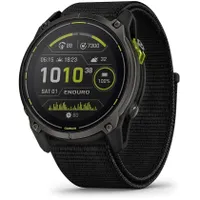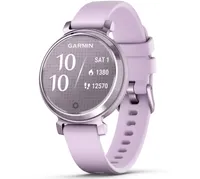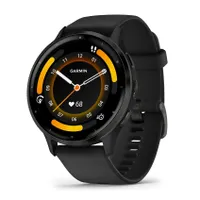Best Garmin watch 2025 tested and rated: Top picks to hit your fitness goals this year
These are the best Garmin watches for runners, hikers, runners, golfers and more
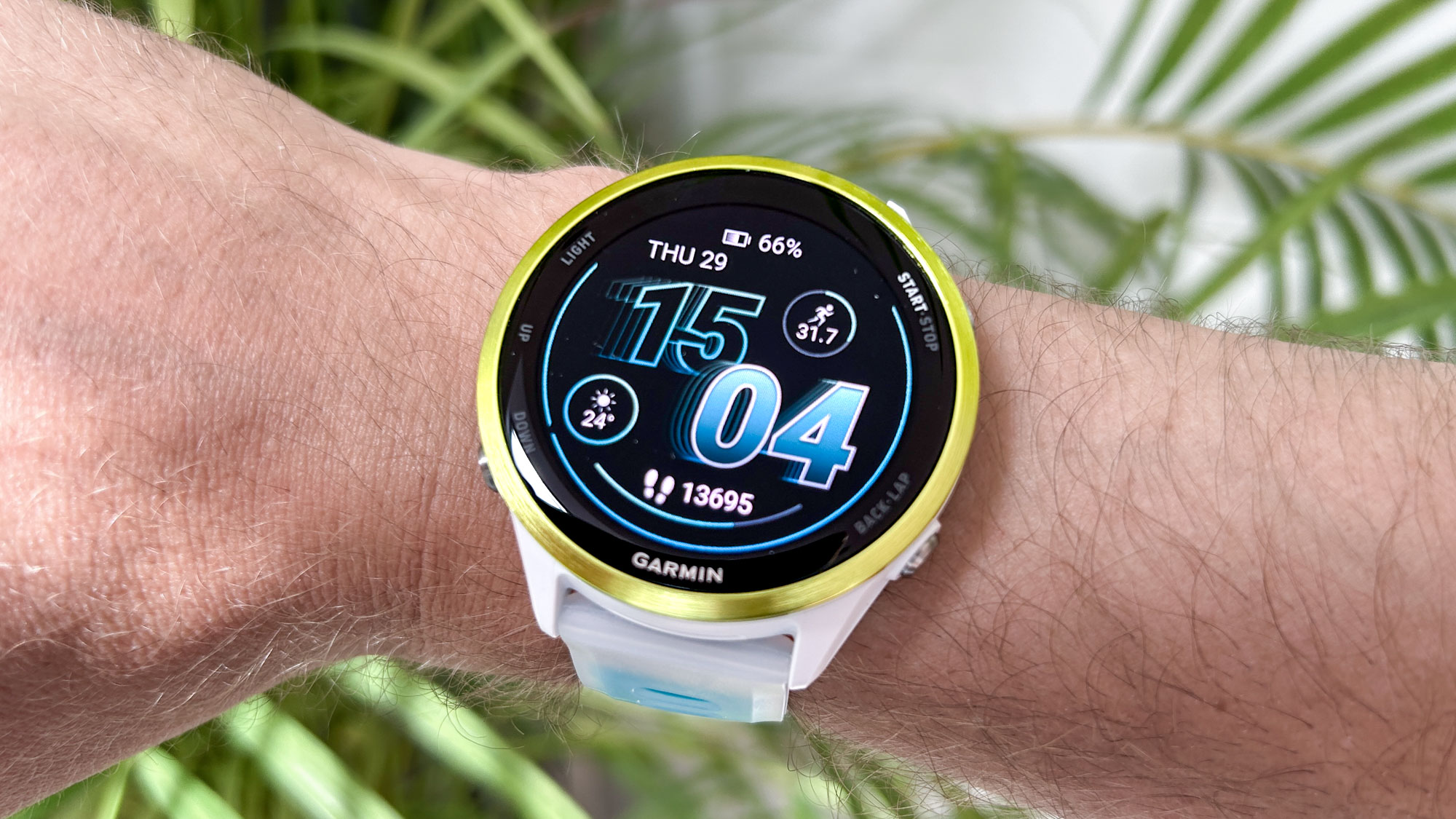
Garmin’s been in the smartwatch game for longer than most — the Apple Watch was but a twinkle in Steve Jobs’ eye when the first Forerunner watch was born — and we’ve been testing the best Garmin watch models for over a decade, witnessing their evolution from basic step and distance trackers to full-blown training, recovery and wellness monitoring devices.
With thousands of hours of testing under our running belts, we’re here to help you make sense of Garmin’s admittedly overwhelming smartwatch lineup. For most, the Garmin Forerunner 570 is at the head of the pack offering a solid mix of training tools, a bright screen, and great battery life in a comfortable and stylish package. If you're a triathlete or runner looking for something even more advanced, then the Garmin Forerunner 970 is the watch for you.
Garmin doesn’t just make devices for runners, though. The Garmin Fenix 8 Pro is the best Garmin watch for adventurers thanks to a super-rugged and waterproof design, LTE and satellite connectivity and a nifty built-in flashlight. But, these aren’t your only options. We’ve also got picks for the budget-conscious, newbie runners, triathletes and even golfers.
The best Garmin watches you can buy today
Why you can trust Tom's Guide
Best Garmin watch for runners
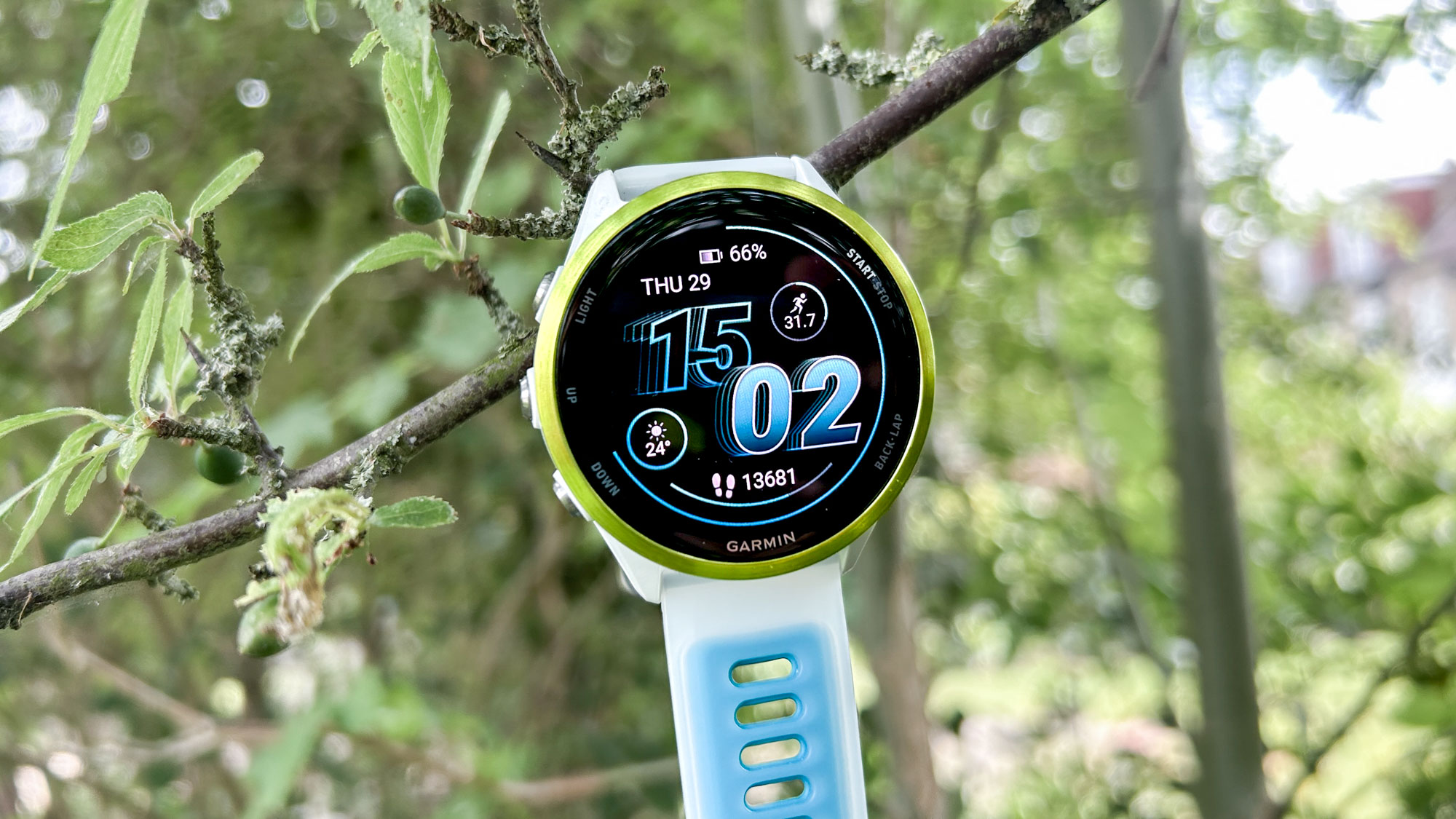
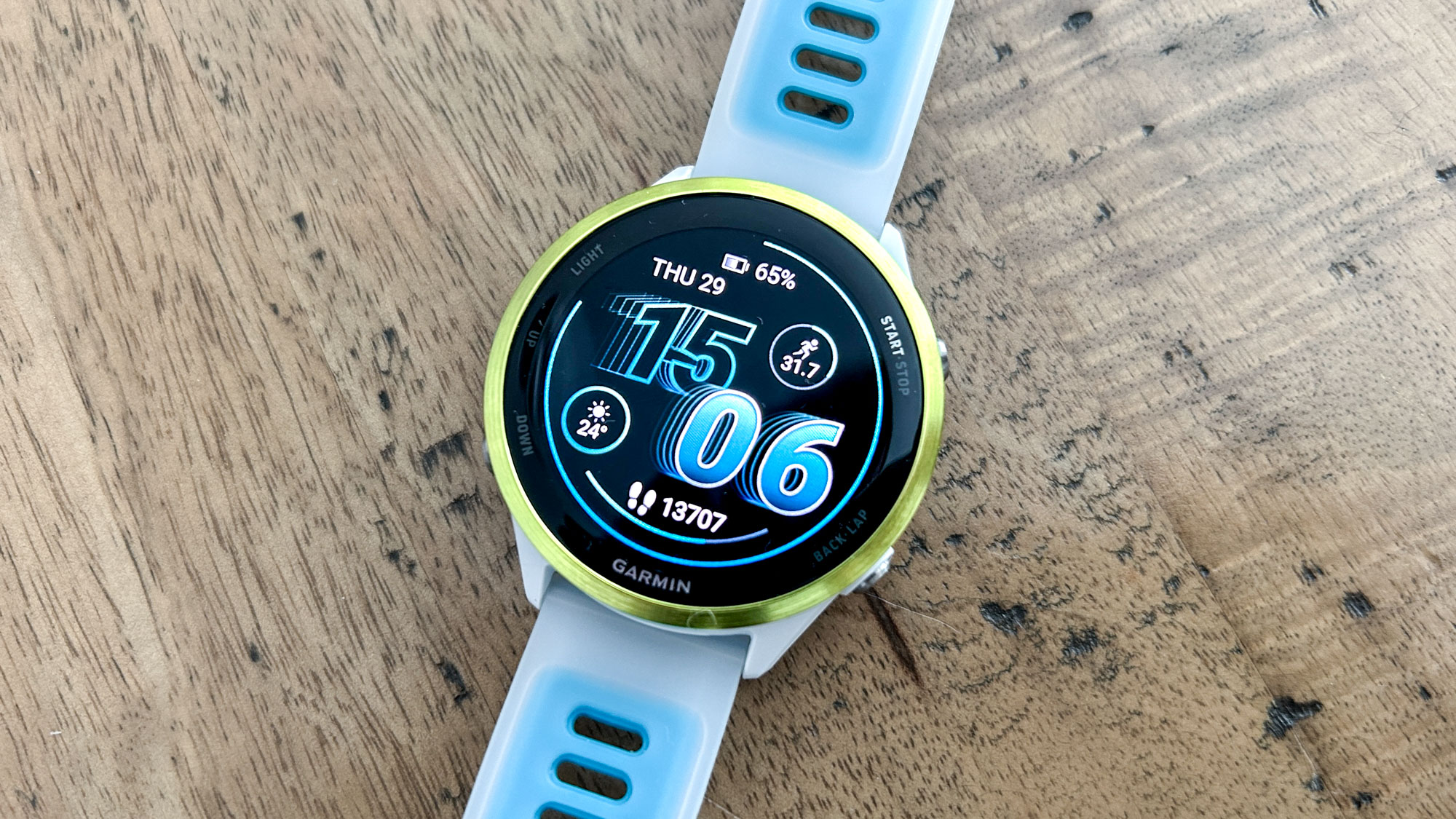
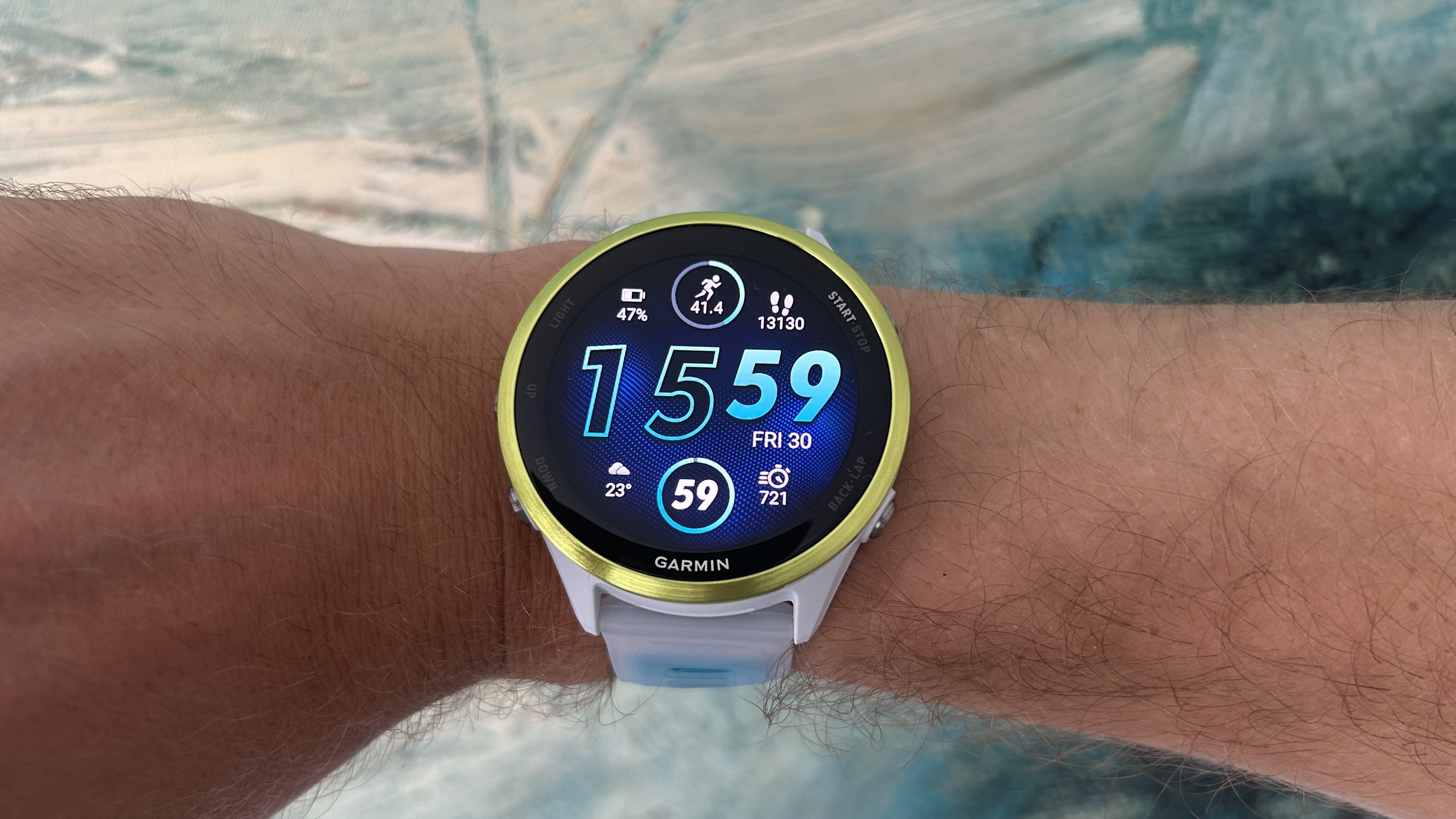
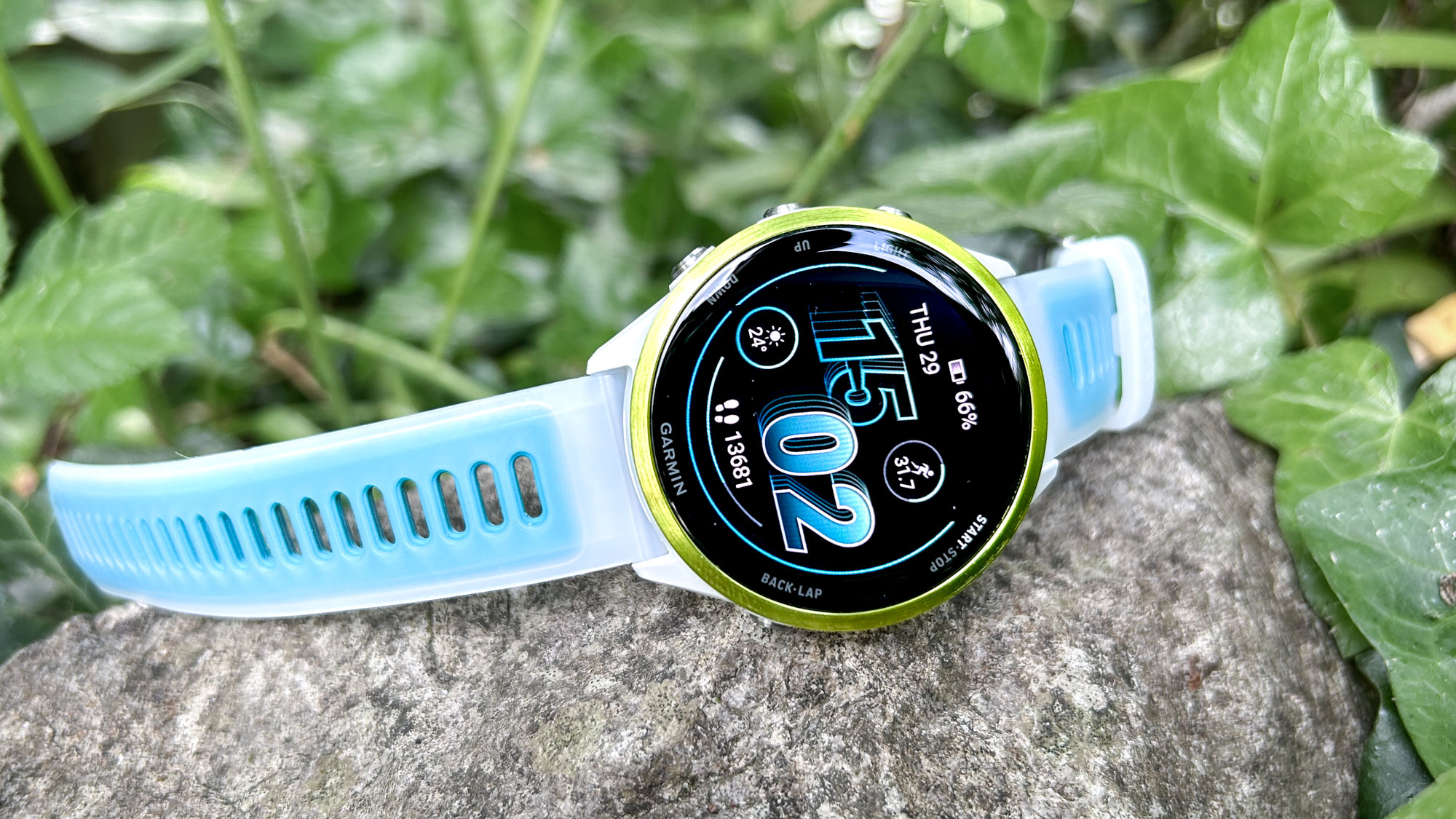
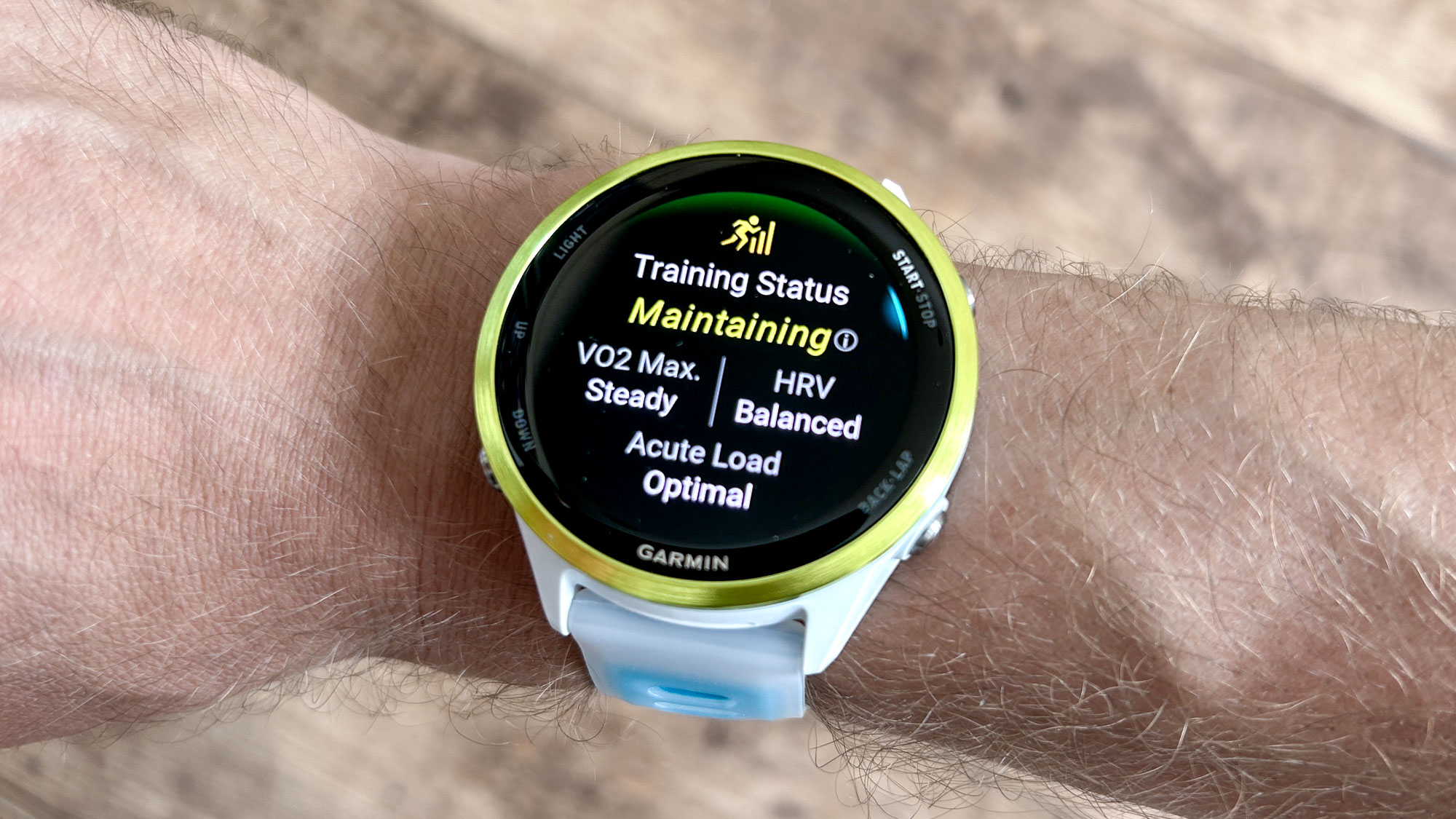
Specifications
Reasons to buy
Reasons to avoid
✅ You love the look: The Forerunner 570 is one of the best-looking sports watches available thanks to its colorful design and bright AMOLED display
✅ You want a mid-range Garmin: Garmin’s top watches cost significantly more than the Forerunner 570, which has most of their key features and is a worthwhile upgrade on entry-level options.
✅ You have slim wrists: Unlike the Forerunner 970 the Forerunner 570 comes in a smaller size, and it’s much lighter on the wrist than models like the Fenix 8 as well.
❌ You need maps: The Forerunner 570 doesn’t offer Garmin’s offline maps and navigation tools, which you get on pricier models like the Forerunner 970.
❌ You need long battery life: Garmin models like the Instinct 3 and Enduro 3 offer far longer battery life than the Forerunner 570.
❌ You don’t care about the new design: If you’re not that fussed about the looks, the older Forerunner 265 or Forerunner 965 watches are better value than the Forerunner 570, especially in sales.
⌚ The Garmin Forerunner 570 is a gorgeous watch and a fantastic sports tracker that offers a more affordable option than the top models in the brand’s range while still having all the features runners need.
What you need to know
The Garmin Forerunner 570 sits in the middle of Garmin’s range, offering more features than the Forerunner 165 but not quite as many as the Forerunner 970. It’s the replacement for the Forerunner 265, and offers design improvements in particular.
It has a dazzling AMOLED display and comes in a wider range of colors than we usually see from Garmin, including watches with eye-catching yellow and pink bezels. It comes in two sizes — 42mm and 47mm — and offers runners everything they need to track and analyze their training.
While you miss out on some features available on pricier Garmins like the Forerunner 970, like maps and running economy measurements, the Forerunner 570 has everything you need to run marathons and beyond, all in an attractive and lightweight package.
Design: There are three colors available of each size of the Forerunner 570, with the blue and yellow model I tested being the standout in my opinion, though there are all-black watches for those who prefer a more understated look. The watch has a 1.4in AMOLED display, which is as large a screen as you’ll find on any Garmin sports watch aside from the Venu X1, and it’s bright enough to be clear in all conditions even on the lowest brightness setting.
Battery life: The big, bright display on the Forerunner 570 does reduce its battery life compared with other Garmins, and it only lasted me three to four days on a charge with the screen set to always-on. You can boost this battery life by using the raise-to-wake setting, and you get 14 hours of multi-band GPS tracking with the larger Forerunner 570 model.
Training features: The Forerunner 570 is full of useful training features for runners and other athletes. That starts with reliably accurate GPS and heart rate tracking, with the multi-band GPS setting and Elevate v5 heart rate sensor matching anything on the market with their precision.
You also get detailed training insights including VO2 max estimates, race time predictions, training load analysis and advice on how well acclimated to heat and altitude you are. The Forerunner 570 also has Garmin’s Training Readiness feature, which rates how ready to train you are each day.
Read the full review: Garmin Forerunner 570
Test | Notes | How it stacks up |
|---|---|---|
Battery life | 10-11 days/ smartwatch, 18 hours GPS | ★★★★☆ |
Features | Multisport mode, Body Battery, Training Readiness Score, Race day widget, Suggested workouts, LiveTrack | ★★★★☆ |
Design | 1.2-inches (265S), 1.4-inches (265) | ★★★★★ |
Display | 454 x 454 pixels (47mm), 390 x 390 pixels (42mm) AMOLED touchscreen | ★★★★★ |
Best budget Garmin watch
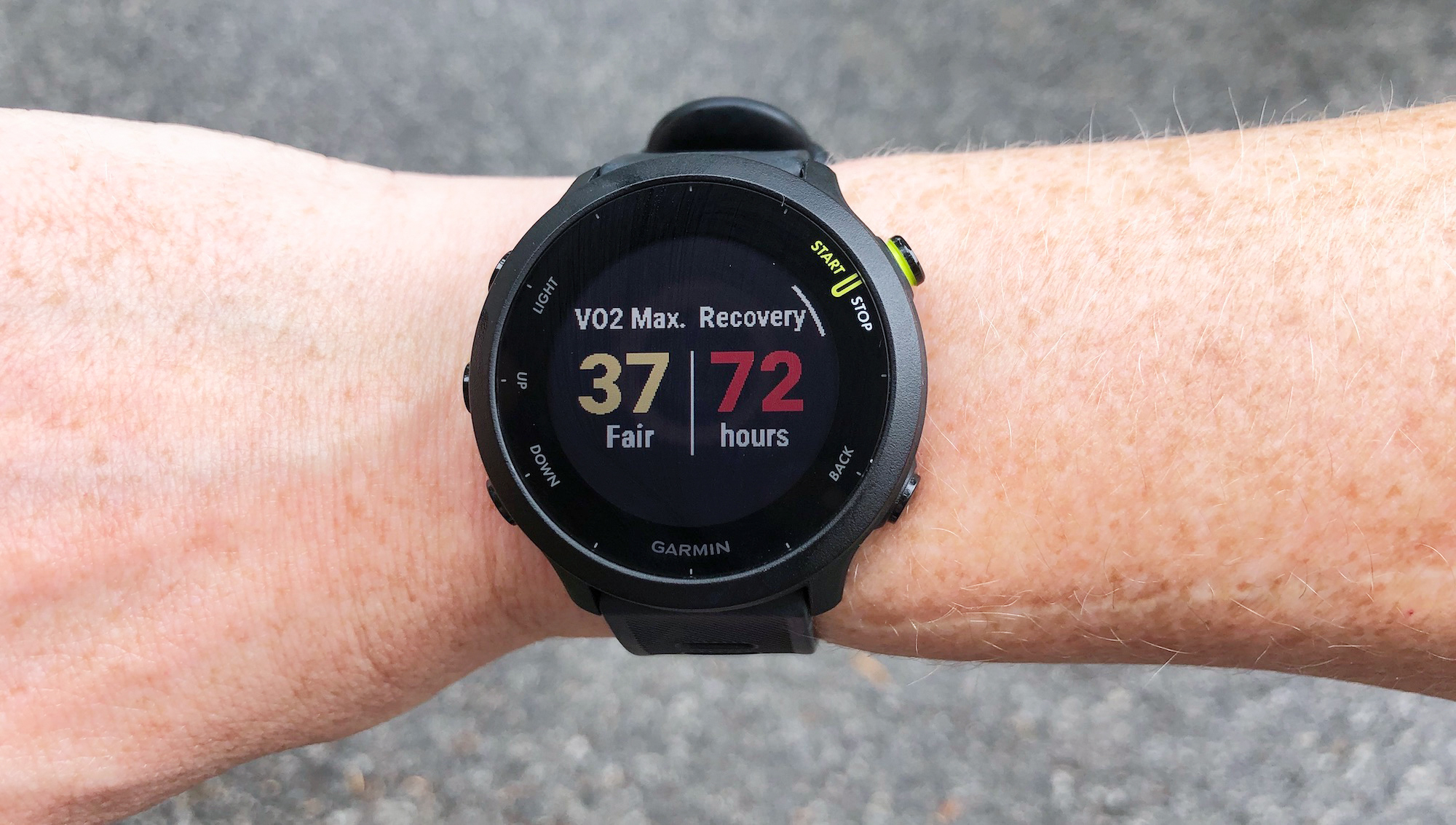
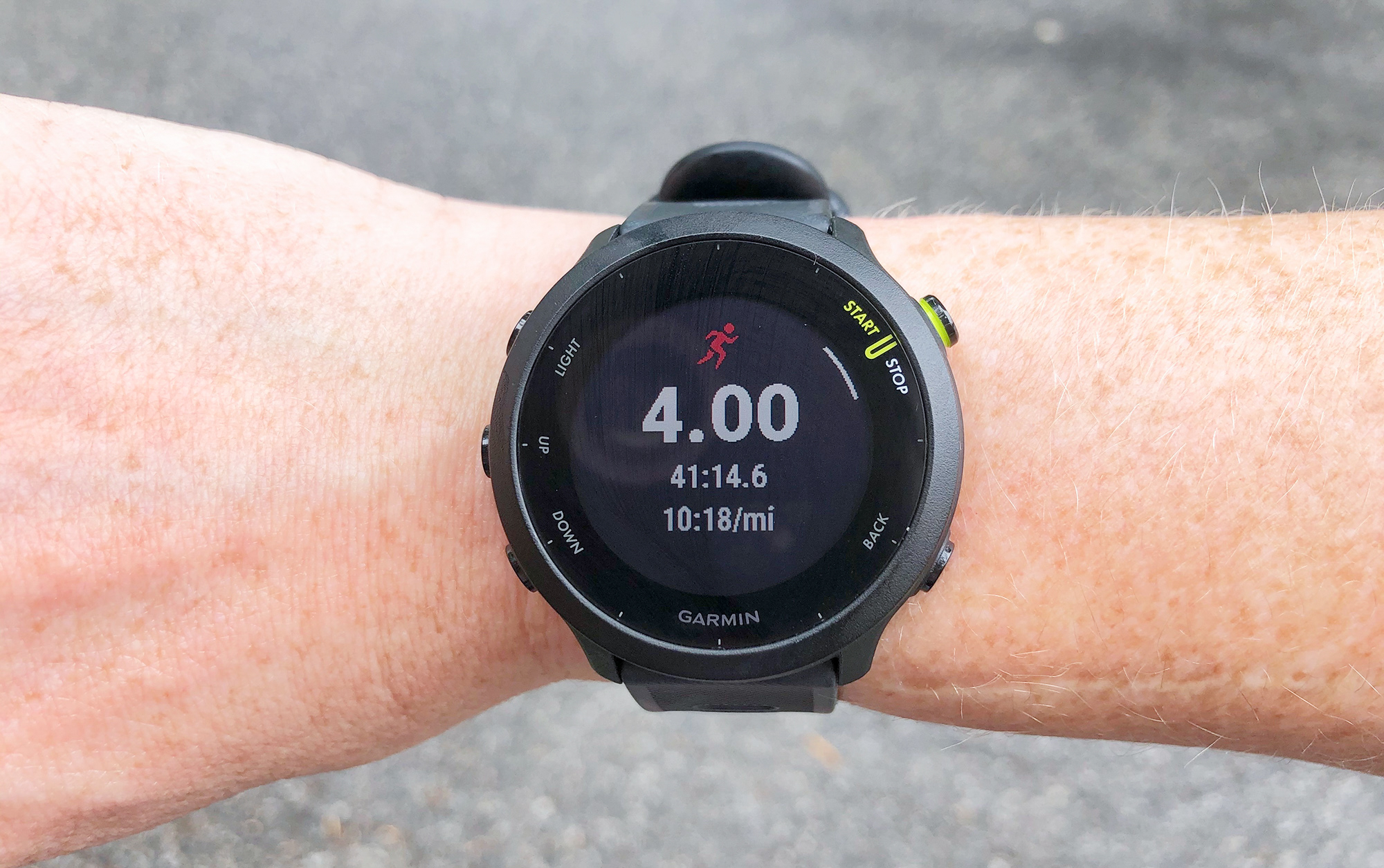
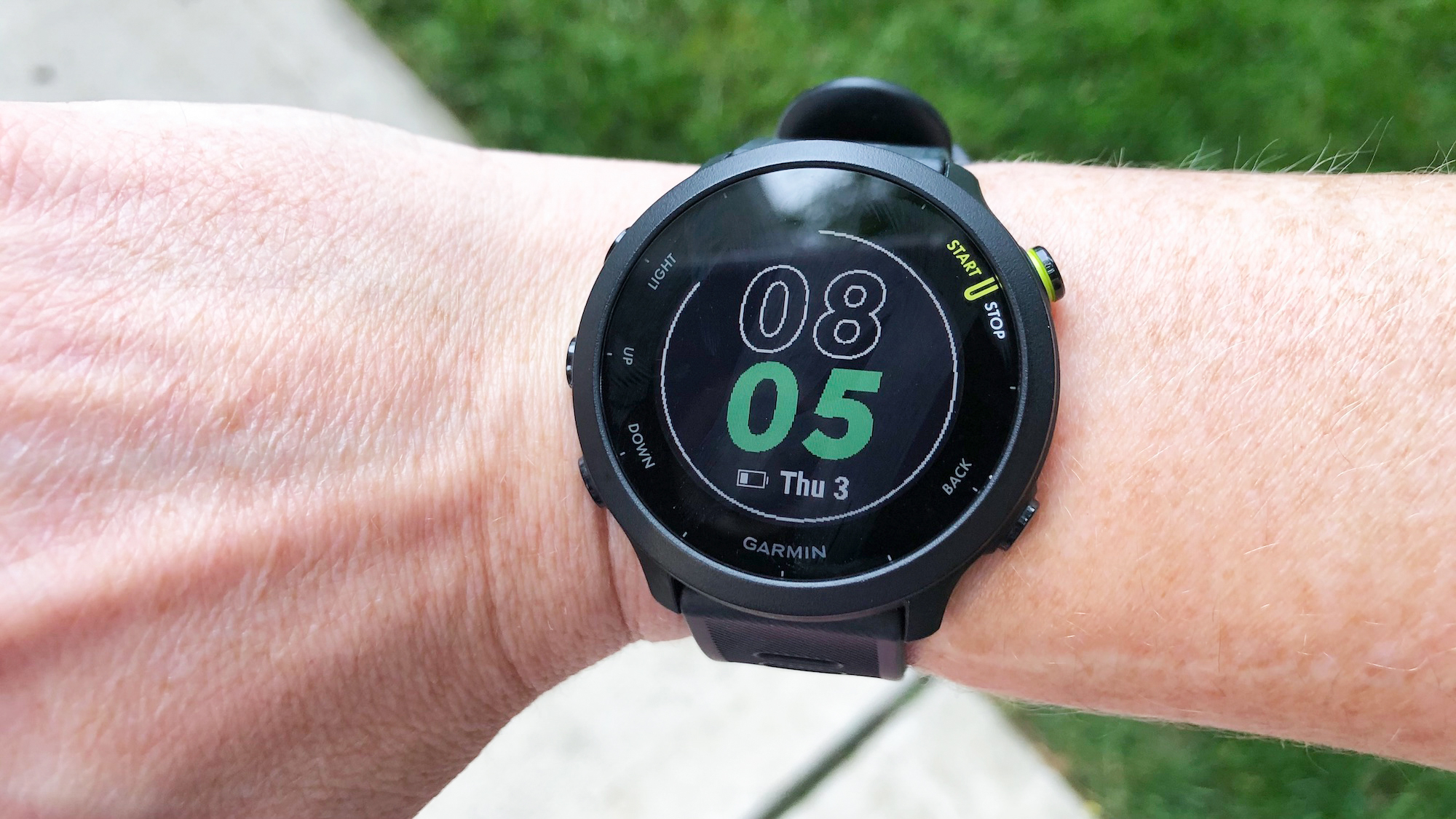
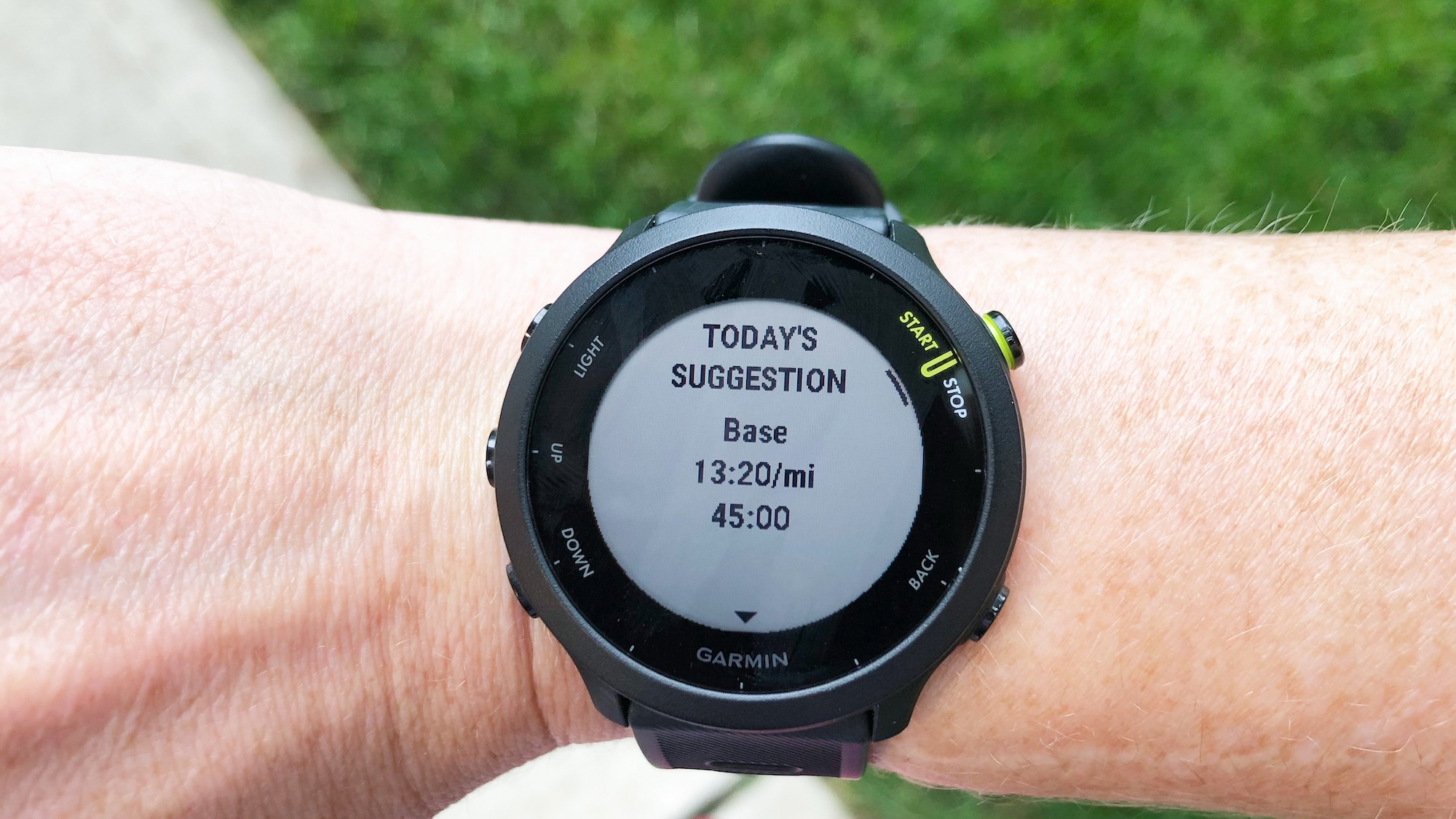
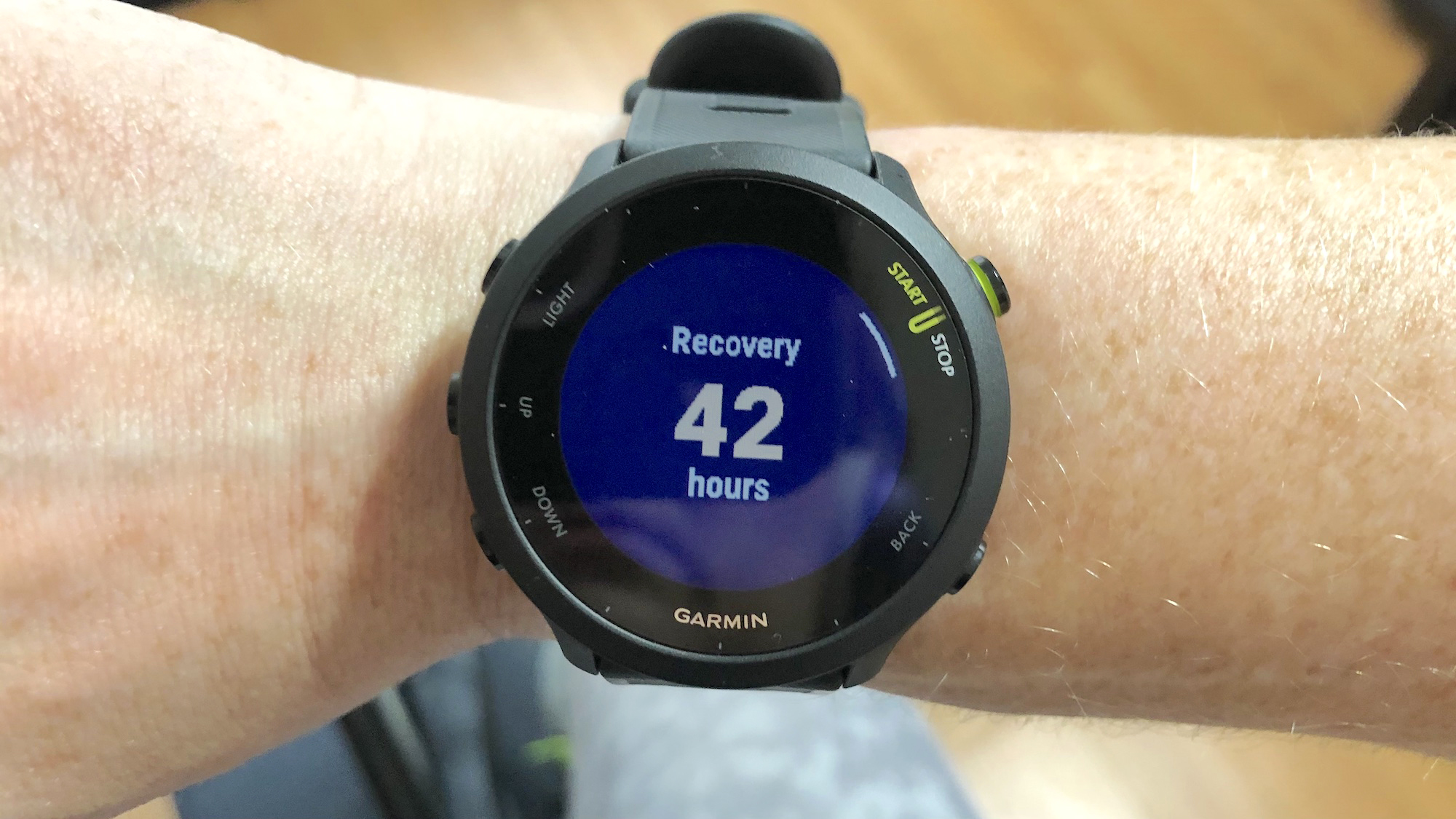
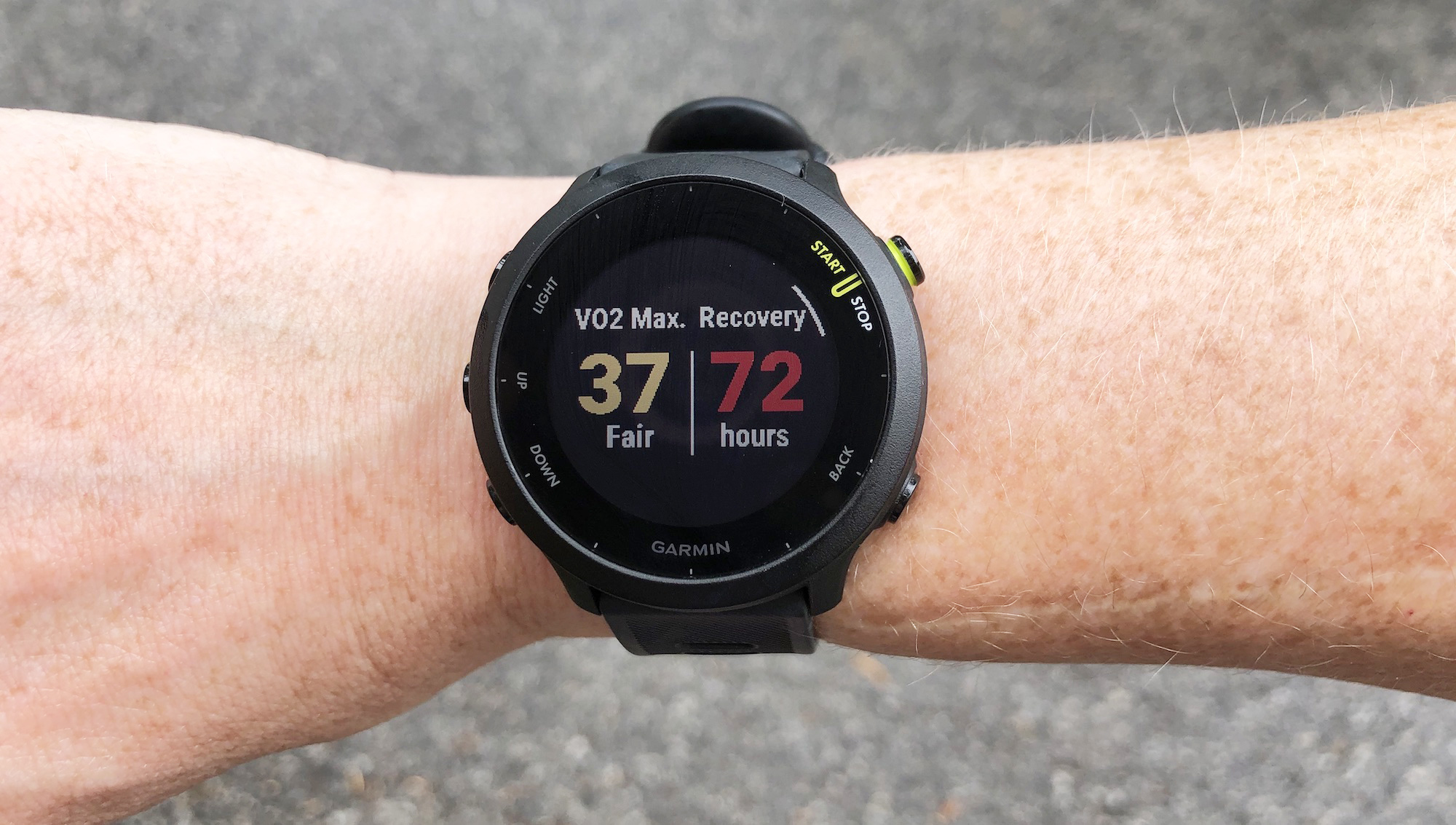
Specifications
Reasons to buy
Reasons to avoid
✅ You're looking for an entry-level watch: The Garmin Forerunner 55 is an excellent watch if you want to keep an eye on your running training and sleep, without all the extra bells and whistles. It's simple, and easy to use.
✅ You're on a budget: Unlike some of the other watches on this list, the Forerunner 55 won't cost you a month's rent. It's definitely the most affordable Garmin for runners.
❌ You want to listen to music from your watch: There's no built-in music storage on the watch, so if you want to leave your phone at home, you won't be able to here.
❌ You want to record strength workouts: There's no strength training mode on the Forerunner 55, so you'll have to record strength workouts as 'Other'.
❌ You want to make contactless payments from your wrist: Unlike other watches on this list, the Forerunner 55 doesn't support Garmin Pay contactless payments.
⌚ The Garmin Forerunner 55 is a basic running watch that definitely isn't to be sniffed at. Sure, it doesn't have Training Readiness or Garmin Pay, but it'll give you suggested workouts, connect with Garmin Coach, and let you get a better idea of how well you're sleeping.
What you need to know
If you’re starting to get into running, chances are you want a device that’s a step up from a basic fitness tracker and won't break the bank. Among Garmin watches, the Forerunner 55 is a clear choice. It's a simple, easy-to-use running watch that'll help you keep an eye on your running stats, heart rate and sleep from your wrist.
The watch doesn't have some of the high-end training features you'll see in other watches on this list. There's no Training Readiness Score, for example, and the watch doesn't let you listen to music, or pay for groceries from your wrist, but don't let this put you off.
Design: The Forerunner 55 looks like most of the other Forerunners in the Garmin collection — it doesn't have a touchscreen, so you'll need to navigate around the watch using the buttons, three on the left and two on the right. The watch only comes in one size and has a 1-inch, MIP display, with a resolution of 208 x 208 pixels. However, even on the sunniest days, we could see the Forerunner 55’s transflective MIP display without an issue. But, if you're worried, consider the Garmin Forerunner 165 instead.
Battery life: A fully charged Forerunner 55 can last up to two weeks in smartwatch mode and 20 hours in GPS mode, a significant increase from its predecessor. This is especially impressive compared to the latest Apple Watch Series 9. However, the screen on the Forerunner 55 isn't anywhere near as bright as Apple's smartwatch. Either way, you could go away for a weekend marathon without worrying about packing your charger.
Training features: The Forerunner 55 has Garmin's PacePro technology, which gives you gentle speed and cadence alerts on the run. There are also suggested recovery times and workouts, based on your training history, fitness levels and recovery.
Like most of the watches on this list, you can also use Garmin Coach on this watch, which lets you download free training plans from one of Garmin's coaches.
Read our full review: Garmin Forerunner 55
Test | Notes | How it stacks up |
|---|---|---|
Battery life | 2 weeks smartwatch/ 20 hours GPS | ★★★★☆ |
Features | Garmin Coach, Pace Pro, Cadence alerts | ★★★☆☆ |
Design | 1-inch screen | ★★★☆☆ |
Display | 208 x 208 pixels MIP display | ★★★☆☆ |
Best Garmin for beginners
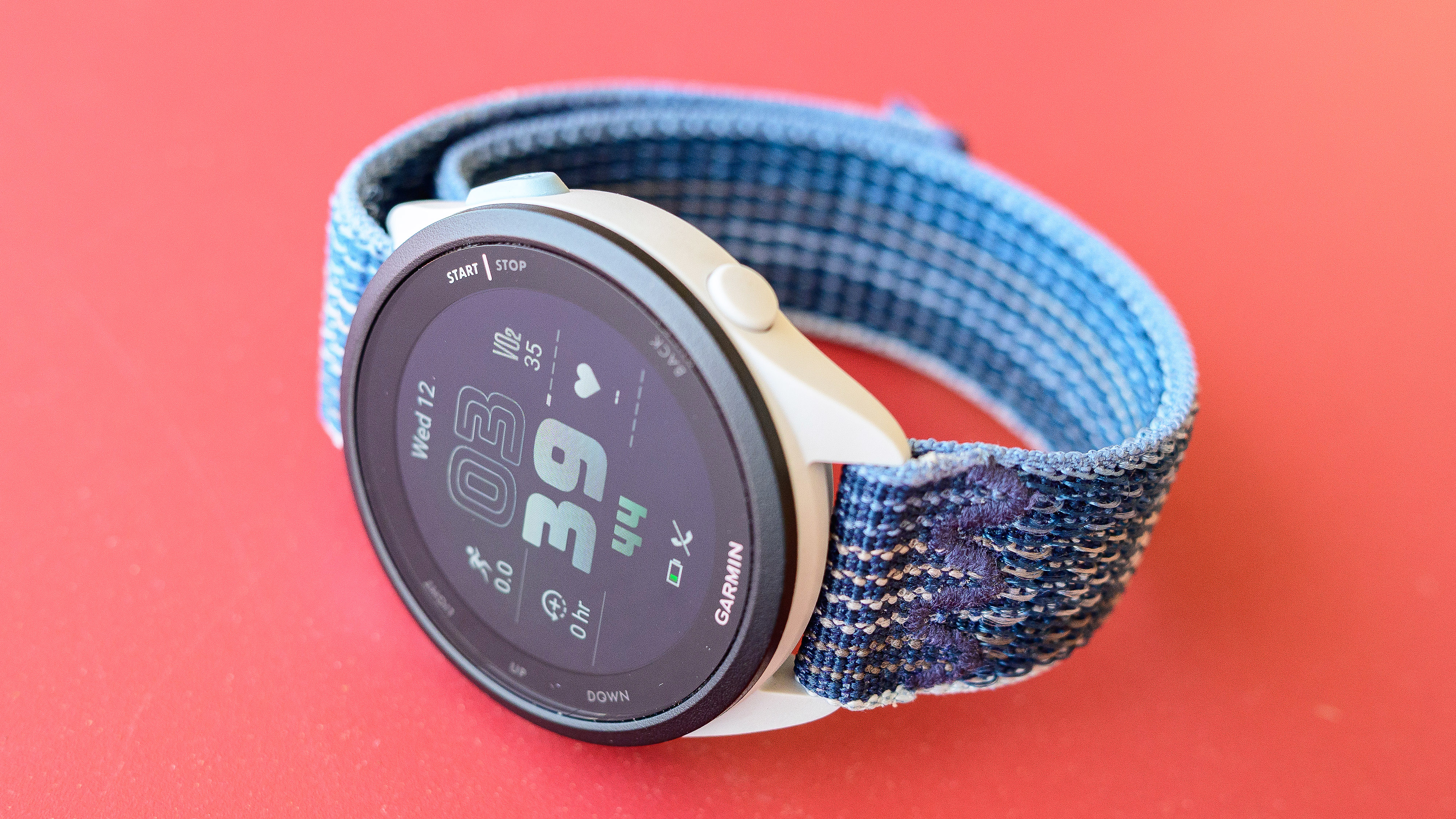
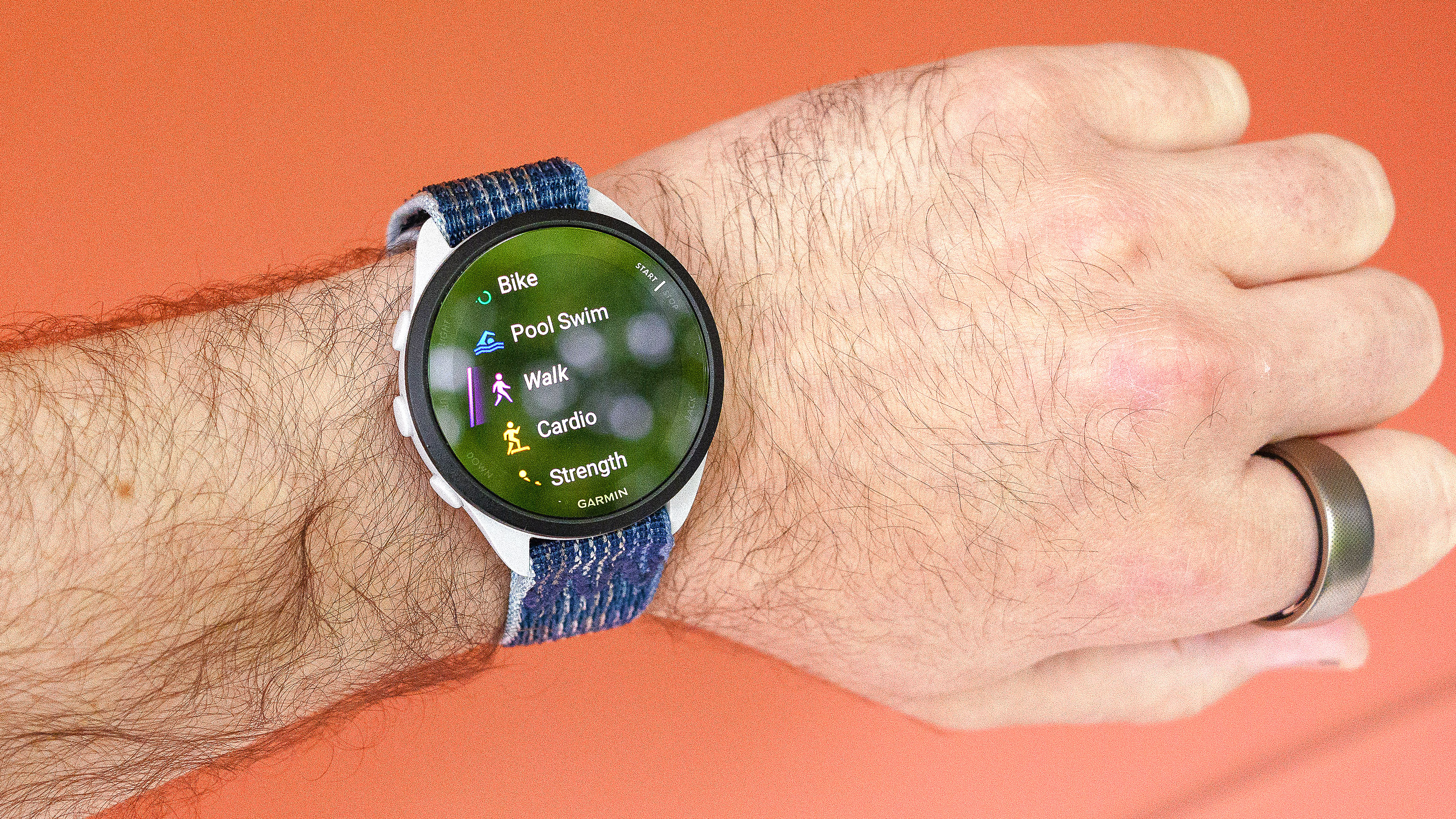
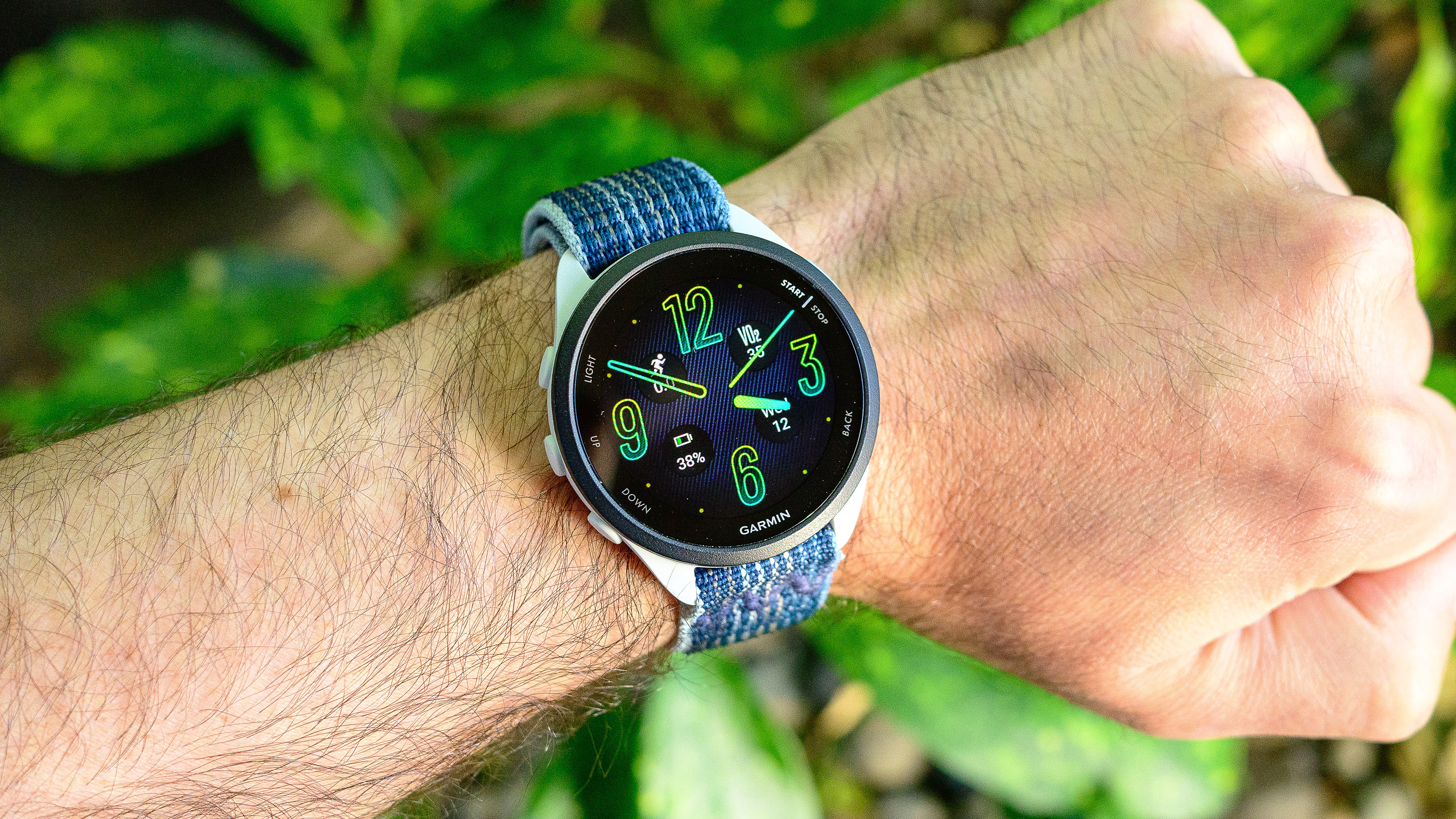
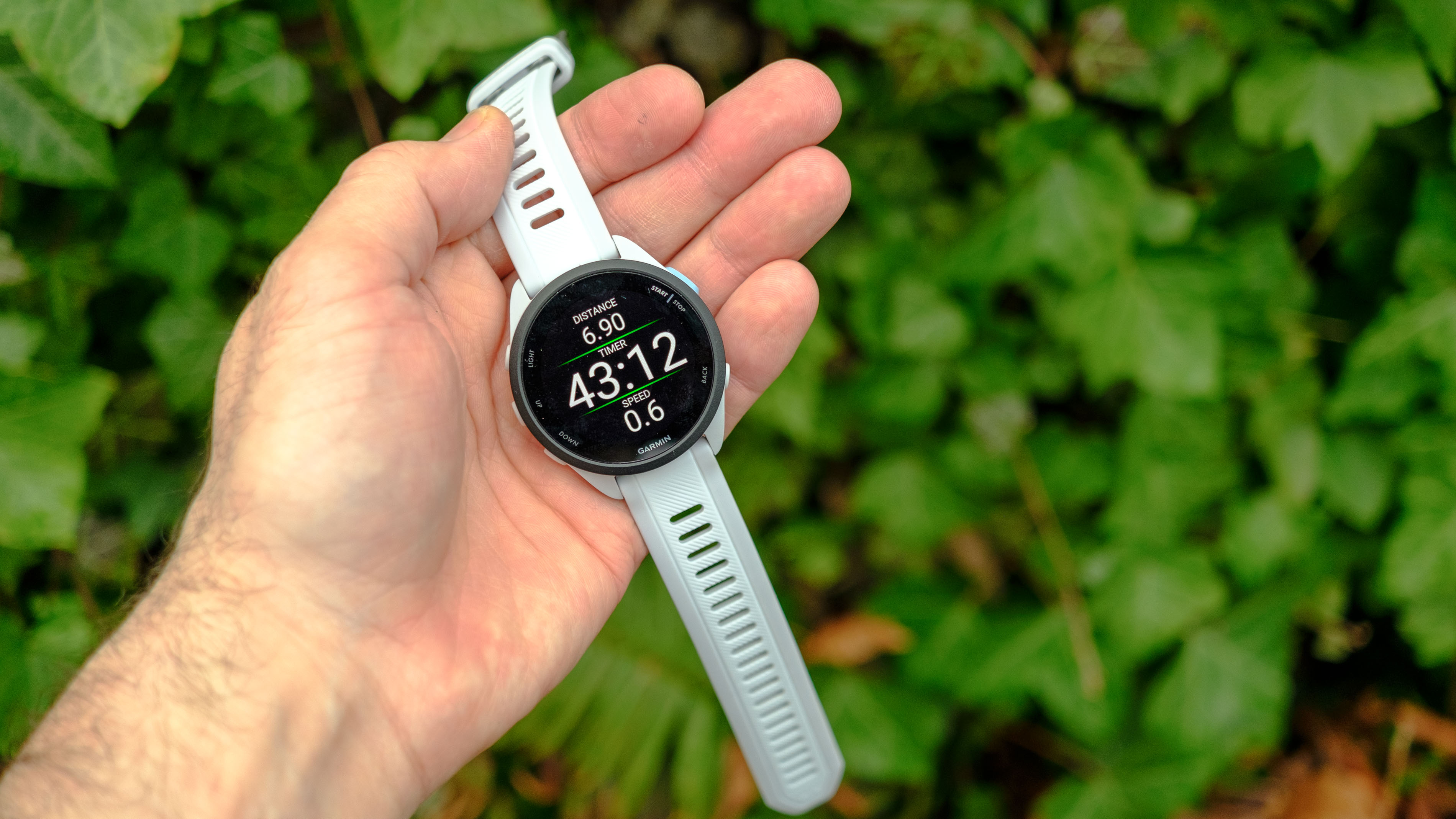
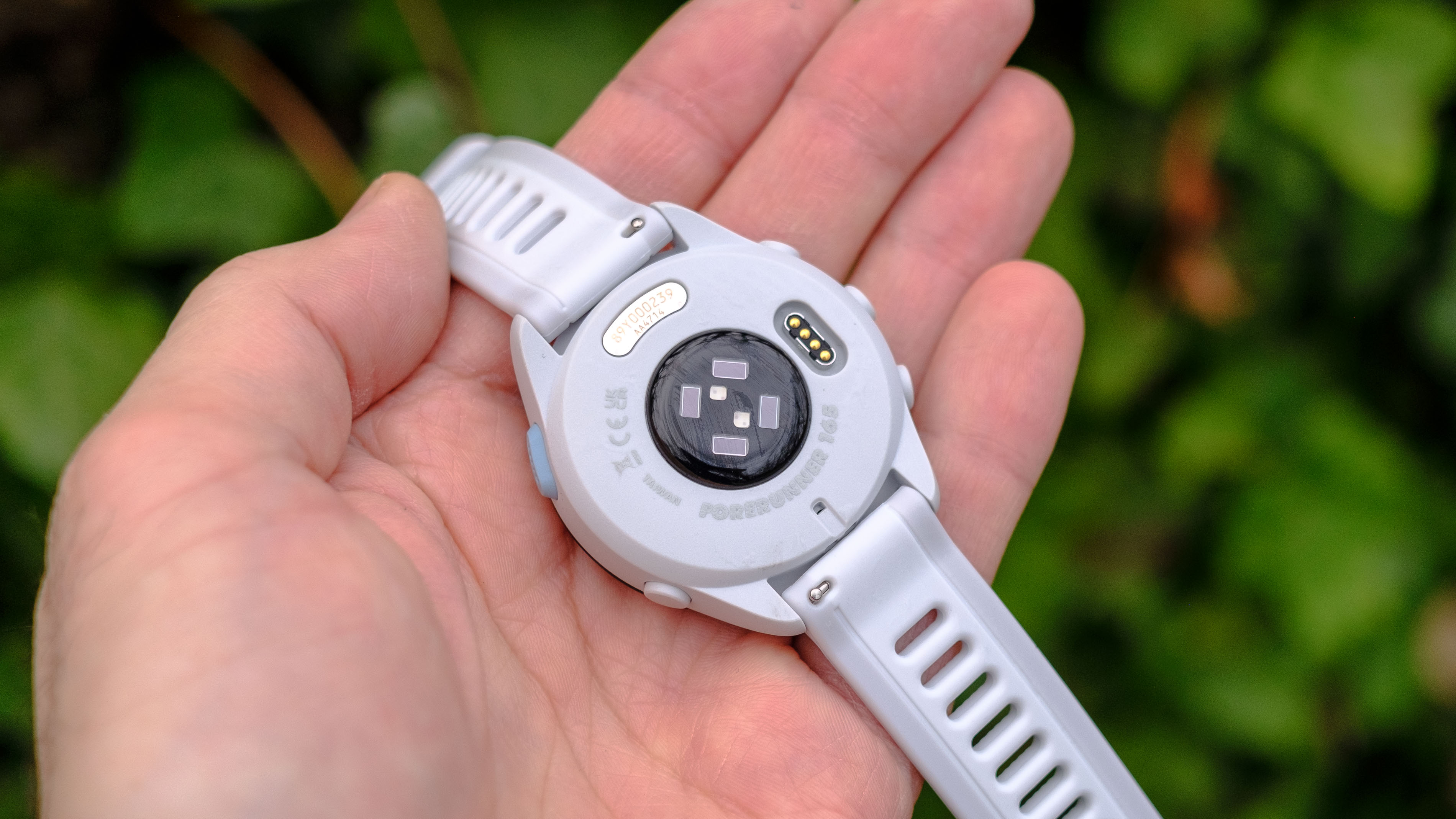
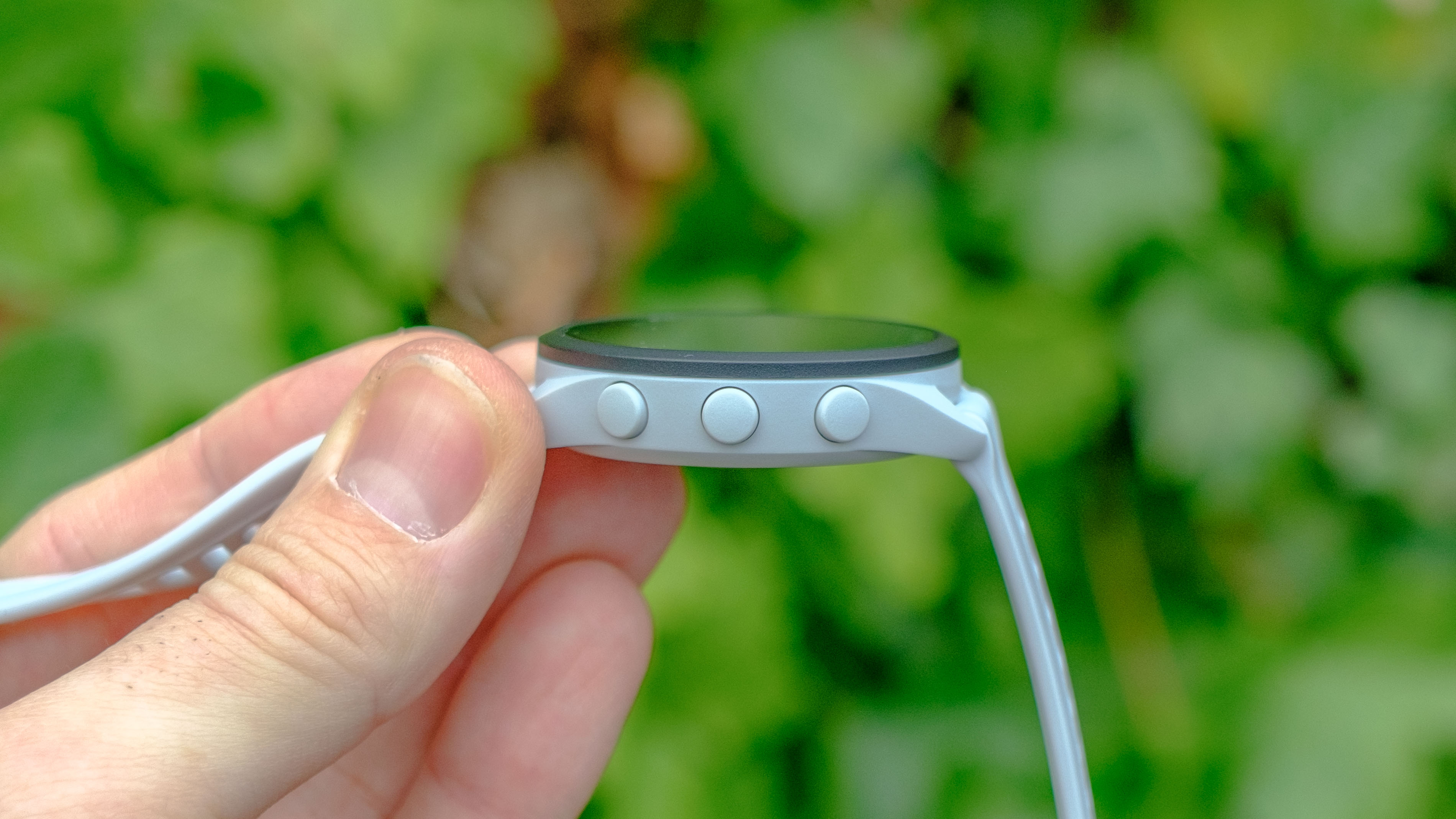
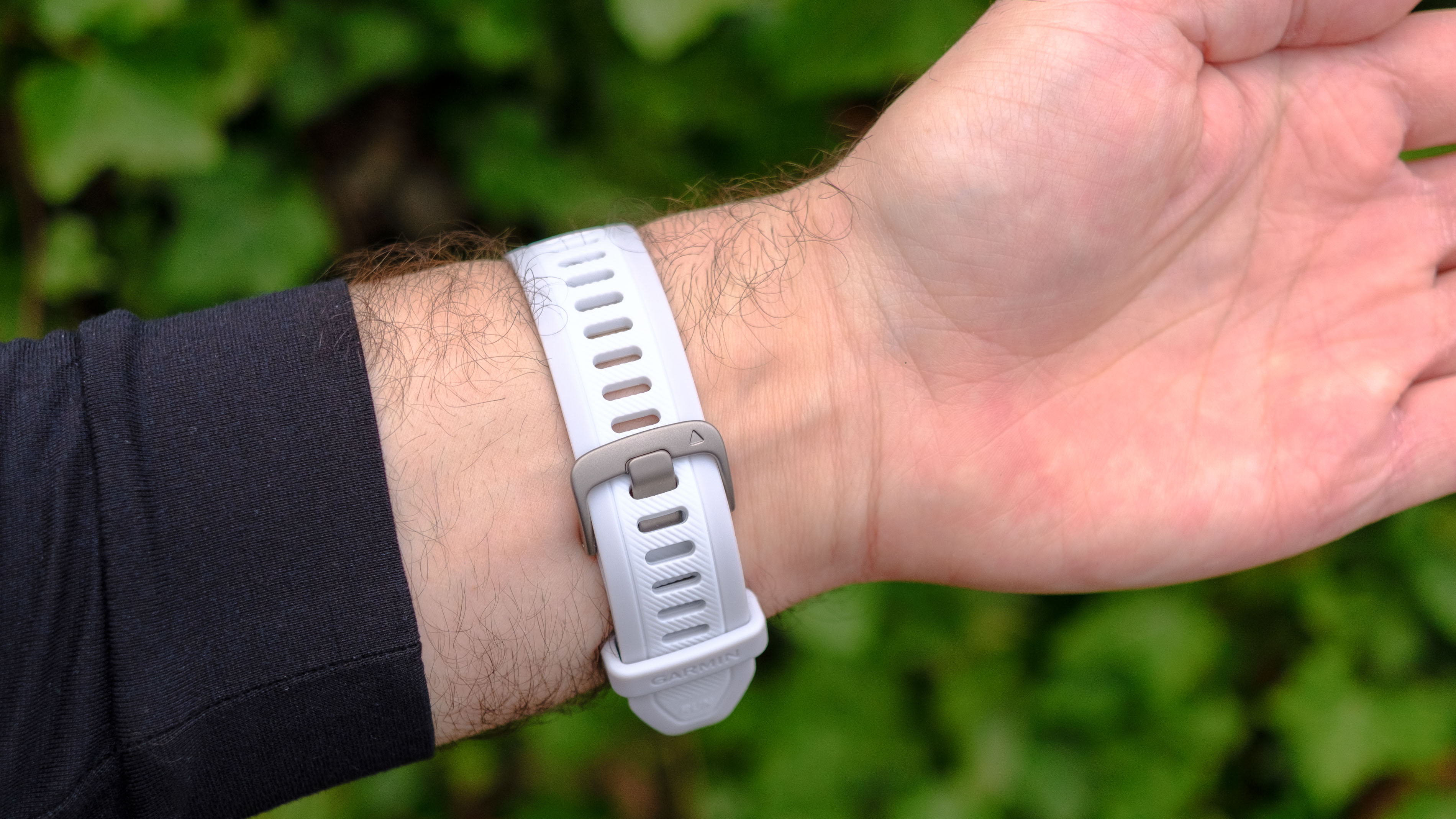
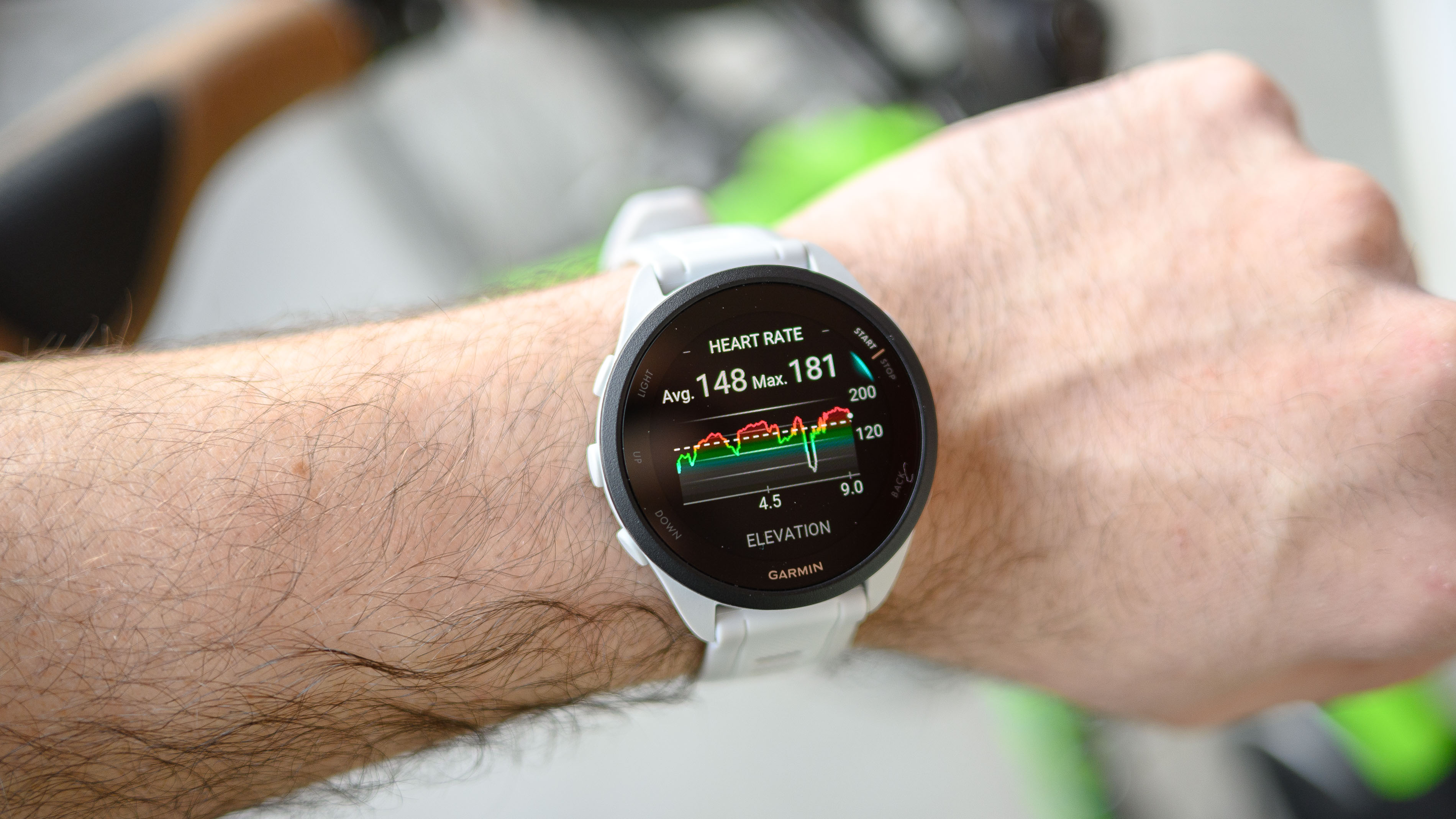
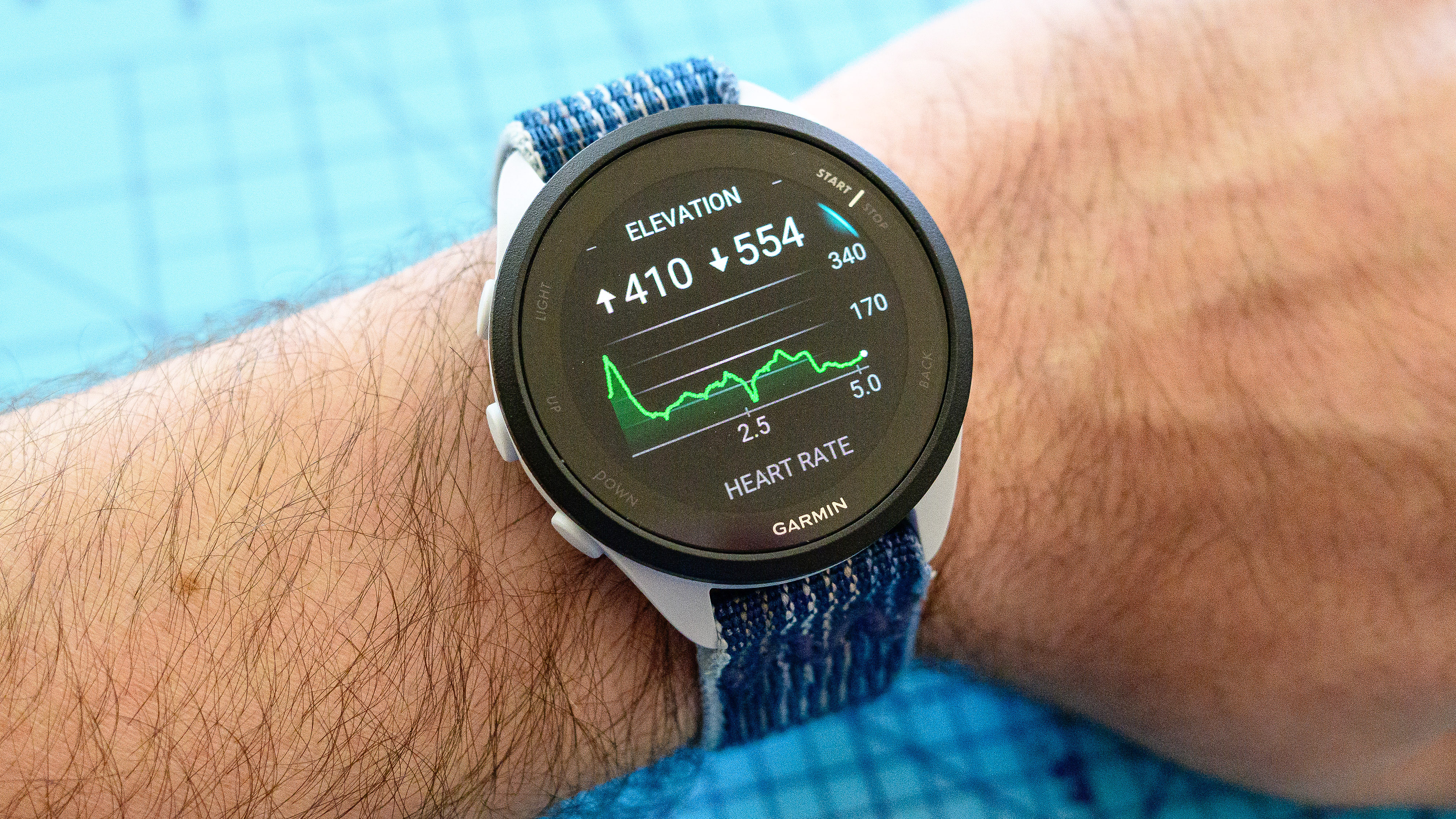
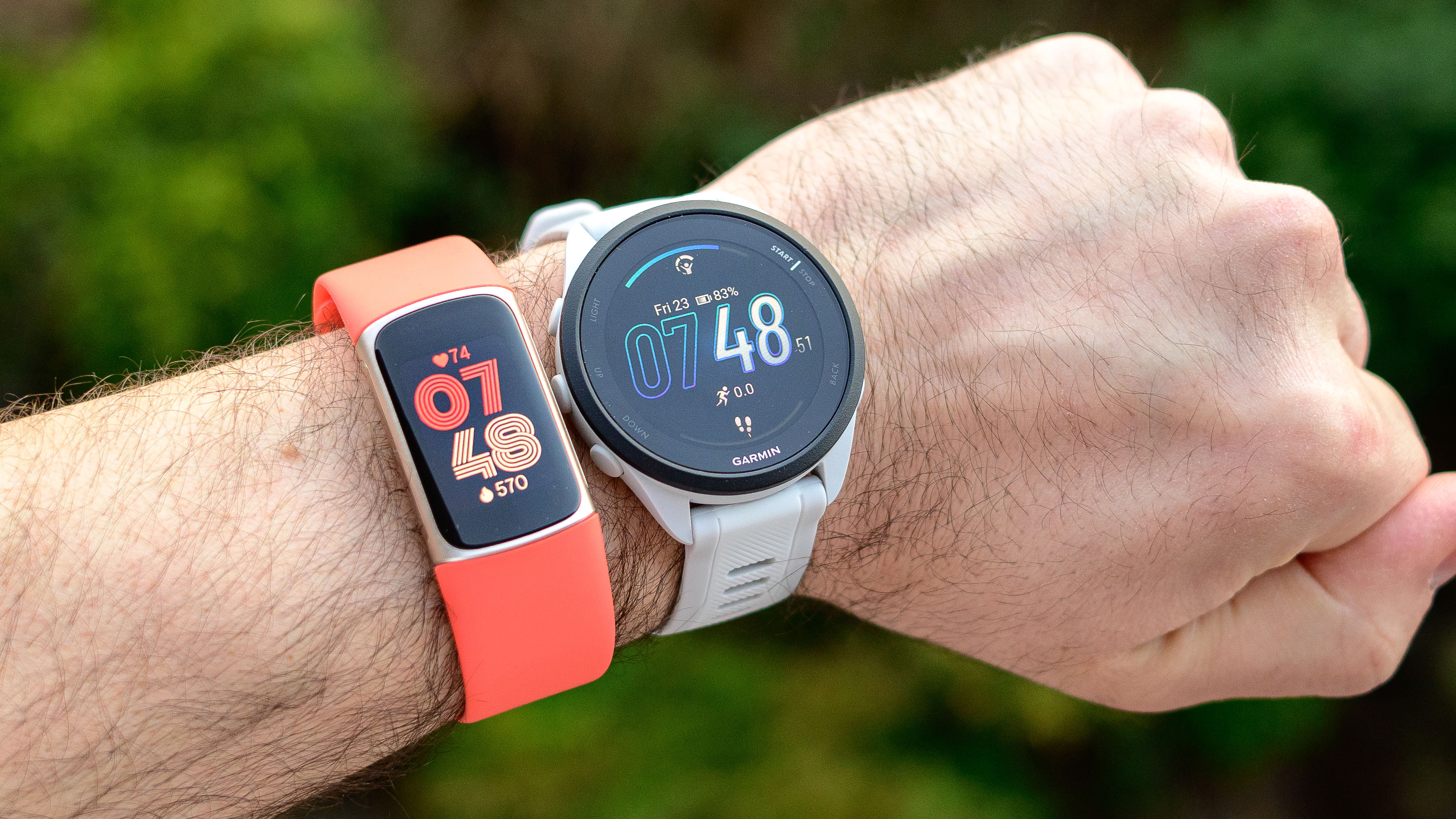
Specifications
Reasons to buy
Reasons to avoid
✅ You want an affordable watch with a bright screen: The Forerunner 165 boasts a lovely ALMOED screen that's easy to view in bright daylight
✅ Physical buttons make you happy: In addition to a touchscreen the Forerunner 165 features five tactile buttons around its case, making the device a breeze to operate, even with sweaty hands.
✅ You want insights into training and recovery: The Forerunner 165 inherits many of Garmin's best training features from higher-end models like Training Effect, Body Battery and recovery time suggestions.
❌ You want a smartwatch with the most smart features: The Forerunner 165 has lots of tools for recording activities and reaching fitness goals, but it doesn't have many smart ones.
❌ You want to track multi-sport activities: Triathletes will need to step up to a higher-end Forerunner model to track complex multi-sport activities. Consider the Forerunner 965 instead.
⌚ The Garmin Forerunner 165 is a comfortable and lightweight GPS smartwatch with a bright AMOLED touchscreen, lots of physical controls, satisfactory battery life, precise health sensors and advanced training tools borrowed from higher-end Garmin wearables.
What you need to know
The Garmin Forerunner 165 is the entry-level Forerunner in Garmin's range for those who want an AMOLED display. Despite not having the extensive features you'll find on pricier Forerunners, the 165 is a great option for runners and other athletes just getting into their sport.
Lightweight and comfortable to wear for extended periods, the Forerunner 165 boasts a bright AMOLED touchscreen that's highly visible, even in direct sunlight, a five-button design for easy navigation and accurate GPS tracking.
Battery life when using the GPS is good for up to 19 hours, more than enough for even the most challenging day hikes. Plus, the 165 keeps tabs on sleep, recovery, menstrual health and stress. It can also automatically alert emergency personnel if you fall while out on the trail.
Design:
The Forerunner 165 shares nearly the same design as the Forerunner 265 with three buttons along the left side of the case and two on the right. The 1.2-inch AMOLED touchscreen has a resolution of 390 x 390 pixels and is noticeably higher quality than the screen on the Forerunner 55. Water resistance is 50 meters, which is more than enough to survive sweat, splashes and short submersions.
Battery life:
With a full charge, which takes roughly two hours, the Forerunner 165 has enough juice in smartwatch mode to last roughly 11 days or 19 hours using the GPS to track a hike, walk, run or bike ride. This is a bit less than both the Forerunner 55 and 265 but still respectable. When using a mix of smartwatch mode and GPS tracking, you can expect it to last roughly one week.
Training features:
The Forerunner 165 has a lot of Garmin's best training and recovery features. For runners, PacePro can assist you in maintaining an ideal cadence. Body Battery is another useful tool that can help inform daily workout plans. Speaking of which, the Forerunner 165 provides workout suggestions, along with recommendations for post-workout recovery times, insights into sleep quality, stress and overall well-being.
Read the full review: Garmin Forerunner 165
Test | Notes | How it stacks up |
|---|---|---|
Battery life | 11 days (smartwatch), 19 hours (GPS) | ★★★☆☆ |
Features | Workout suggestions, Live Track, Incident Detection, Body Battery, Training Effect, Sleep tracking | ★★★★☆ |
Design | 1.2-inch case with five physical buttons and 50 meters of water resistance | ★★★★☆ |
Display | 390 x 390 pixels AMOLED touchscreen | ★★★★★ |
Best Garmin watch for triathlons
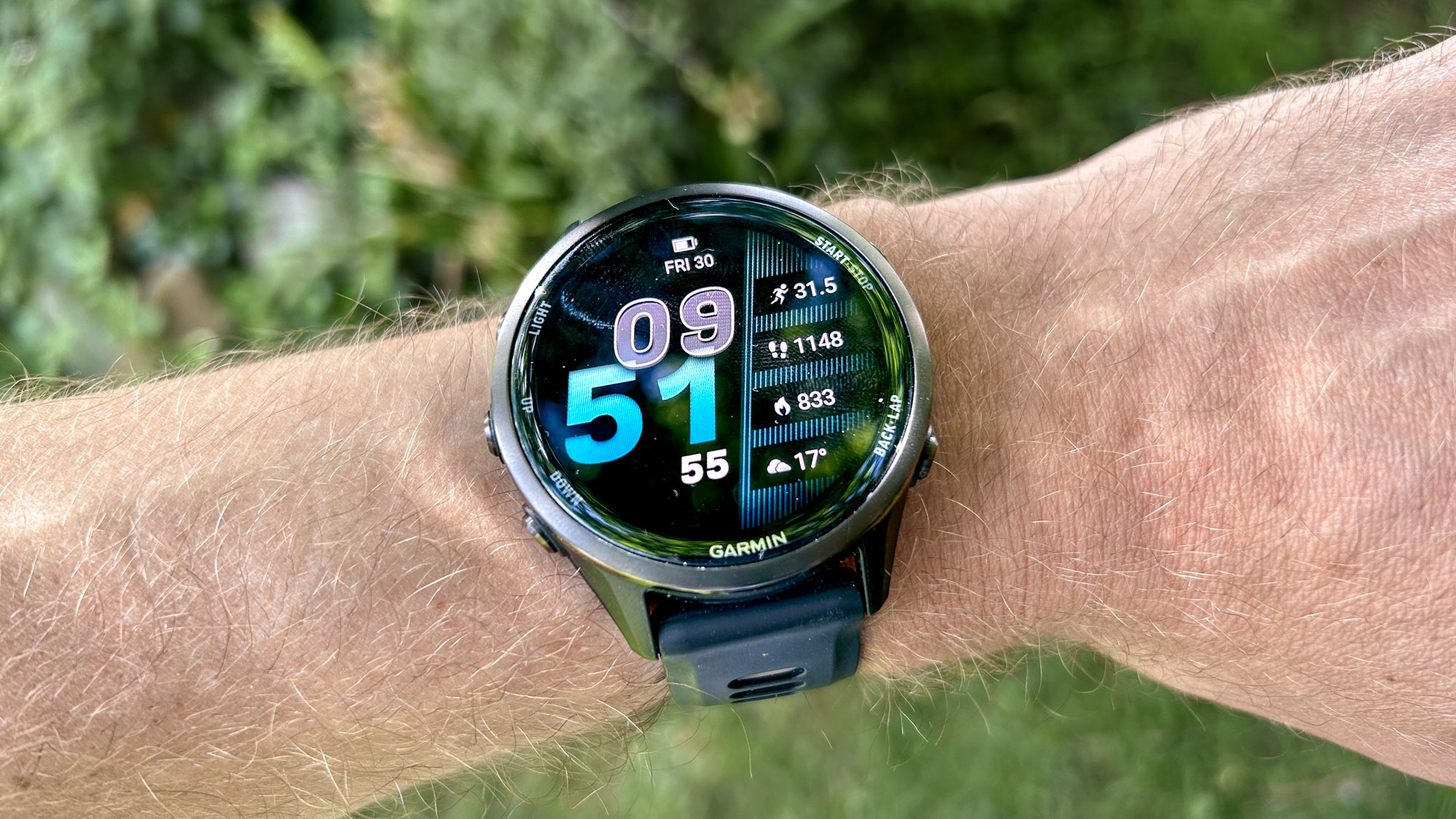
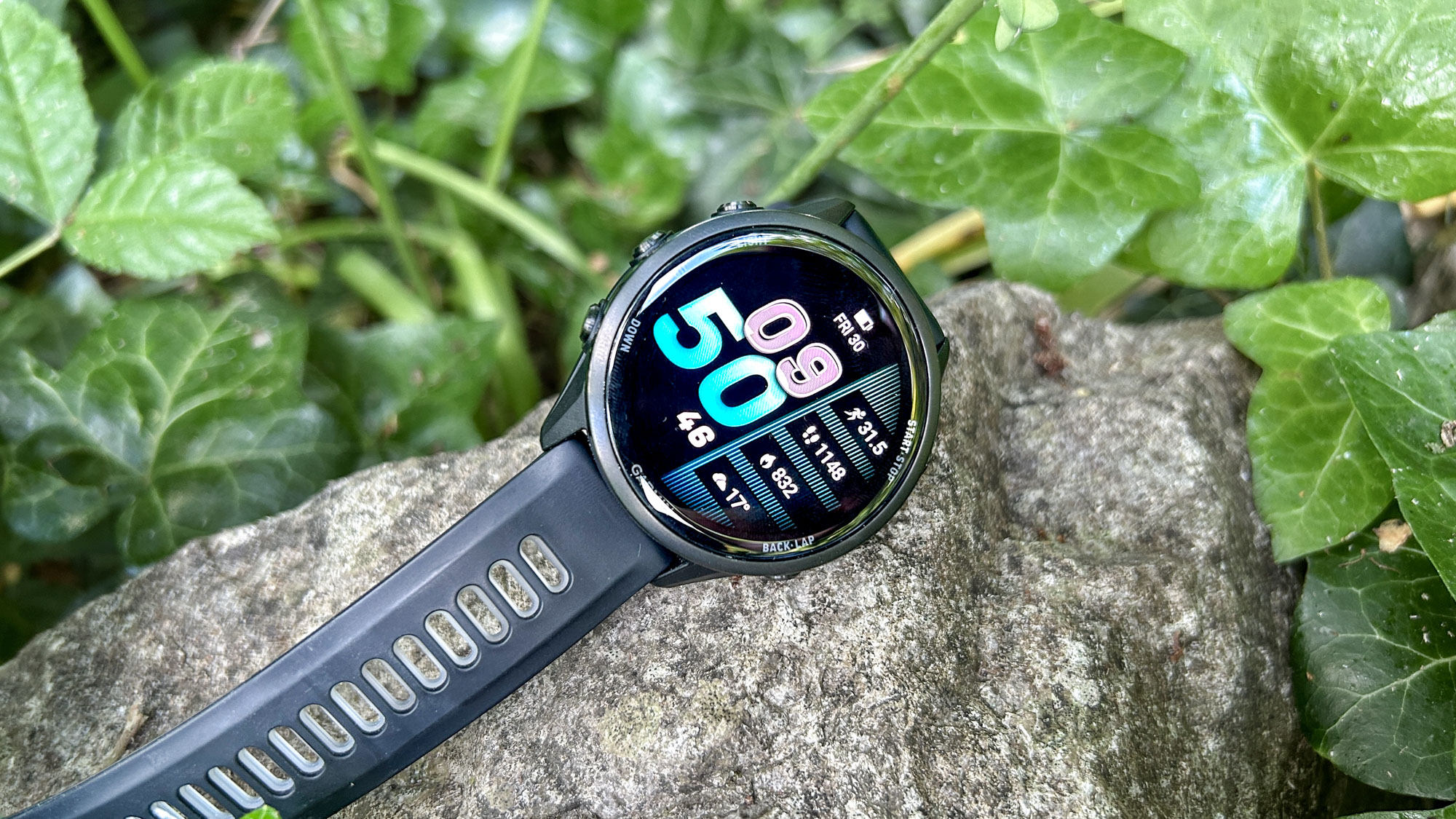
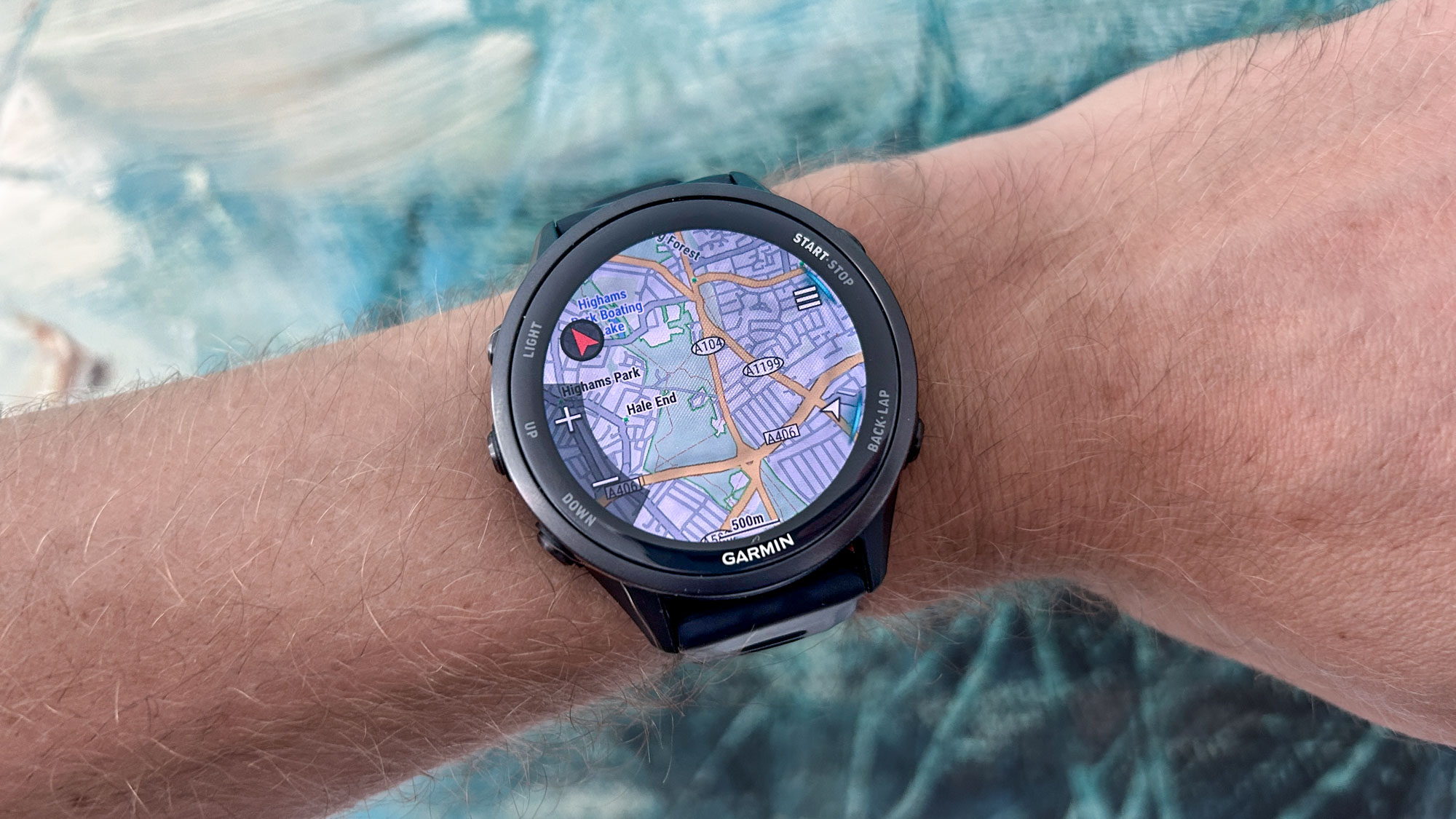
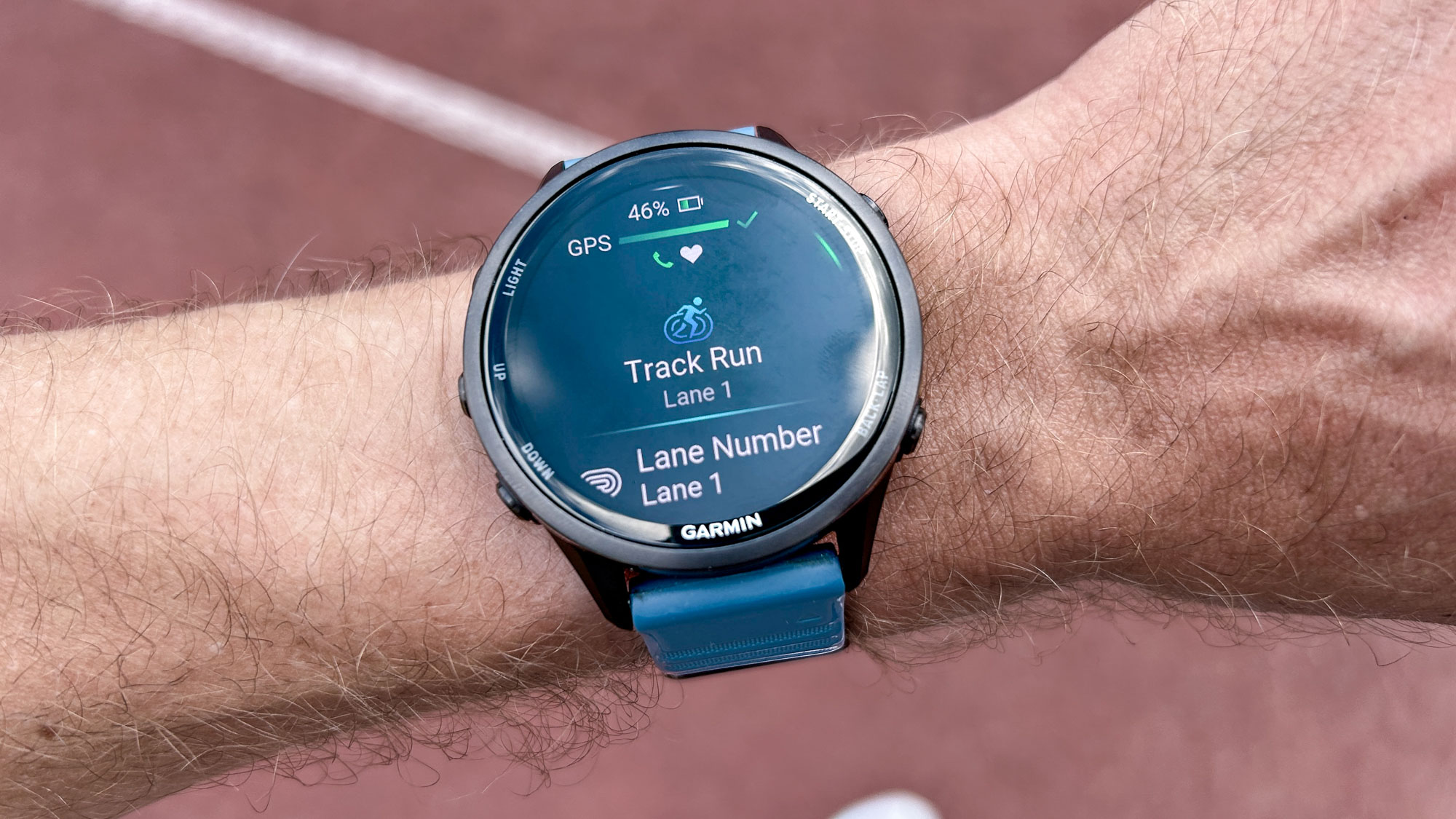
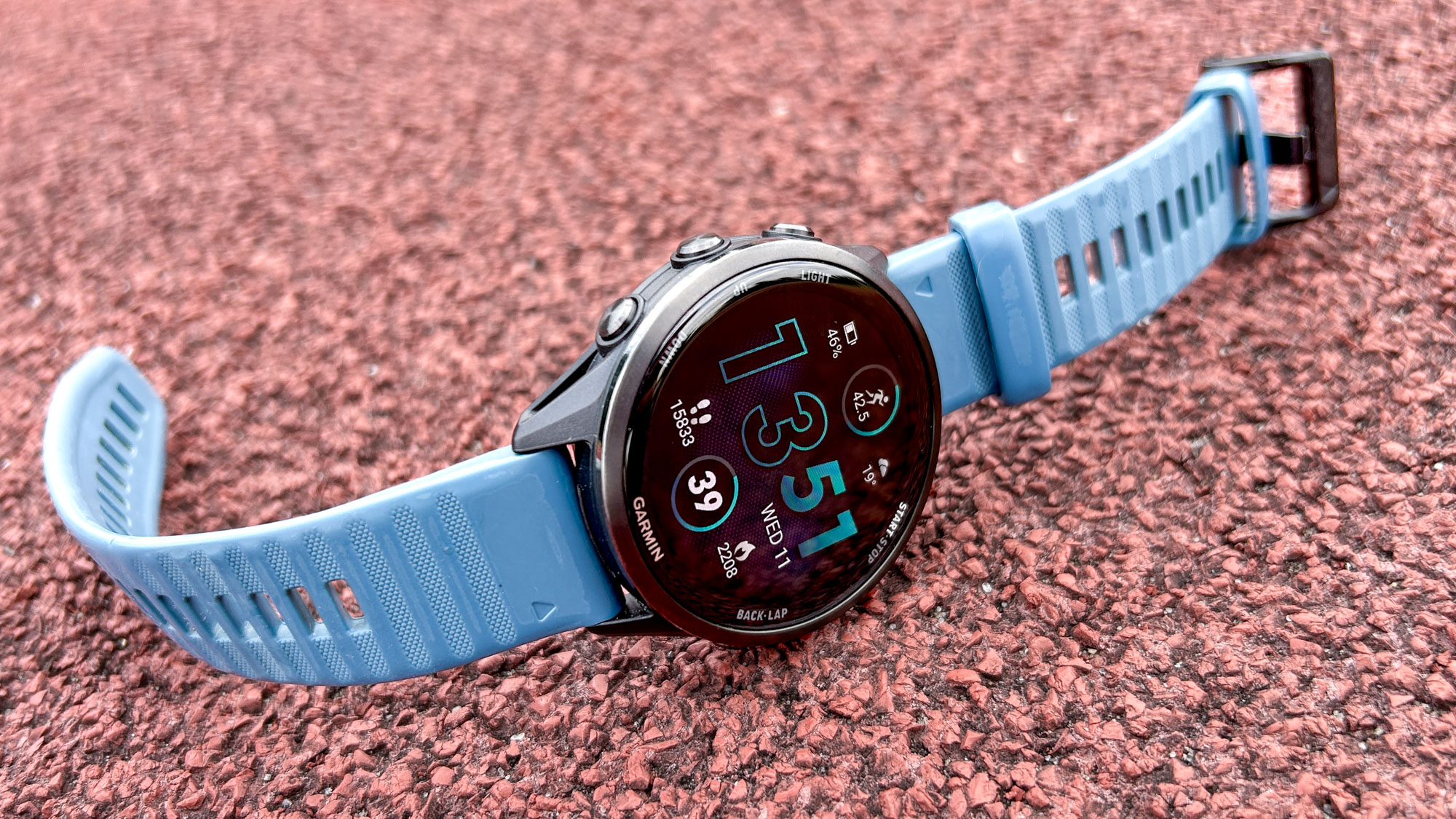
Specifications
Reasons to buy
Reasons to avoid
✅ You want Garmin’s best sports watch: That’s how highly I rate the Forerunner 970. It’s the watch I wear myself because I prefer the lighter, slimmer design to the Fenix 8.
✅ You want the latest features: The Forerunner 970 has Garmin’s newest training features like running tolerance, and as the flagship Forerunner it will get updates for the foreseeable future.
✅ You want maps on your wrist: The Forerunner 970 is loaded with color maps and has Garmin’s impressive navigation tools like on-the-go routing and ClimbPro.
❌ You want a more durable design: The Garmin Fenix 8 is a hardier watch with more metal on its case and a higher waterproof rating, and is also diveproof.
❌ You prefer a small watch: The Forerunner 970 only comes in one size, and the 47mm case is quite large. The 43mm Fenix 8 or 42mm Forerunner 570 are good smaller options.
❌ You need the longest battery life: Garmin watches with memory-in-pixel displays like the Enduro 3 and Instinct 3 Solar have longer battery life, as does the Fenix 8.
⌚ There’s very little I can fault about the Garmin Forerunner 970. It's design and features are outstanding, and it’s the perfect watch for serious triathletes and runners.
What you need to know
The Forerunner 970 is the successor to the Forerunner 965 and sits at the top of Garmin’s Forerunner range. It’s essentially a lighter, slimmer and more affordable alternative to the Garmin Fenix 8, and my favorite Garmin watch overall.
It’s especially good for triathletes and runners who want a lightweight but advanced sports watch, and the Forerunner 970 packs an incredible array of useful sports and navigation features into its slim case. Unless you want the more rugged, diveproof design of the Fenix 8, this is the top Garmin going.
Design: The Forerunner 970 comes in one size and three colors, and has a bright 1.4in AMOLED display. It has Garmin’s usual five button design, and a handy built-in flashlight, which is a key upgrade on the Forerunner 965.
Another important upgrade is the sapphire crystal display, which is much more scratch resistant than the glass display on the Forerunner 965 and cheaper Forerunner models. The Forerunner 970 also has a titanium bezel to boost durability, and weighs a mere 56g with its silicone band.
Battery life: With the screen set to always-on and running every day, the Forerunner 970 lasts me four to five days on a charge, which is pretty good given how big and bright the screen is. Triathletes cycling regularly as well might want to go for the raise-to-wake screen setting to extend the battery life to a week or more.
Training features: The Forerunner 970 has all of Garmin’s top sports features, including training plans and suggested workouts for runners and triathletes, as well as training load analysis and advanced running stats like running economy and running tolerance measurements.This analysis comes on top of the accurate GPS and heart rate tracking, which matches or betters anything else on the market. Even in city center races I’ve seen remarkably precise GPS tracks from the watch.
Read full review: Garmin Forerunner 970
Test | Notes | How it stacks up |
|---|---|---|
Battery life | 15 days smartwatch/ 26 hours GPS | ★★★★☆ |
Features | Training Readiness, Training Status, Running Economy, Running Tolerance, Multisport modes, Chronic Training Load, Acute Load, Advanced mapping | ★★★★★ |
Design | 1.4 inch | ★★★★☆ |
Display | 454 x 454 pixels AMOLED touchscreen | ★★★★★ |
Best Garmin watch for adventure
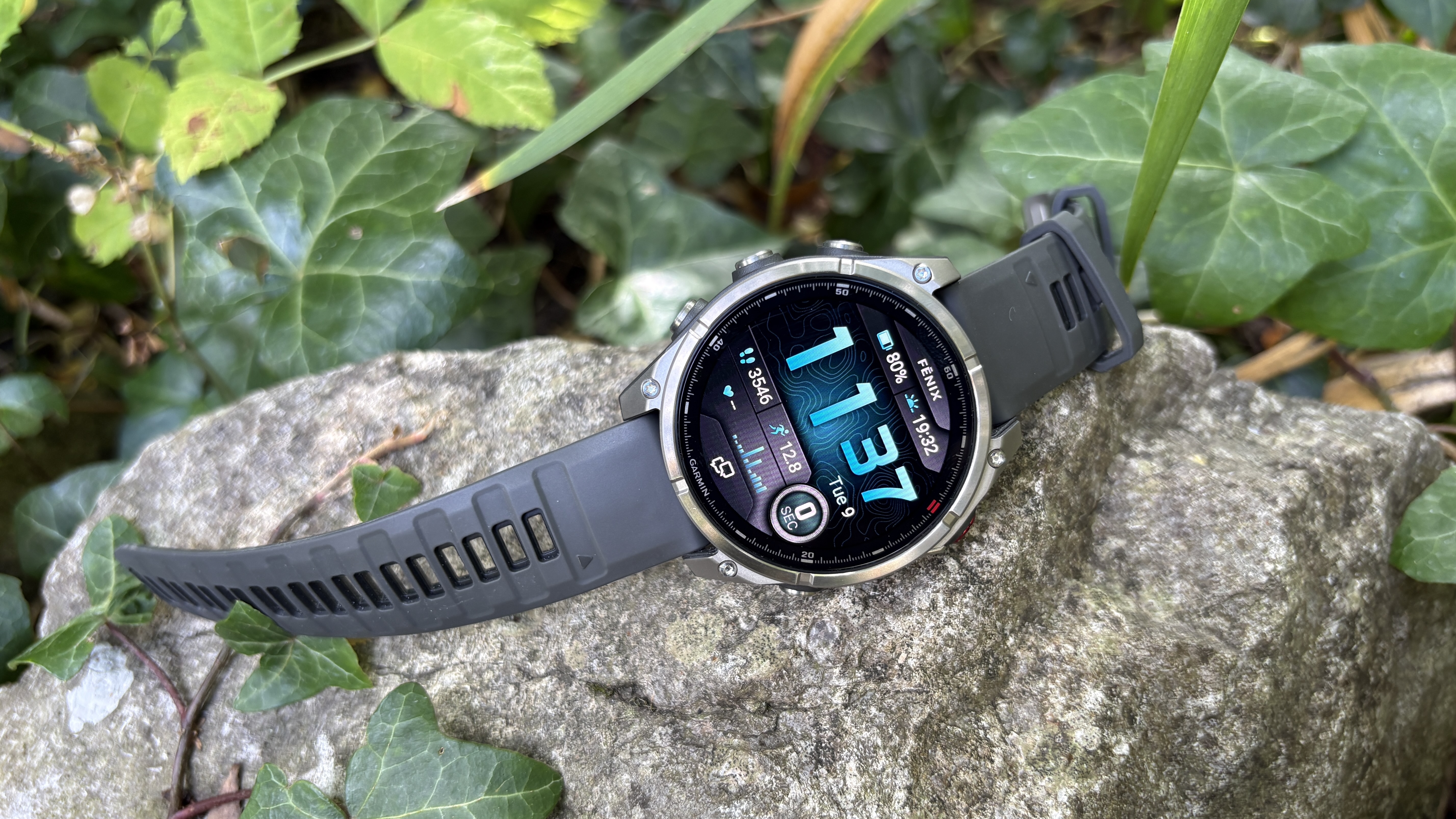
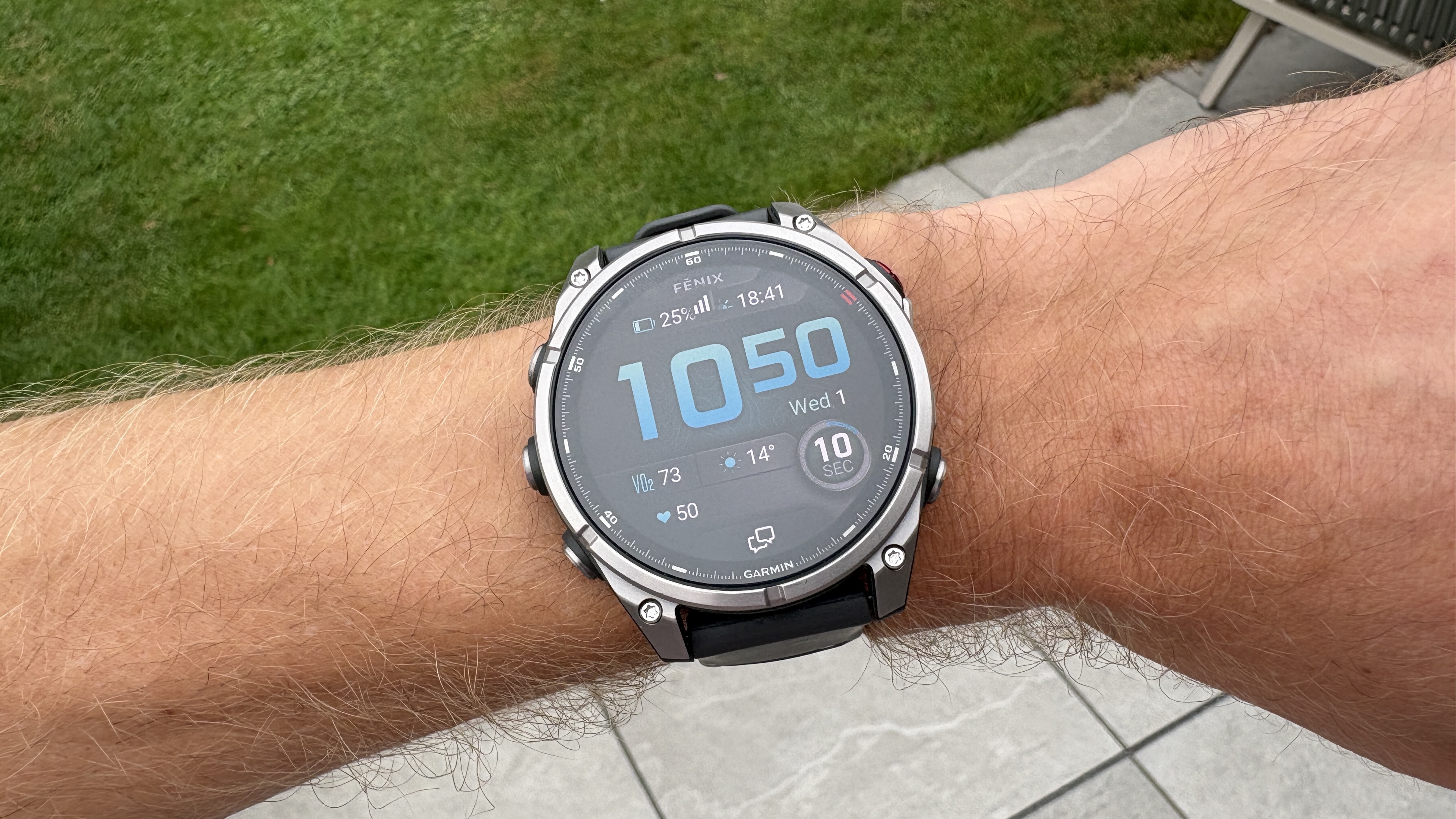
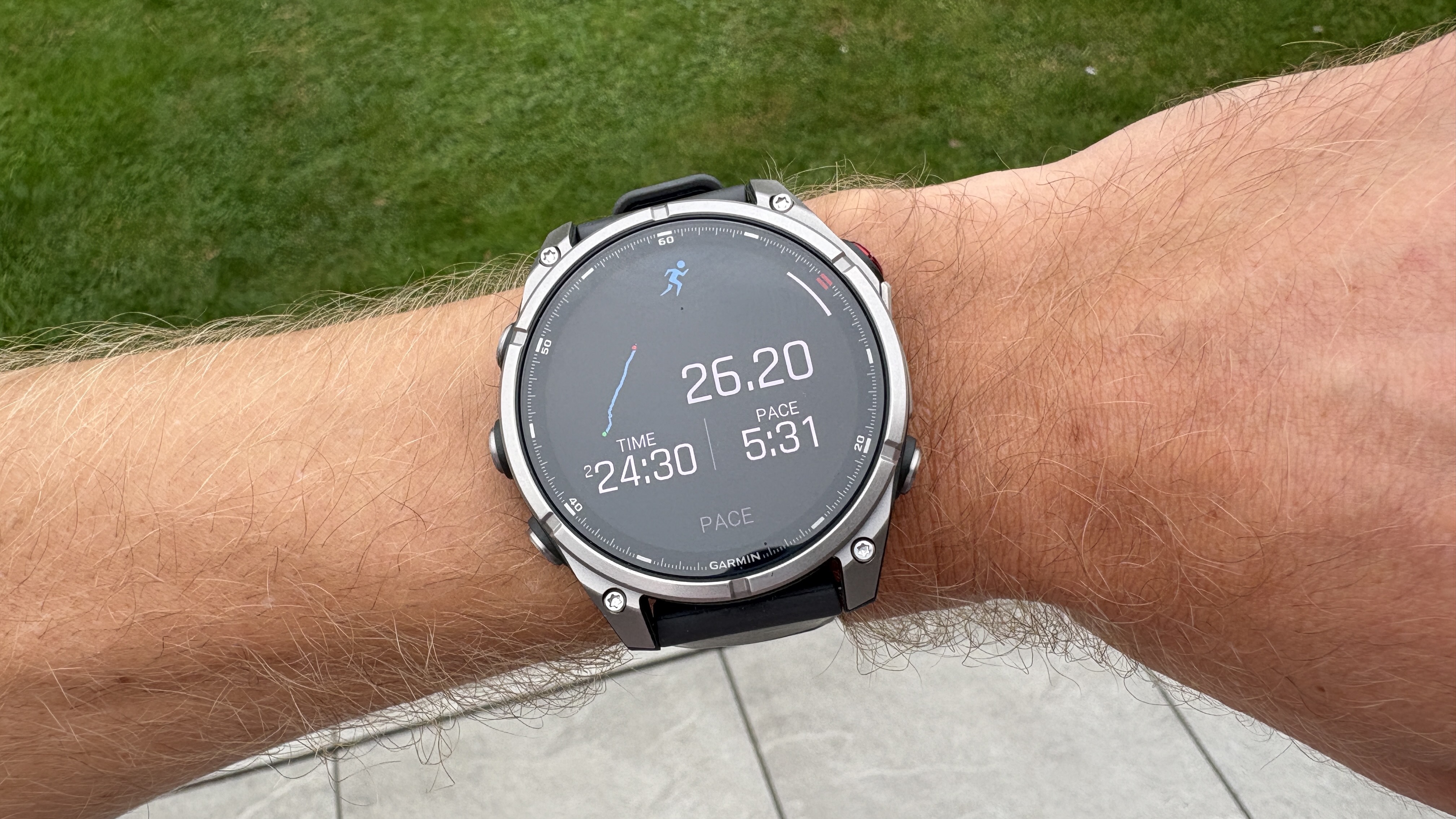
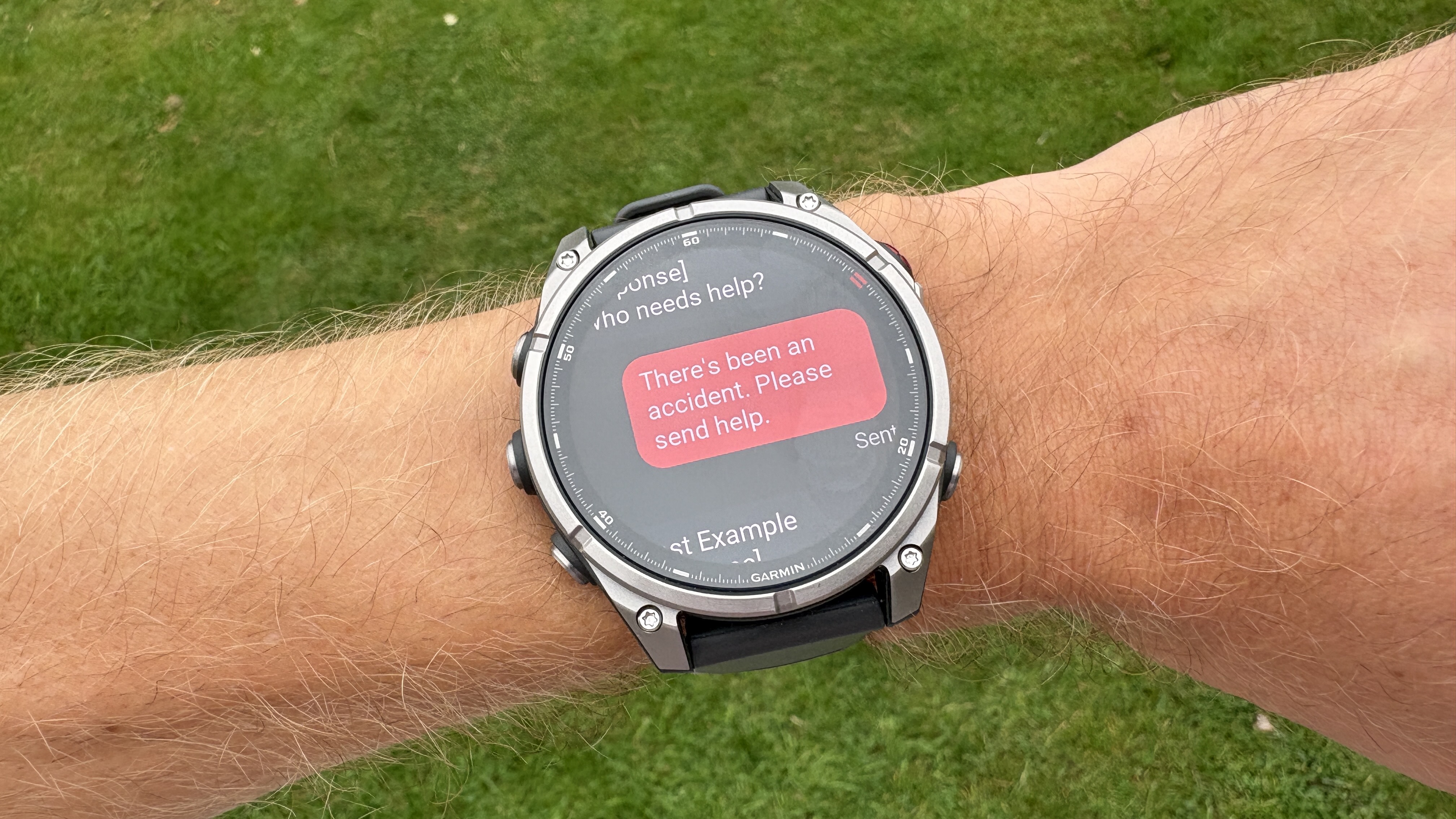
5. Garmin Fenix 8 Pro
Our expert review:
Specifications
Reasons to buy
Reasons to avoid
✅ You need extra connectivity: The Garmin Fenix 8 Pro’s LTE and satellite connectivity features make it the standout pick for those who regularly venture off the grid.
✅ You want the best Garmin sports watch available: This is Garmin’s flagship watch and has all of the brand’s top features, and will be getting the latest software updates in the future as well.
❌ You’re on a budget: This is the most expensive Garmin watch in the range and you can get similar sports and navigation features from cheaper models like the Fenix 8 and Forerunner 970.
❌ You don’t need the connectivity features: The Fenix 8 Pro’s main upgrade on the standard Fenix 8 is the extra connectivity it offers, so get the Fenix 8 for less if you don’t need the LTE and satellite features.
❌ You want an MIP screen: If you don’t want to use an AMOLED sports watch then the Garmin Enduro 3 would be a good alternative for adventure that has even better battery life, though it lacks connectivity.
⌚ The Garmin Fenix 8 Pro builds on the excellent design of the Fenix 8 by adding in connectivity features that will be a vital upgrade to those who love to spend their time adventuring in the wilderness.
What you need to know
The Garmin Fenix 8 Pro is the first Fenix to offer cellular and satellite connectivity, helping you to stay connected when you’re in the great outdoors. This potentially life-saving feature is the key upgrade on the standard Fenix 8 and adds to an incredible roll-call of sports and navigation features that make the Fenix 8 Pro the most capable adventure watch on the market
There are two Fenix 8 Pro models to consider, but the MicroLED version is wildly expensive and doesn’t offer as much battery life as the AMOLED one, so we’d recommend the latter for your trips into the wilderness.
Design: The Fenix 8 Pro AMOLED comes in two sizes — 47mm and 51mm — and has a durable design with a titanium bezel and case back and a sapphire crystal screen. It’s diveproof to 40m too, and has a useful built-in flashlight on the top of the case.
It’s a little thicker and heavier than the standard Fenix 8, which also comes in a smaller 43mm size, so the Fenix 8 Pro is not the perfect option for those with smaller wrists. However, its rugged build is perfect for adventures and will withstand almost anything you throw at it.
Battery life: The Fenix 8 Pro is an AMOLED watch but still offers incredible battery life, lasting up to 27 days in watch mode if you opt for the larger 51mm model, and 15 days with the 47mm watch. It also offers up to 78 hours of GPS tracking, and the 51mm watch offers 19 hours of tracking even with LiveTrack enabled so your key contacts can track your location.
Training features: The Fenix 8 Pro offers the same impressive array of sports tracking and training analysis features as the Fenix 8, including daily suggested workouts, training load advice and insights into your hill climbing ability and overall endurance.
Throughout my testing of the watch the GPS and heart rate accuracy has been excellent, and while the Fenix 8 Pro doesn’t offer any sports features you don’t get on the likes of the Fenix 8 and Forerunner 970, having the added extra of connectivity on top of those features makes it Garmin’s flagship adventure watch.
Read our full review: Garmin Fenix 8 Pro
Test | Notes | How it stacks up |
|---|---|---|
Battery life | Up to 27 days (watch mode) Up to 78 hours(GPS-only) | ★★★★★ |
Features | LTE & Satellite Connectivity, Training Readiness, Training Status, Multisport modes, Chronic Training Load, Acute Load, Advanced mapping, Hill score, Endurance score, Flashlight | ★★★★★ |
Design | 47mm or 51mm case, 1.4-inch screen | ★★★★★ |
Display | 454 x 454 pixels AMOLED touchscreen | ★★★★★ |
Best Garmin watch for fitness
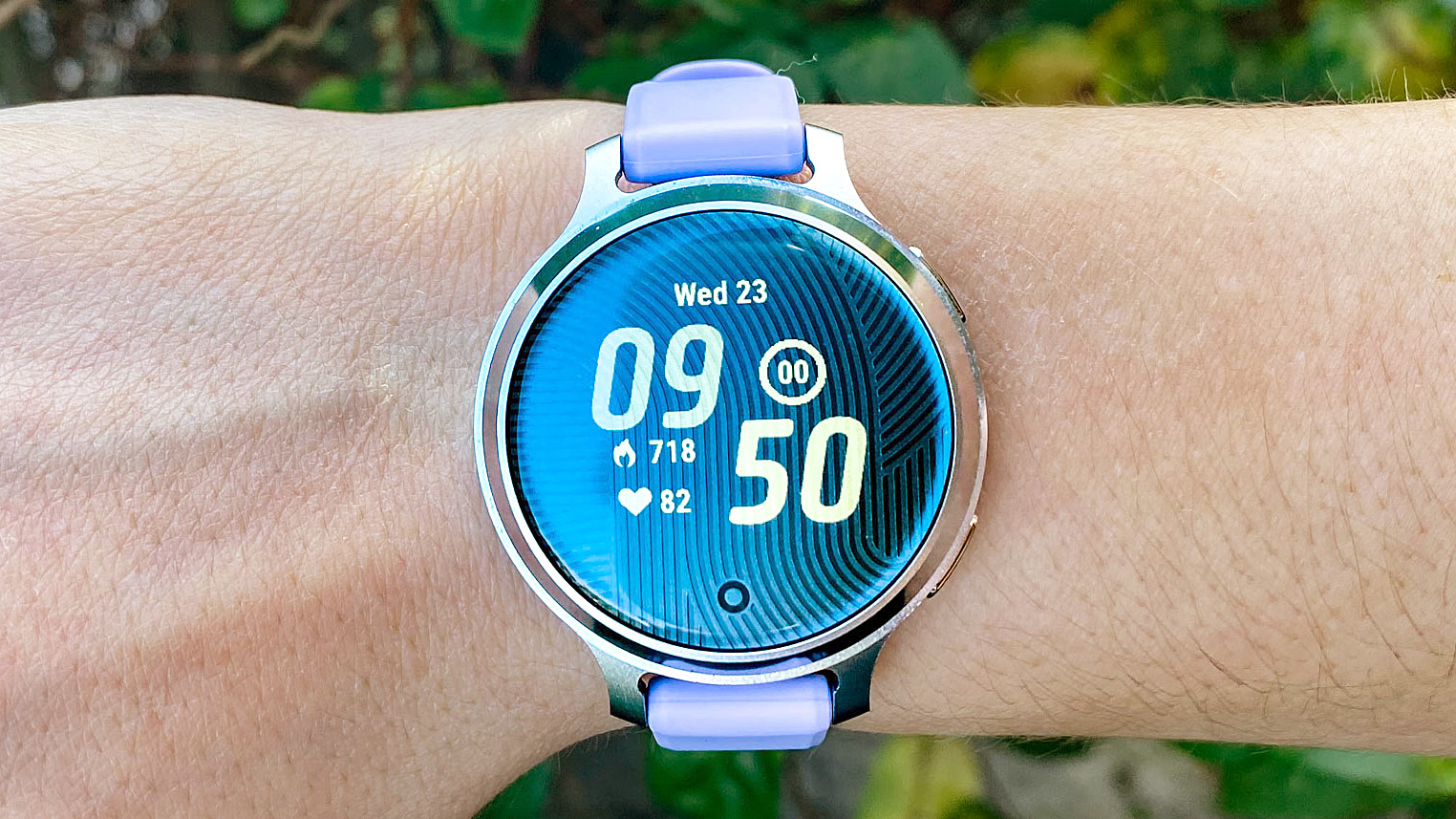
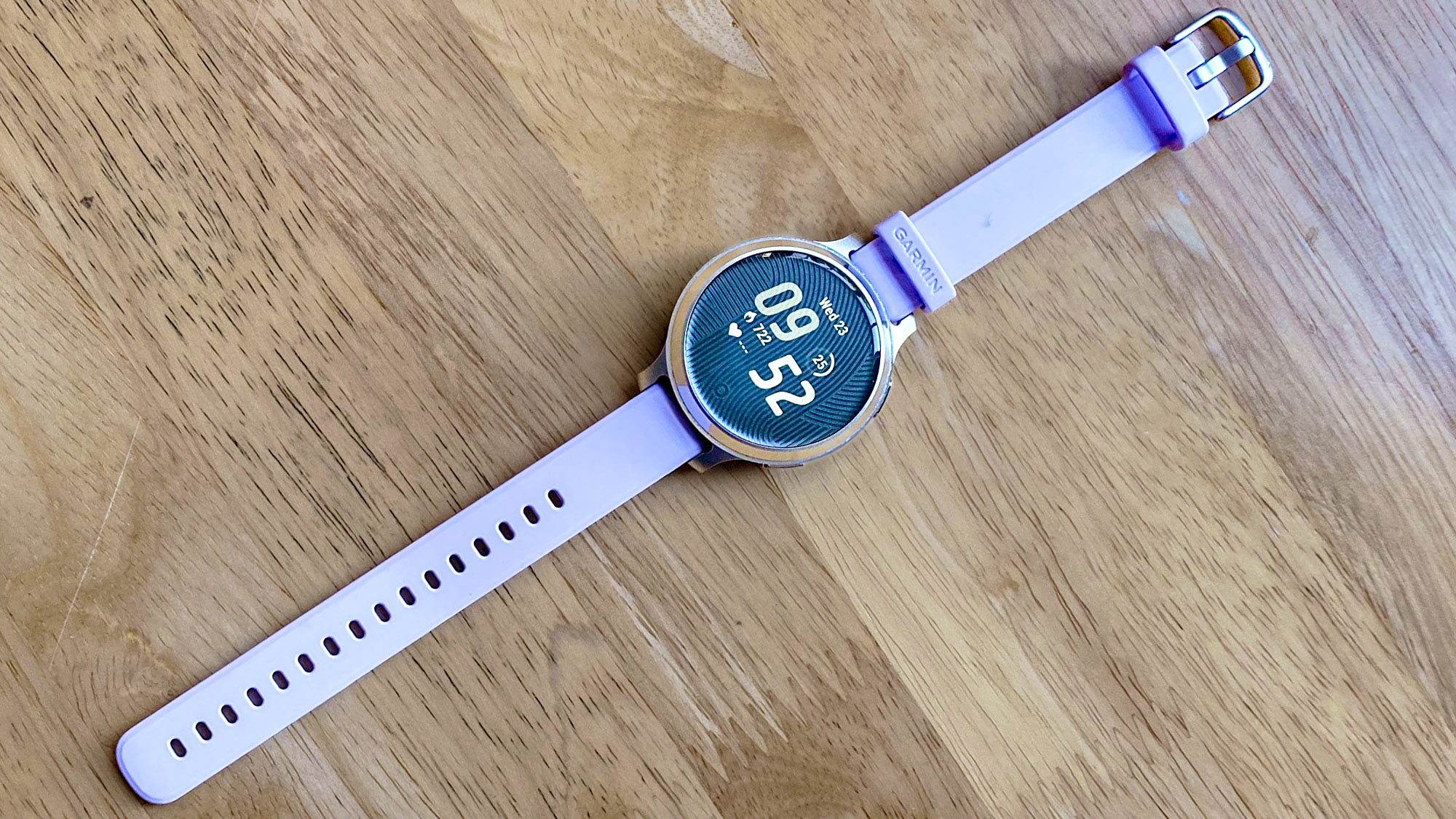
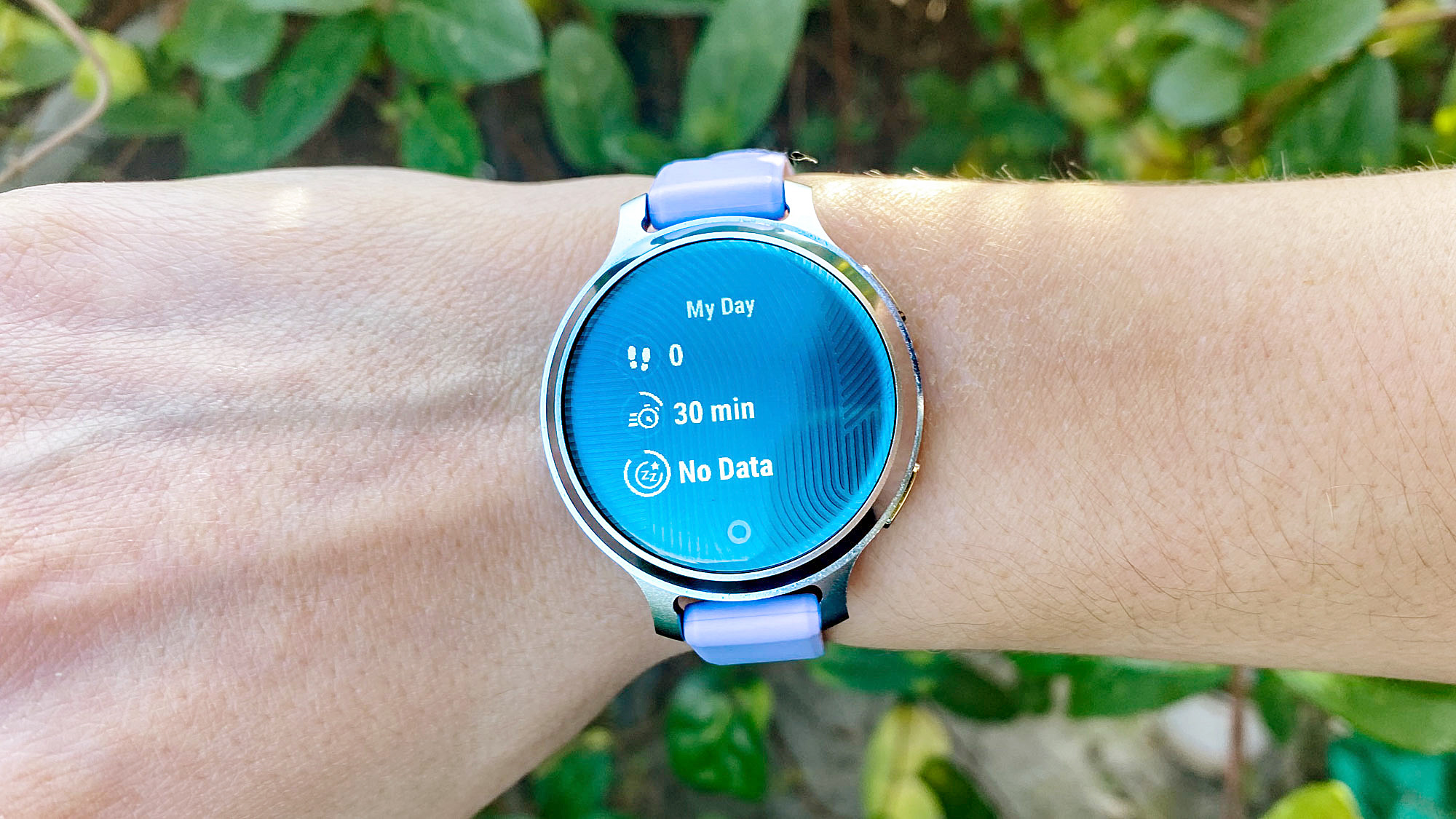
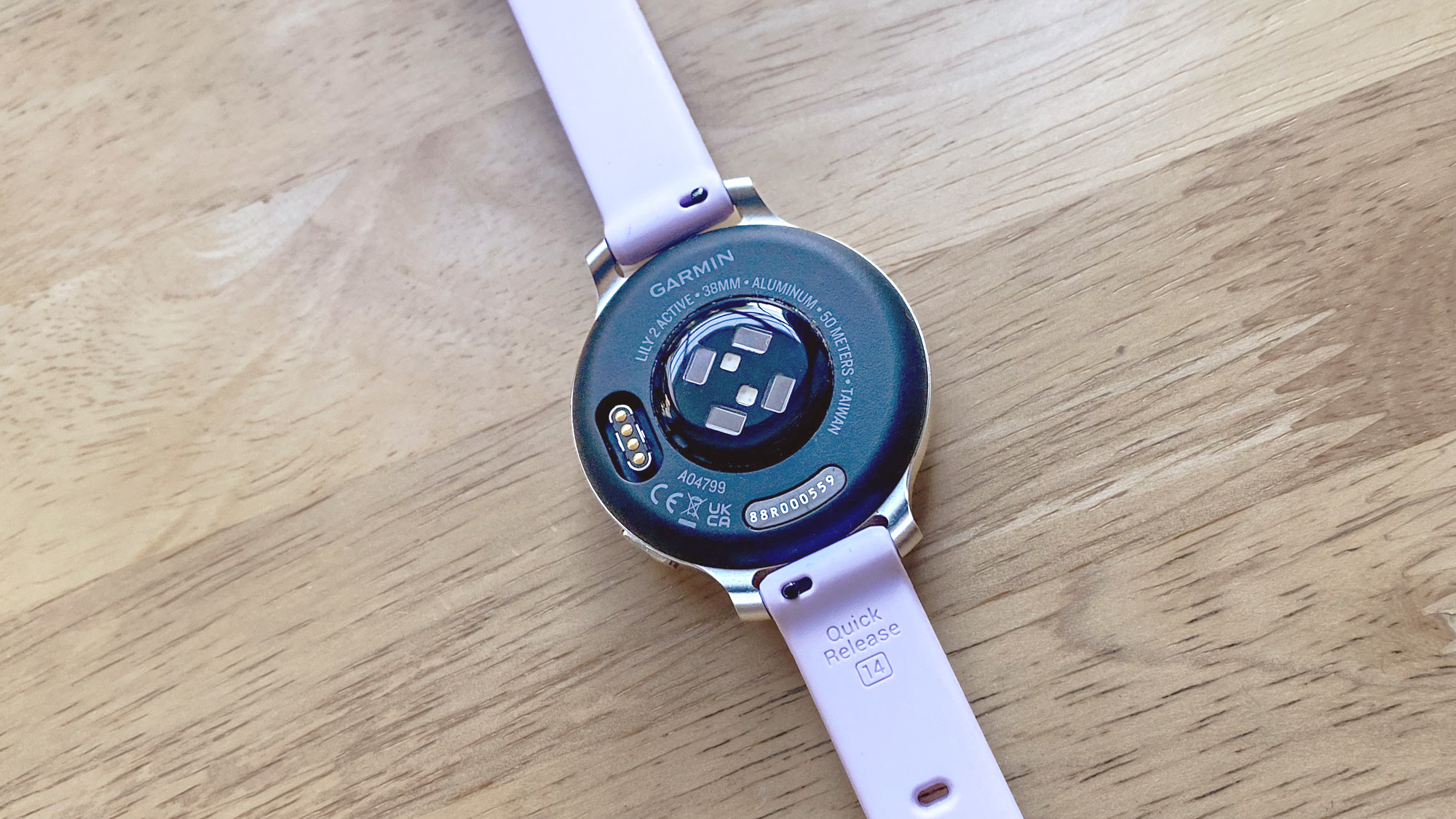
6. Garmin Lily 2 Active
Our expert review:
Specifications
Reasons to buy
Reasons to avoid
✅ You want a sports watch that doesn't look like a sports watch: The Garmin Lily 2 Active could easily pass as jewelry and is up there with the Oura ring in terms of being a discrete tracker.
✅ You want to track your periods from your watch: The Garmin Lily 2 Active is designed for female users and allows you to track your menstrual cycle and pregnancy from your wrist.
❌ You want Garmin's best training tools: The Garmin Lily 2 Active has built-in GPS and records basic workout data but doesn't offer as comprehensive training tools as you'll find on higher-end models.
❌ You want a color screen: The Lily 2 Active has a 16-level grayscale display.
⌚ The Garmin Lily 2 Active is a stylish and low-profile fitness tracking watch designed for women. While it doesn't offer the advanced training features found on some of Garmin's sportier wearables, onboard GPS is accurate and the battery is long-lasting.
What you need to know
If you’re looking for an activity tracker that doesn’t look like an activity tracker, the Garmin Lily 2 Active is for you. It’s arguably Garmin’s most fashionable smartwatch and has several useful tools for female users, including menstrual and pregnancy tracking, giving mums-to-be a better understanding of their day-to-day health.
The Lily 2 Active also boasts an onboard GPS for location tracking during workouts letting you leave your phone at home, something you won't find on the standard Lily 2 or Lily 2 Classic. The Active edition also boasts two physical buttons, which we prefer to use when starting and stopping a workout to the device's touchscreen. It additionally has NFC for mobile payments and over a week's worth of battery in normal smartwatch mode.
Design: The Garmin Lily 2 Active is designed with female users in mind. The aluminum case is a manageable 38mm in diameter, considerably smaller than most of Garmin's other watches. Weighing 29g, it's also one of the lightest watches in Garmin's range. The Lily's one-inch display is monochromatic and doesn't get nearly as bright as watches with AMOLED screens. That said, we found the display's high-contrast nature still results in decent readability in bright sunlight.
Battery life: Garmin rates the Lily 2 Active smartwatch for nine days of battery life in smartwatch mode, including overnight wear for sleep tracking, and nine hours when using GPS tracking. During testing, we found those figures to be right on the money. Moreover, the display settings have the biggest impact on battery life.
At max brightness, we lost more than 30% of juice in one day, but when we relied on auto-brightness, the battery drain rate slowed. Still, for such a small device, battery life impresses.
Training features: The Garmin Lily 2 Active doesn't offer nearly as many trackable sports profiles as most of the other devices in our guide nor do you get Garmin's higher-end training tools, like Garmin Coach. But, it's perfectly suitable for keeping tabs on popular exercises like runs, walks, gym workouts, yoga, pilates and of course, pickleball.
Additionally, the Lily 2 Active offers 24/7 heart rate monitoring, SpO2 tracking and Garmin’s Body Battery feature to help you gauge your energy levels throughout the day. It additionally keeps tabs on stress, sleep quality and menstrual cycles.
For peace of mind, the Lily 2 Active has incident detection and emergency alerts, two tools that can alert loved ones or medical personnel in the event of a fall or accident.
Read our full Garmin Lily 2 Active review
Test | Notes | How it stacks up |
|---|---|---|
Battery life | Up to 9 days | ★★★★☆ |
Features | Heart rate, SpO2, Body Battery, Stress tracking, Women's Health tracking | ★★★☆☆ |
Design | 1.00” x 0.84” screen | ★★★☆☆ |
Display | 240 x 201 pixels grayscale touchscreen | ★★★☆☆ |
Best Garmin watch for golf
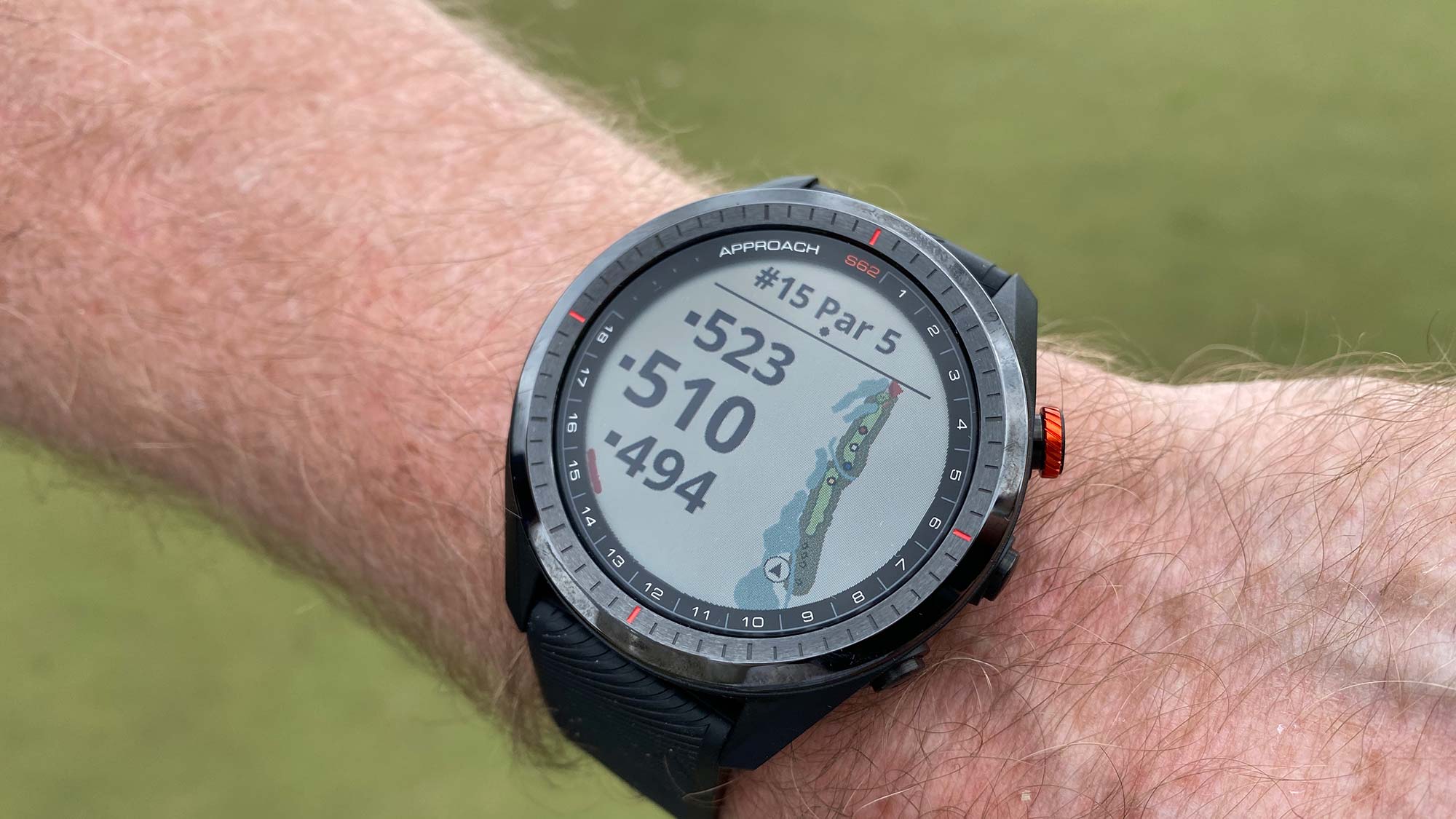
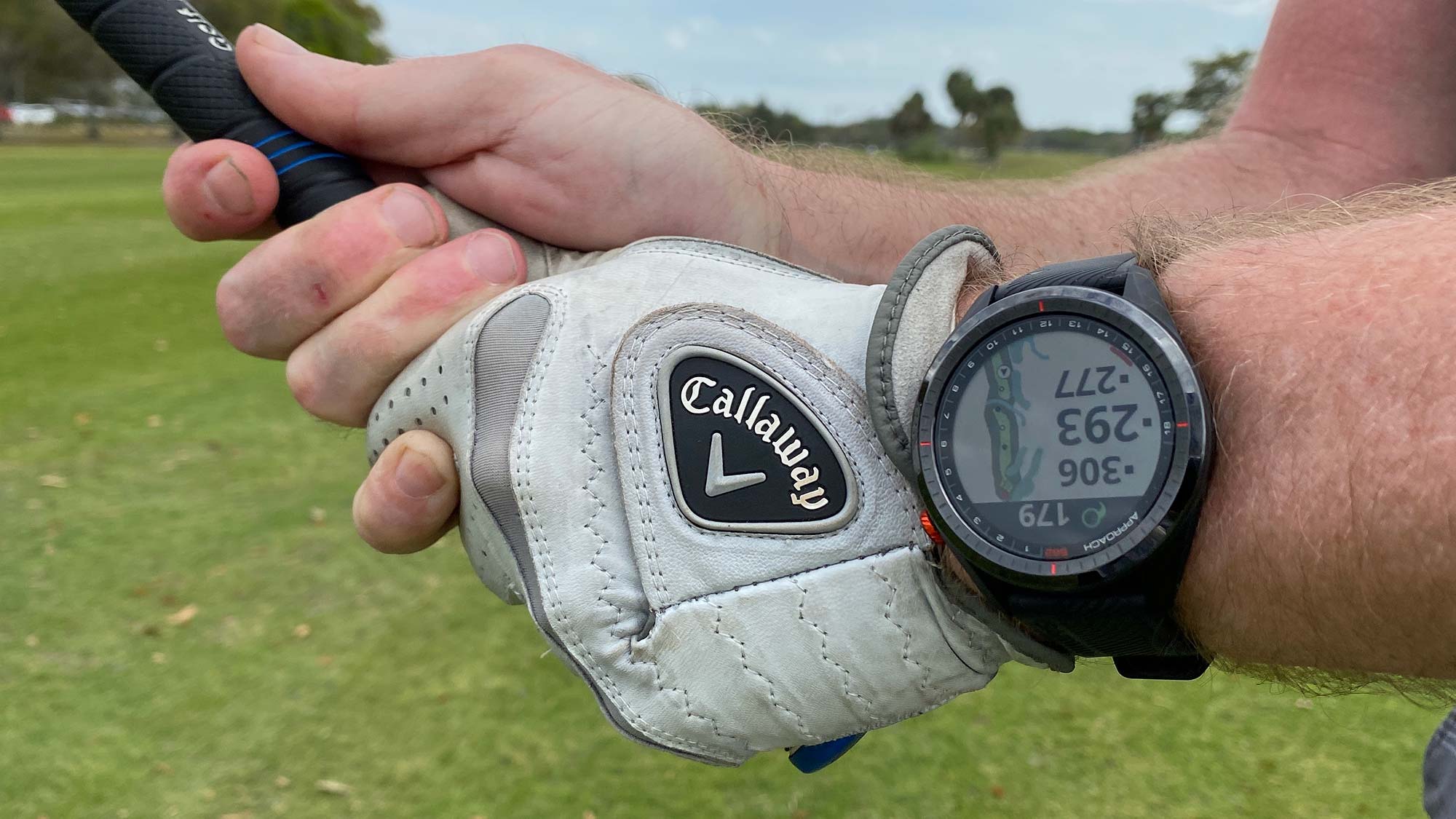

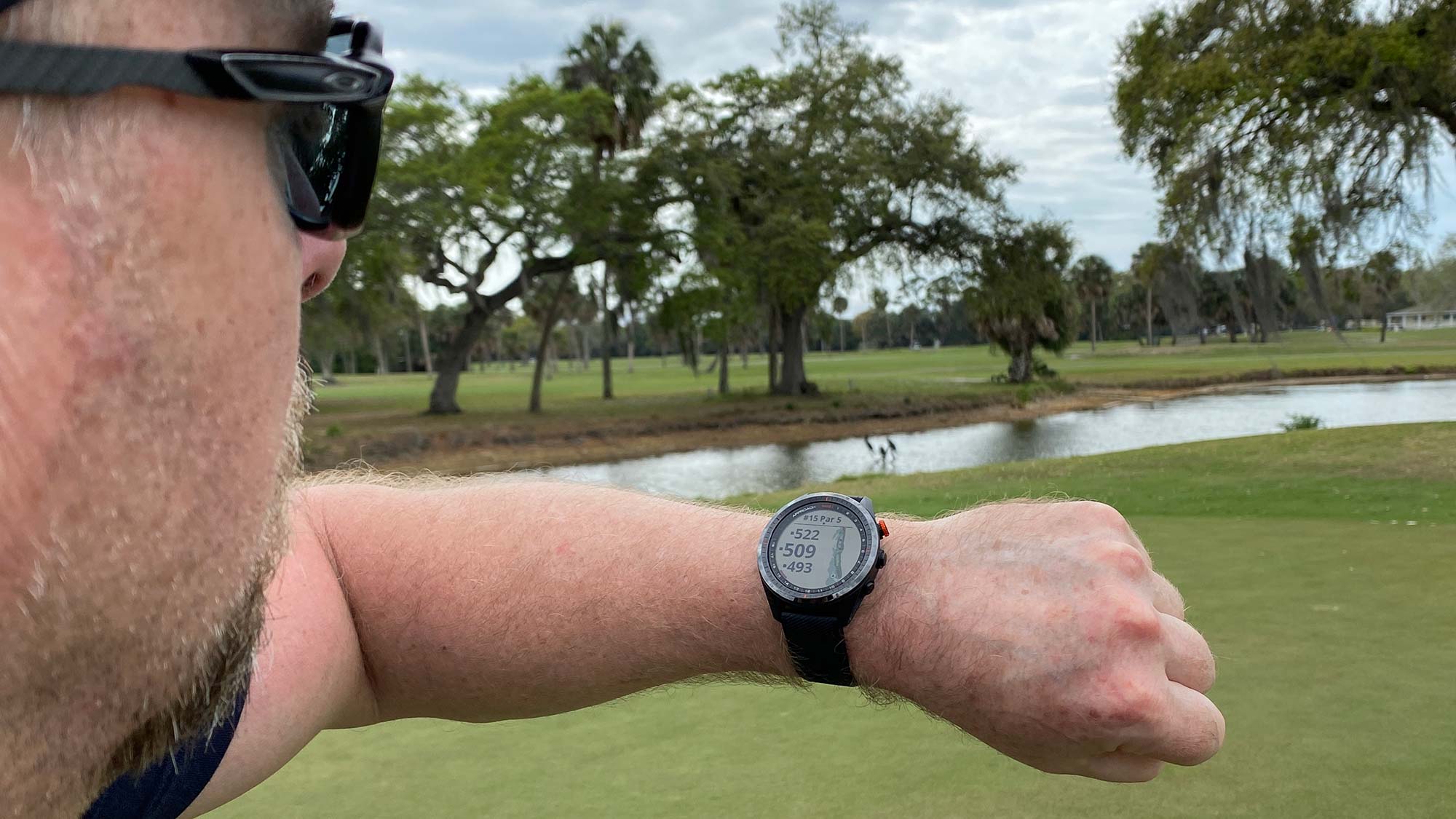
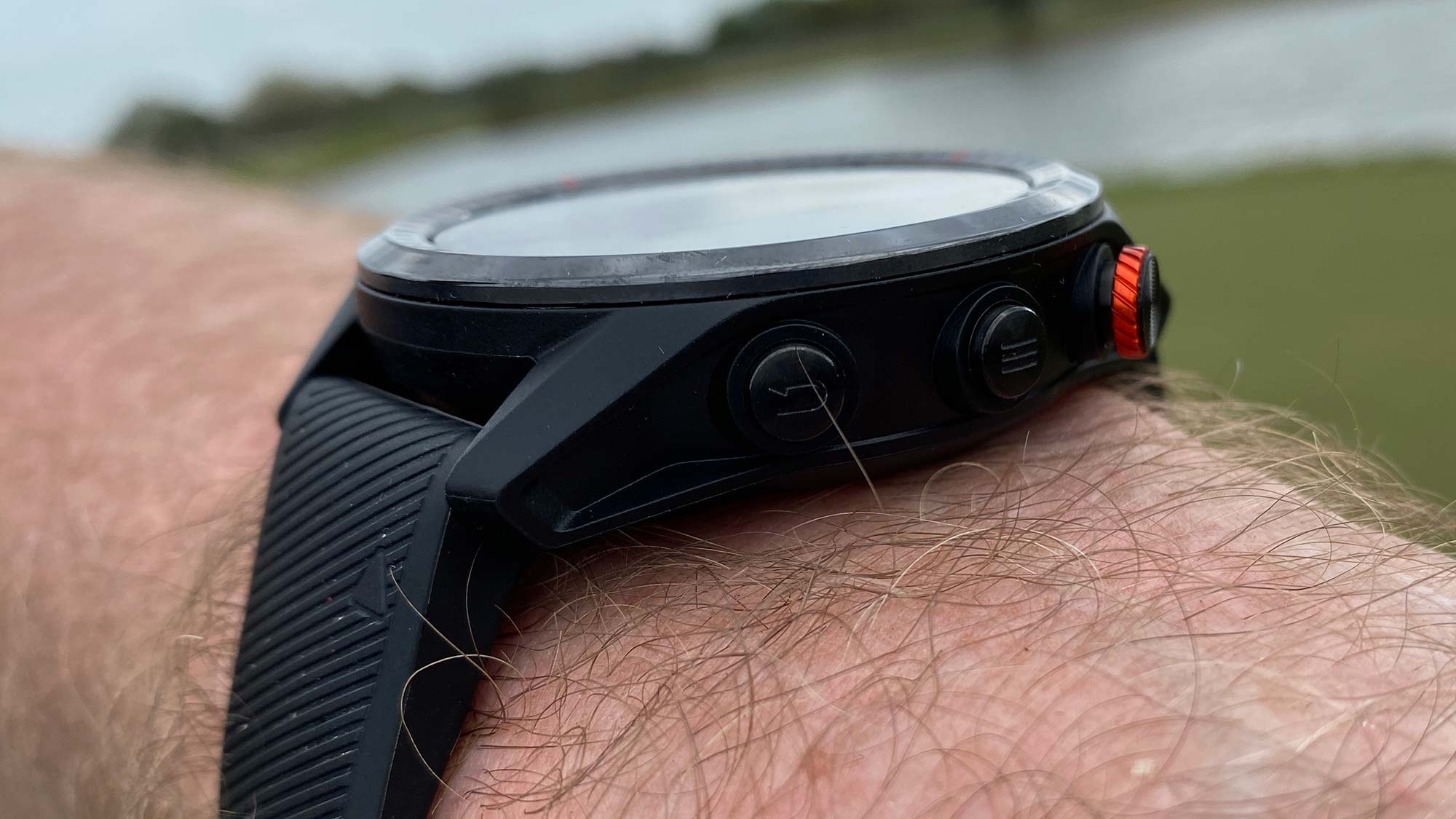
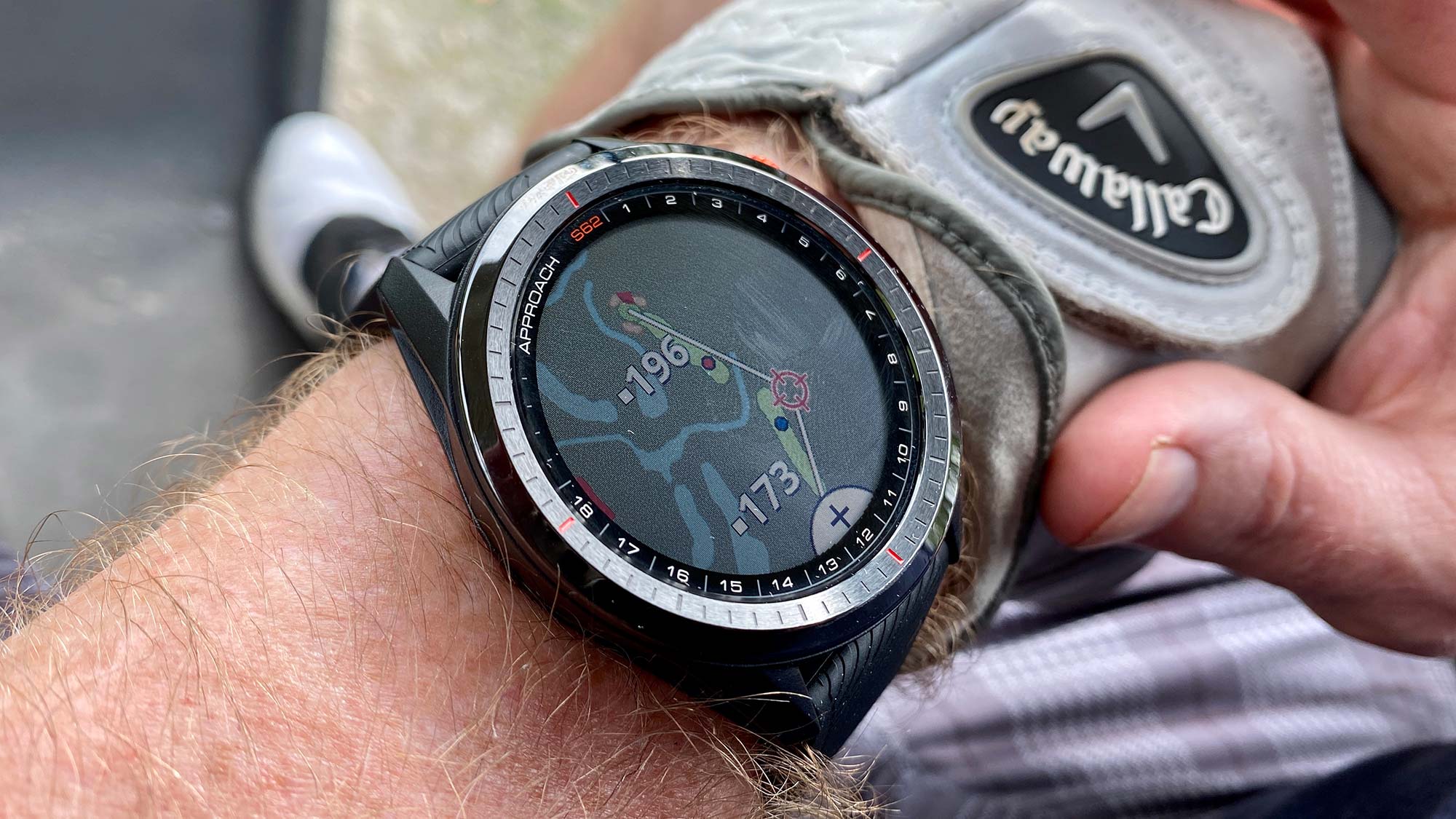
Specifications
Reasons to buy
Reasons to avoid
✅ You're serious about golf: The Garmin Approach S62 is one of the best golf watches on the market, with all the features you could need on the green.
✅ You also want to track other workouts: Unlike cheaper golf watches, the Approach S62 allows you to track other sports activities and has features like Garmin's Body Battery.
❌ You're a beginner: There's an awful lot on this watch, and if you're a complete beginner, you're probably better off with a cheaper version, like the Garmin Approach S20.
❌ Battery life is important: The battery life on the Approach S62 isn't the worst, but if you're going on a week's golf holiday, you'll want to take a charger.
⌚ The Garmin Approach S62 is one of the best golf watches on the market, jam-packed with features, and an upgrade on the Garmin Approach S60.
What you need to know
If golf is your game, then the Garmin Approach S62 is the watch for you. With a scratch-resistant ceramic bezel and silicone straps, it’s rugged enough for a round of 18 while stylish enough for the 19th hole in the clubhouse.
The Garmin Approach S62 comes with key golf features such as access to data on 41,000 courses worldwide, GPS readings on distance and hole hazards and a shot-tracking function. There’s also a virtual caddie that recommends clubs based on distance to the pin. It may be a lot for a novice golfer (if that’s you, check out our Garmin S20 review,) but veteran golfers will appreciate the insight —and may even leave the rangefinder at home.
Design: The Garmin Approach S62 looks similar to other Garmin watches on this list, with a round 1.3-inch screen and three buttons on the right-hand side, allowing you to navigate around the watch without using the touchscreen if you're wearing a golf glove.
The watch has a scratch-resistant ceramic bezel and interchangeable silicone straps that strike an excellent balance of style and comfort. To that effect, it looks sporty enough for clubhouses yet stylish enough for a steakhouse. We reviewed the all-black unit, but there’s a white version that better resembles a golf glove, which some aesthetically minded players might prefer.
Battery life: The Garmin Approach S62 lasts about 14 days without a charge, although you’ll get just 20 hours in continuous GPS mode. Our tester, a golfer with 30 years of experience, made it through a week with 3 rounds before needing to recharge the S62, so it’s safe to say you can leave Garmin’s proprietary charger at home for a weekend golf trip.
Training features: Off the course, the watch tracks a variety of additional indoor and outdoor exercises, including swimming, along with heart rate and sleep. It also boasts Garmin’s “Body Battery” energy monitor. Plus, the Approach S62 can track bicycling, rock climbing, skiing, running and a variety of indoor exercise. It’s also waterproof so it can record your swims or be worn while paddleboarding, and you get handy smartwatch features like Garmin Pay, along with customizable smartphone notifications.
Read full review: Garmin Approach S62
Test | Notes | How it stacks up |
|---|---|---|
Battery life | Up to 14 days smartwatch/ 20 hours GPS | ★★★★☆ |
Features | Body Battery, Pulse ox, Sleep tracking, Garmin's golf features | ★★★★☆ |
Design | 1.3-inch screen | ★★★☆☆ |
Display | 260 x 260 pixels MIP display | ★★★☆☆ |
The best Garmin watch for battery life
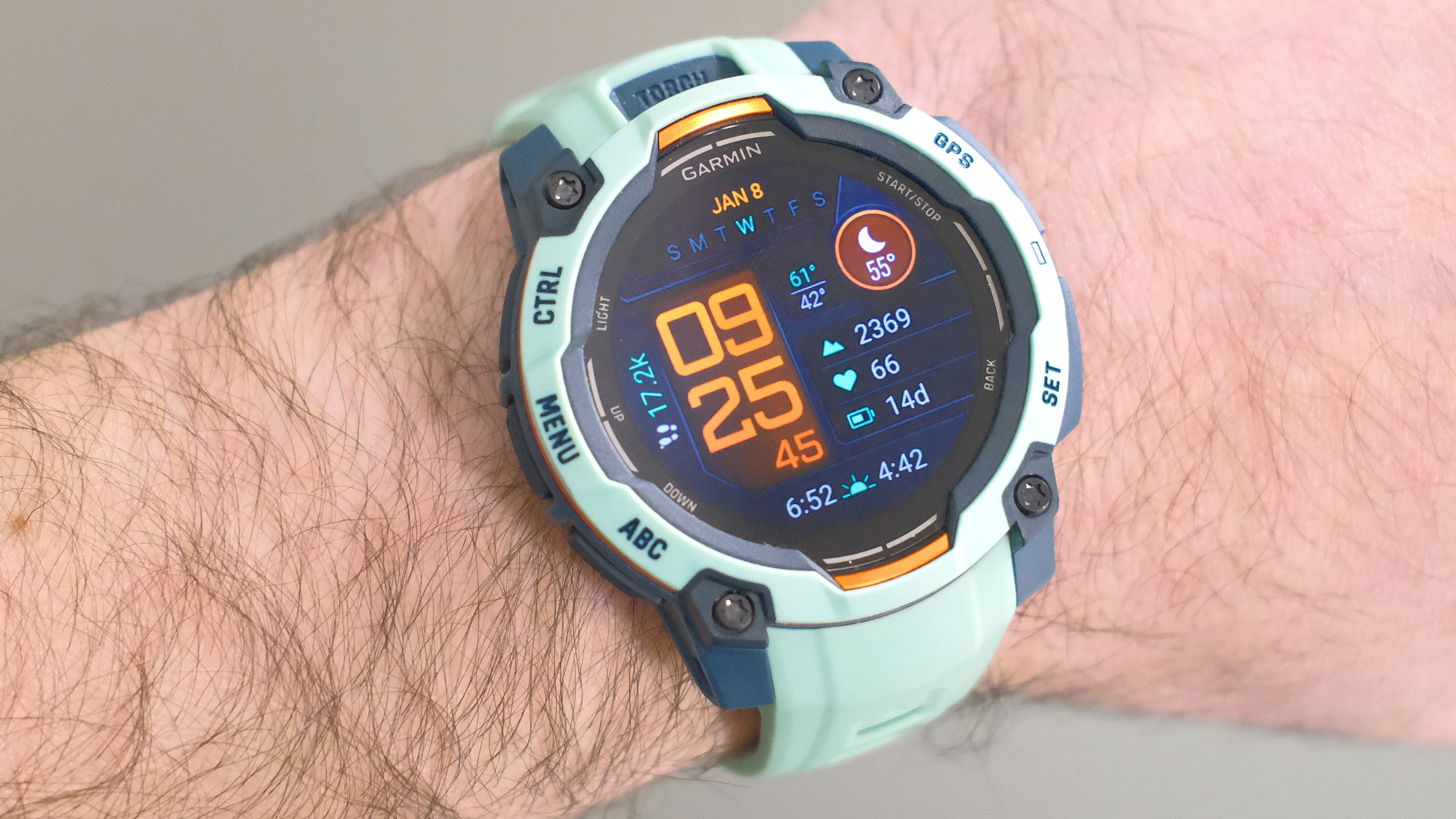
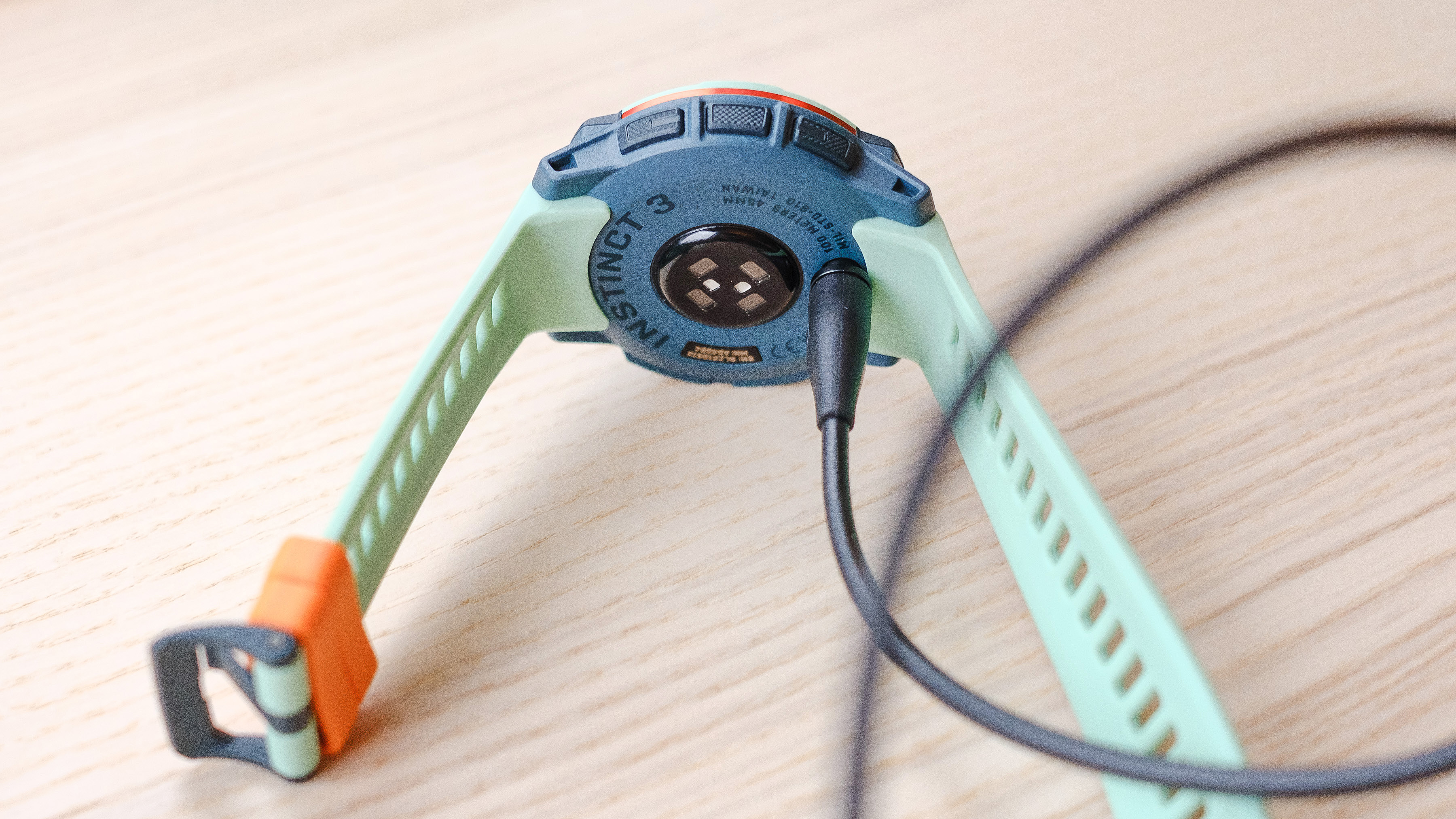
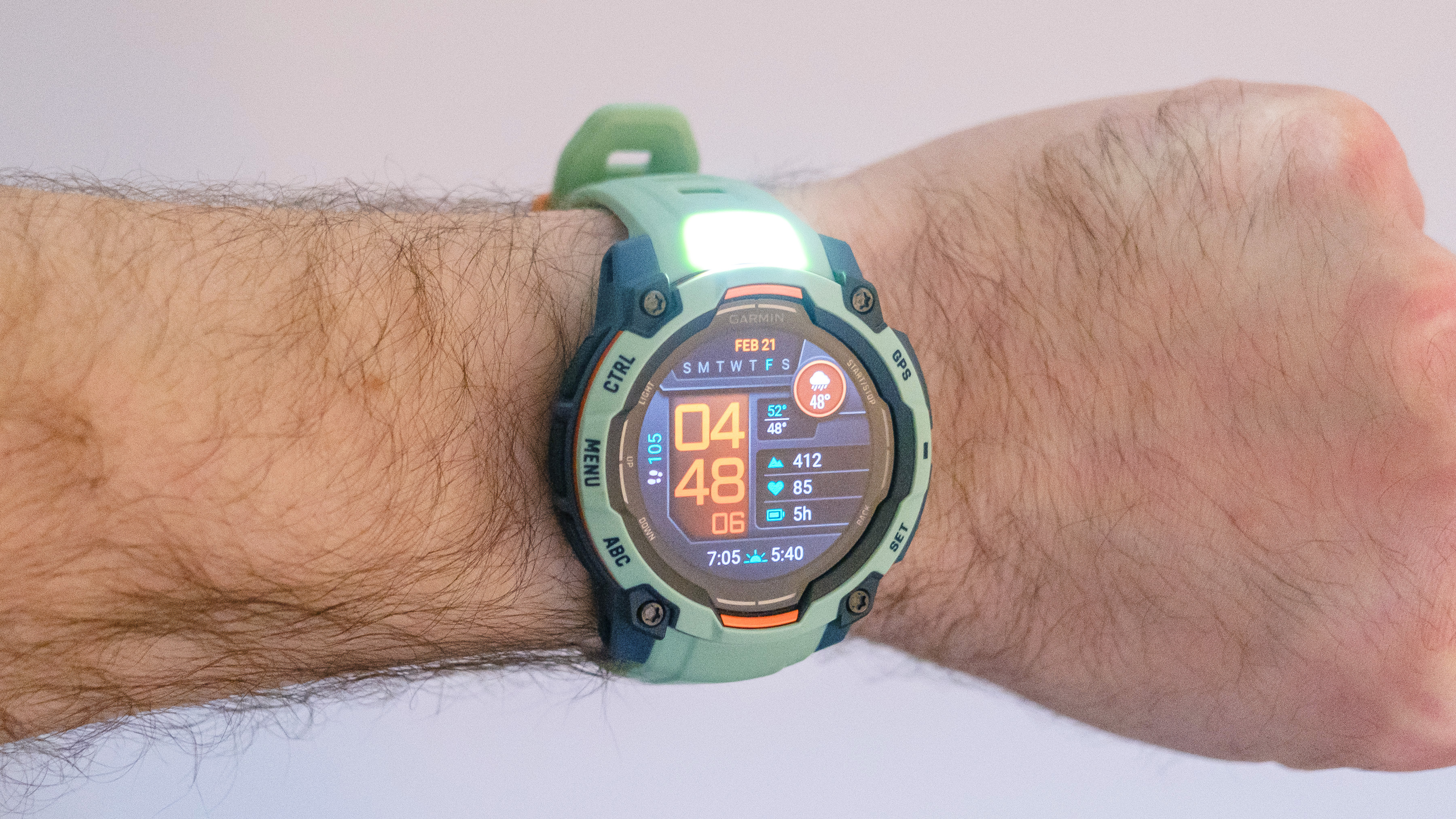
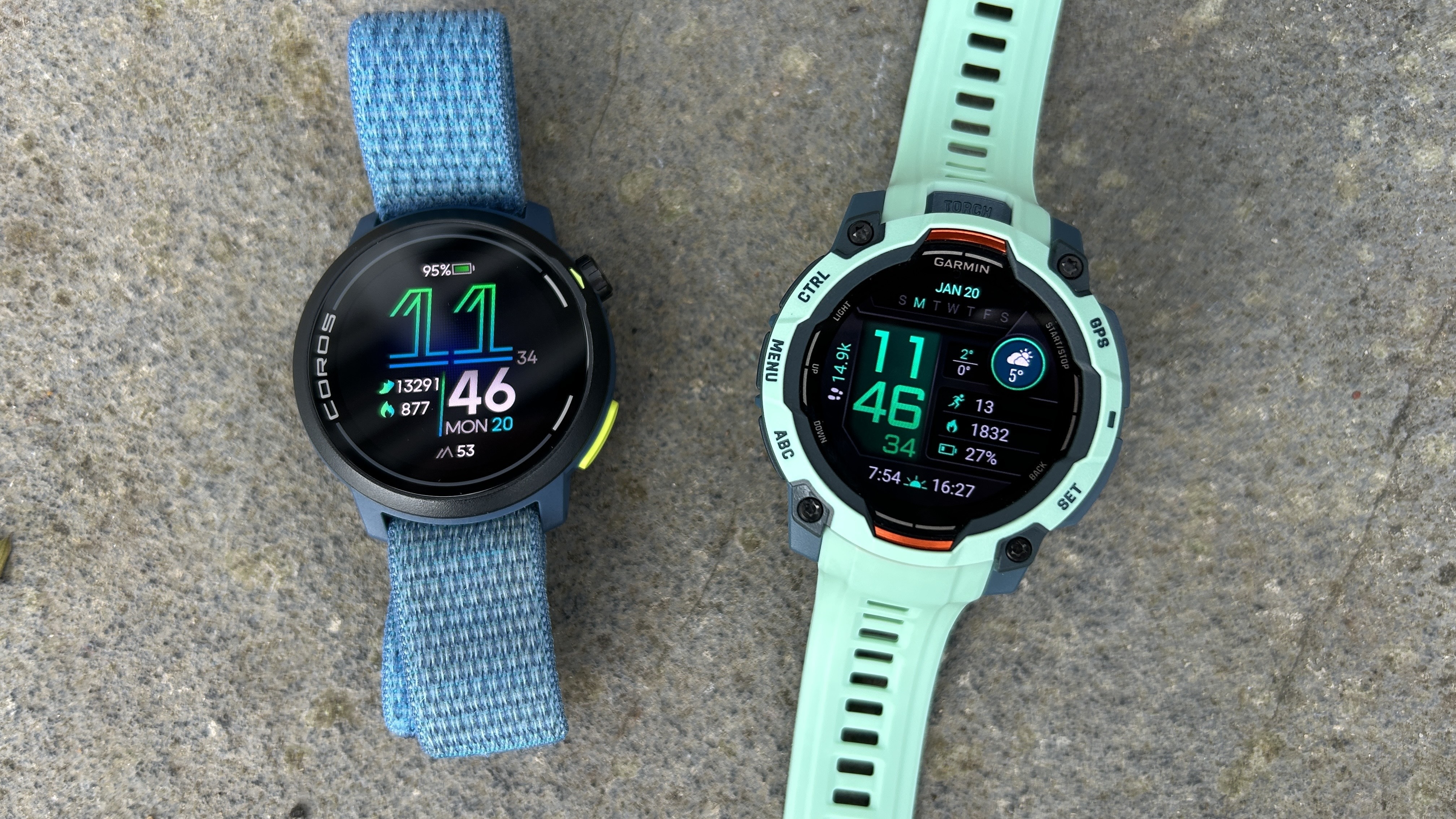
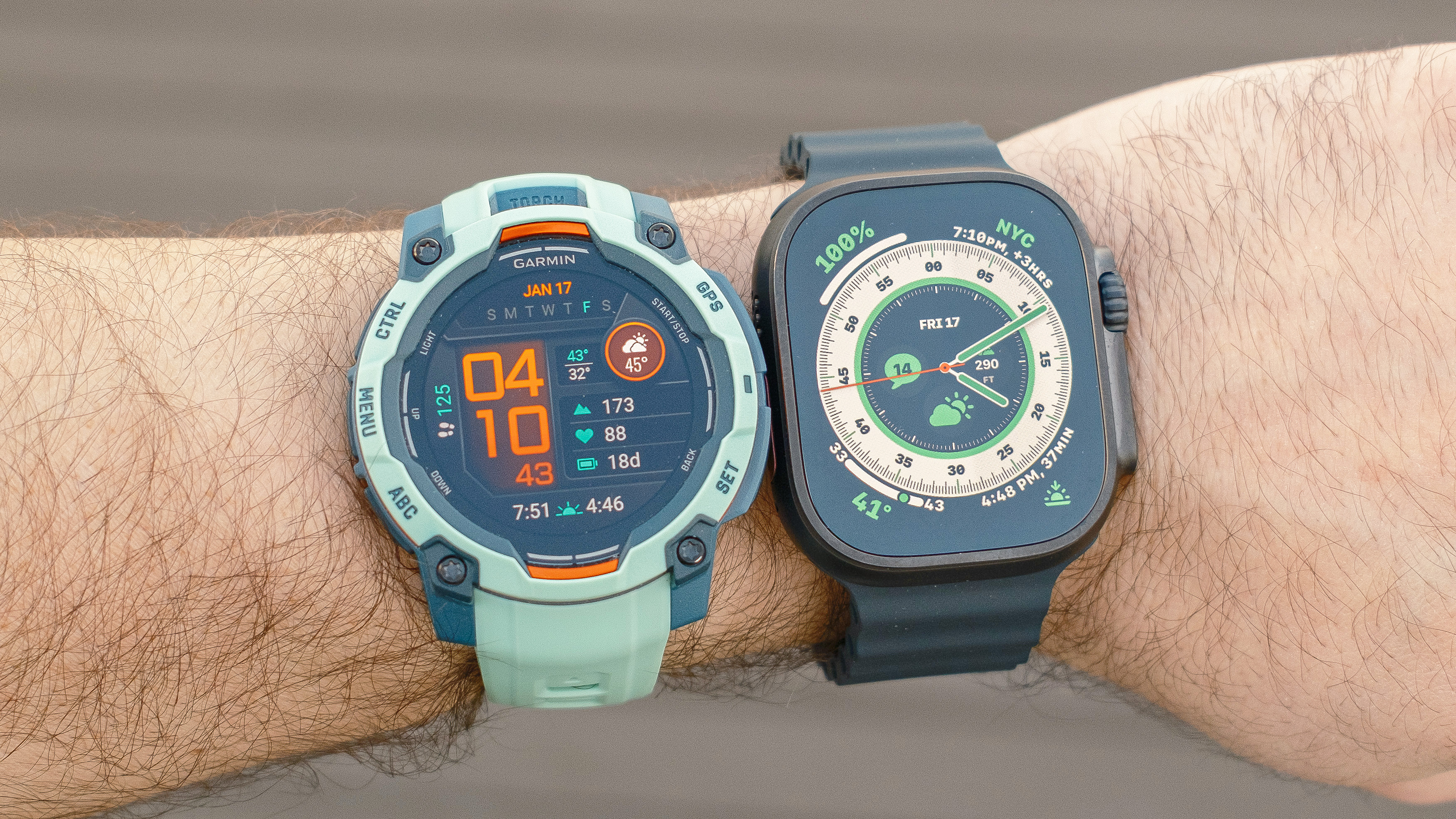
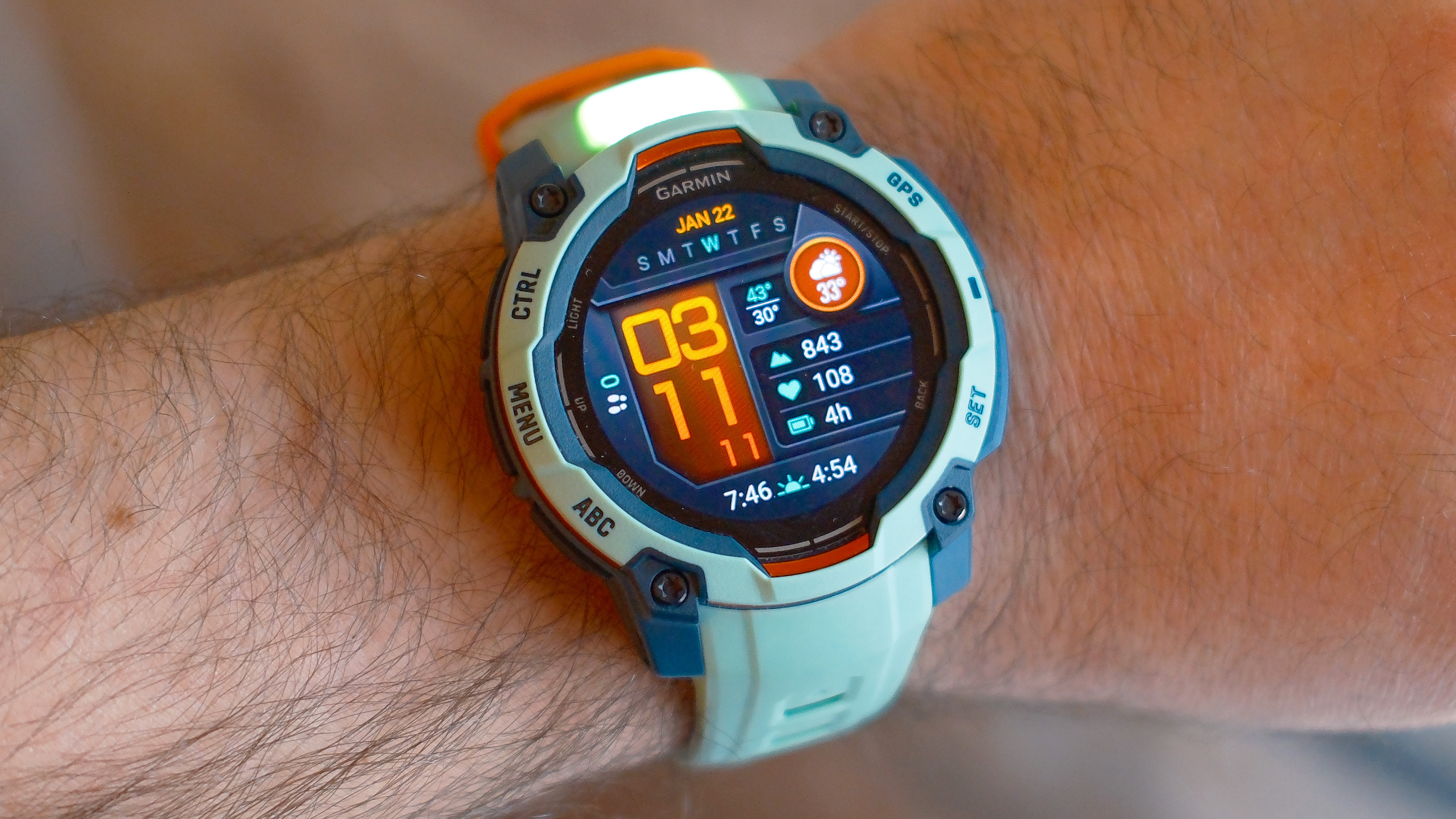
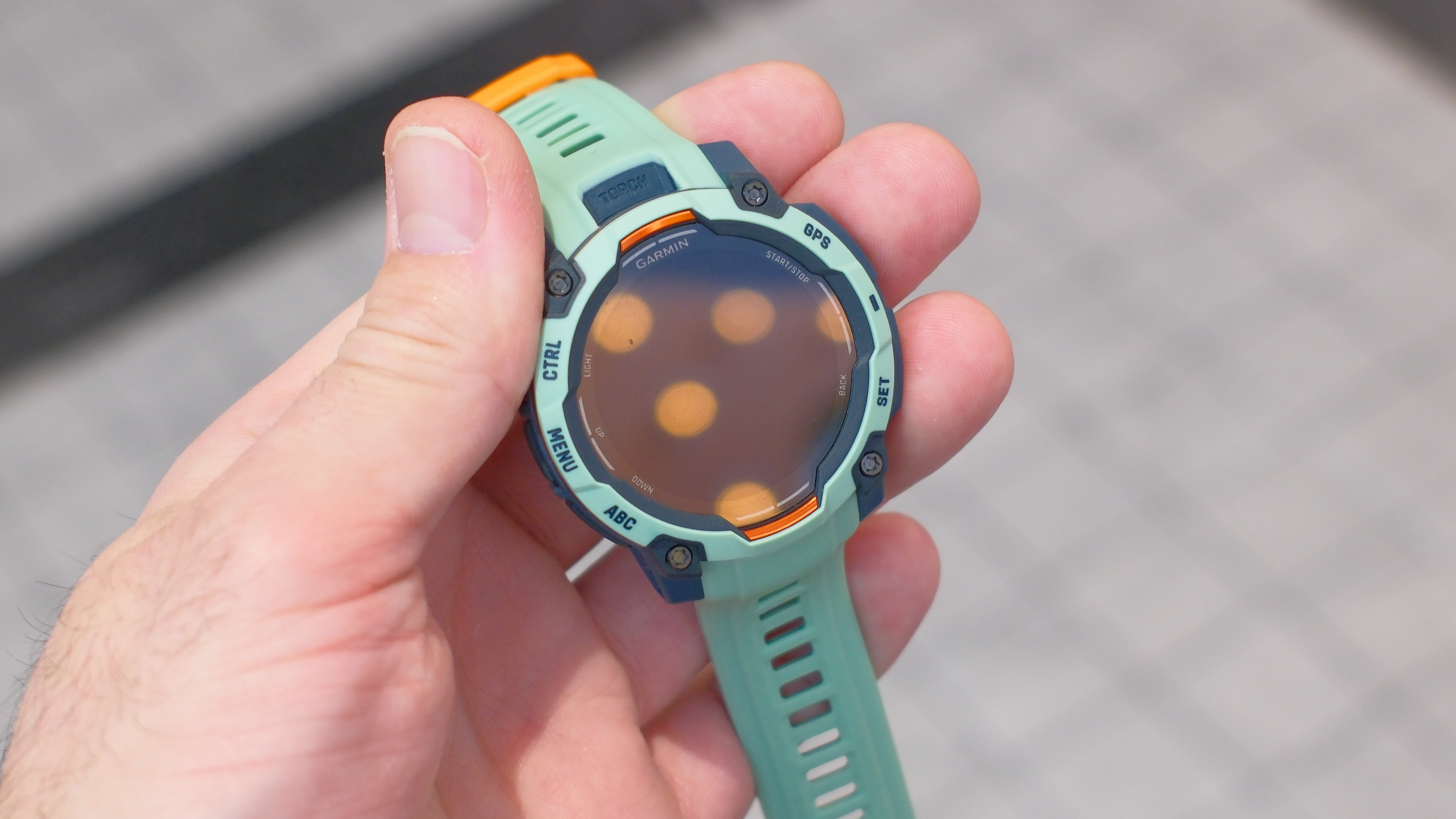
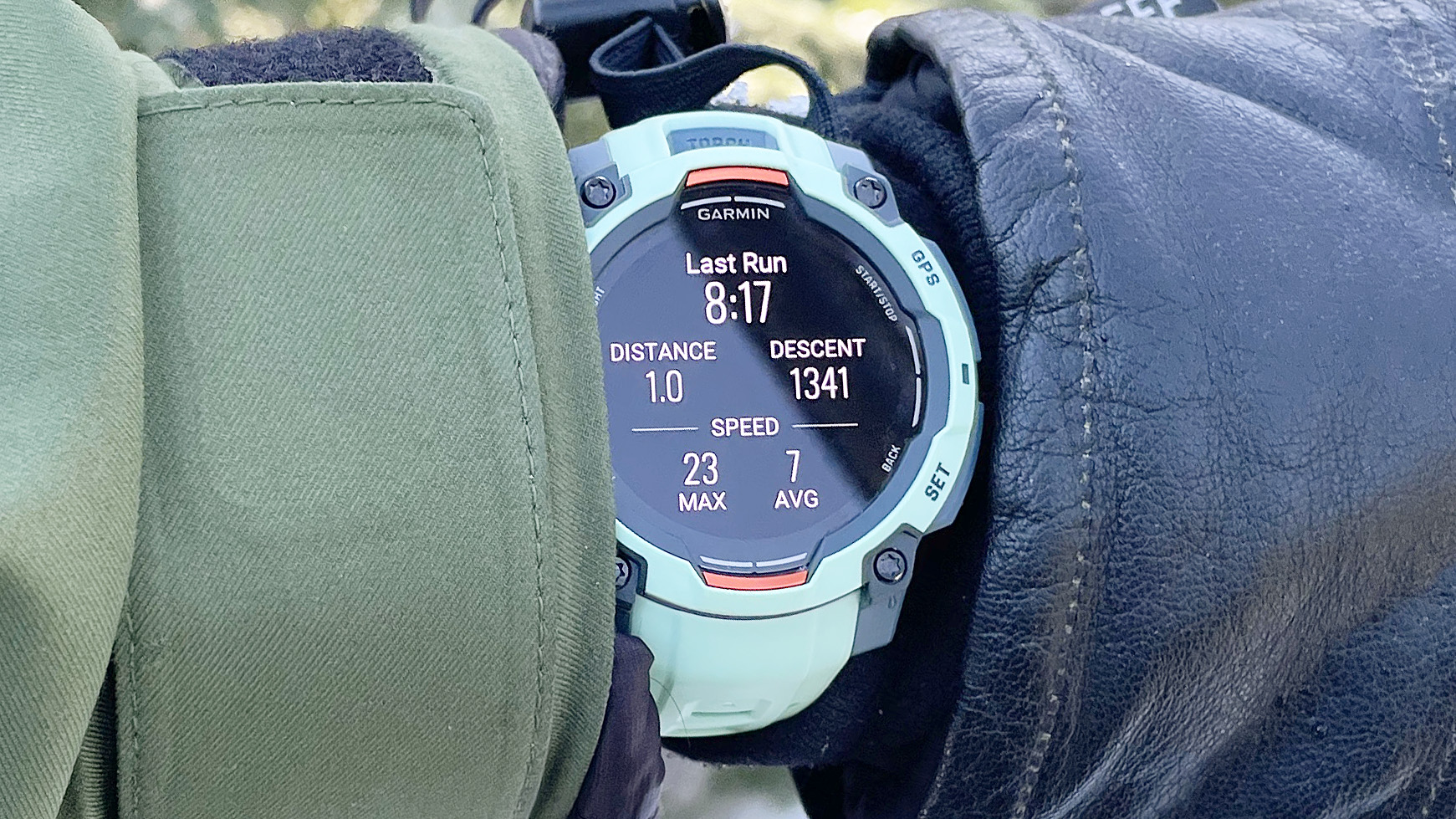
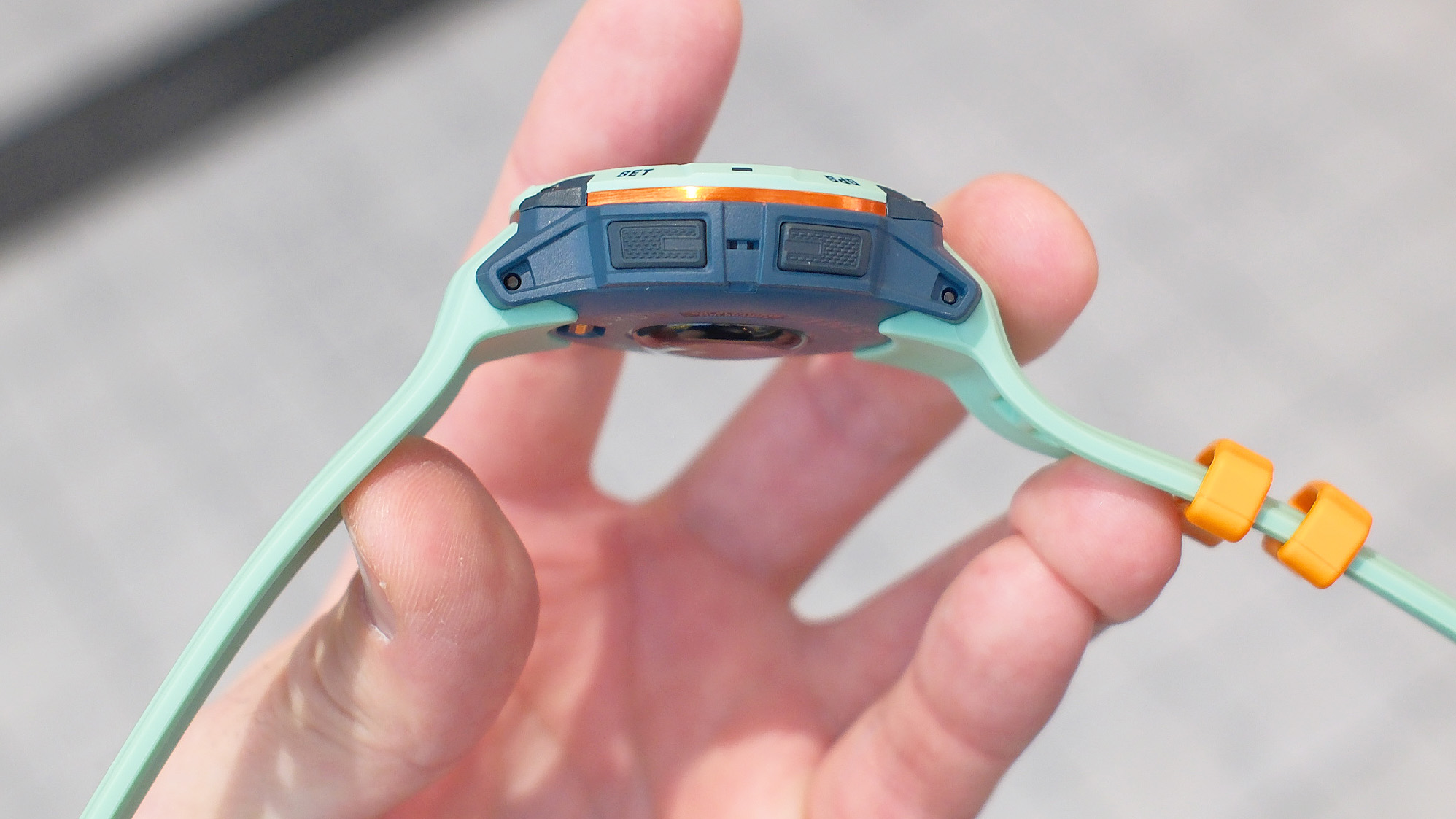
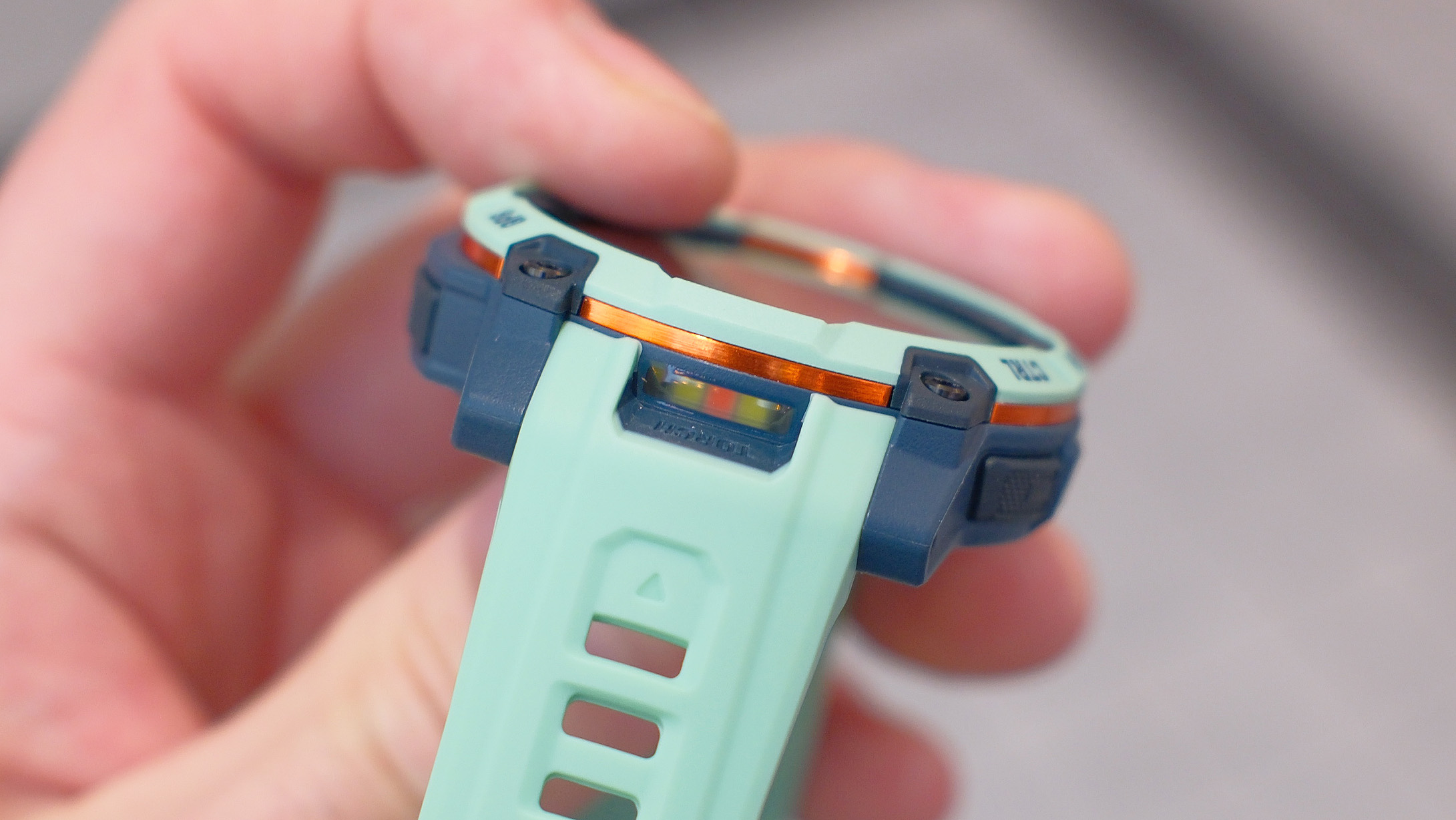
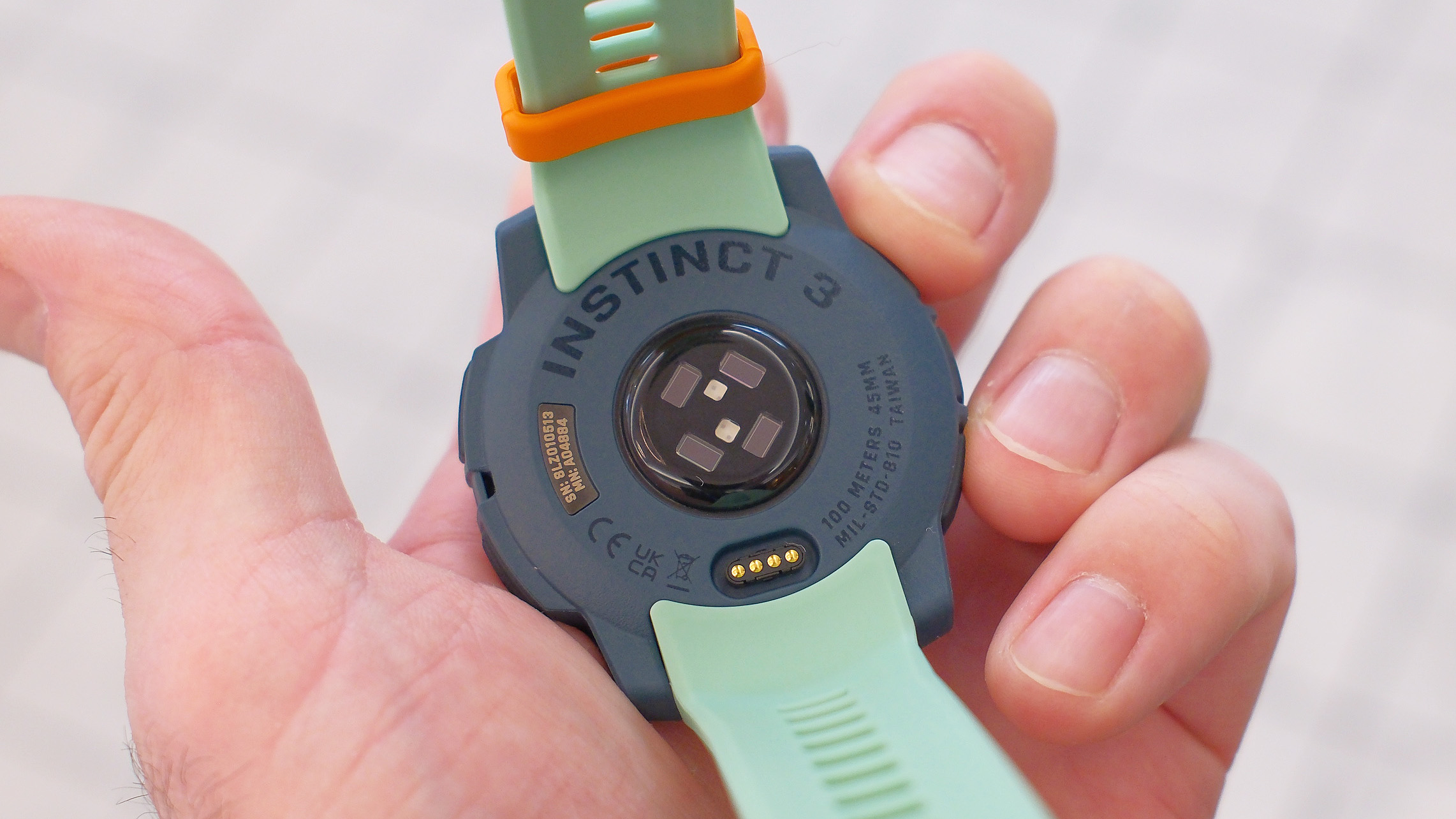
Specifications
Reasons to buy
Reasons to avoid
✅ You care about battery life: All of the Garmin Instinct 3 models last for weeks at a time in smartwatch mode without needing a recharge; the Solar models can technically last forever with enough sunlight.
✅ You're looking for an adventure watch: This watch is rugged and hardwearing, designed to cope with knocks and drops. It's also rated for 100 meters of water resistance, making it suitable for most watersports.
✅ You want something lightweight and stylish: It comes in two sizes and a wide variety of fun colors.
❌ You want access to offline maps: Unlike higher-end Garmins, including the Enduro 3 and Forerunner 965, the Instinct 3 doesn't support downloading and saving detailed maps for offline navigation.
❌ You want to download and save music to your watch: The Instinct 3 also doesn't support downloading and saving music to the device for offline listening.
❌ You care about smart features: The Instinct 3 offers few outside of NFC payments and mirrored smartphone notifications.
⌚ The Garmin Instinct 3 is a cheaper version of the Fenix 8 with most of the same features, including support for a huge range of outdoor activities, mind-blowing battery life and a rugged design. All that's missing, really, is support for downloading maps and music.
What you need to know
The Garmin Instinct 3 comes in both 45mm and 50mm and your choice of solar-powered charging or a comparably brighter, higher-resolution AMOLED screen (without solar). The Solar models can technically last forever with enough sunlight, while the AMOLED models should provide weeks of use before needing a charge-up. All models boast impressive GPS tracking, support for a huge range of workout types, 100 meters of water resistance and a supremely handy onboard LED 'torch' flashlight tucked into the bezel.
Design: The Instinct line has always boasted a rugged-meets-sporty design ethos and the third iteration is no exception. Reasonably lightweight and comfortable on the wrist, the latest model comes in 45mm and 50mm instead of 40mm and 45mm like its predecessor. However, a stripped-down version of the Instinct 3, dubbed the Instinct E, is available in 40mm.
There's no touchscreen, rather, the UI revolves around five physical buttons with different functions depending on how long you press them. These controls are customizable and though there's a bit of a learning curve to operating the watch, once you get your head around it and the buttons/shortcuts tailored to your liking, it's a pleasure to interact with.
This is the first Instinct model with an optional AMOLED screen. Compared to the MIP displays found in the Instinct 3 Solar editions and past Instinct models, AMOLED offers a more immersive visual experience. Put another way, these screens are easier to view in bright daylight than the older tech.
Battery life: In standard smartwatch mode, the Instinct 3 Solar models can easily surpass a month of use without needing a recharge. However, toss in roughly three hours of sunlight a day, and they can last forever. The AMOLED models, meanwhile, will last between two and three weeks in smartwatch mode before needing a juice-up.
Want to track an epic outdoor activity? The Solar models can keep tabs on your adventures for four to six days straight, depending on which size you choose, while the AMOLED models offer roughly 2.5 days of tracking for the 45mm model and 3.5 days for the 50mm option.
In addition to impressive battery life, the Instinct 3 is also quick to recharge; a full power-up can be accomplished in about two hours.
Training features: The Instinct 3 sticks with the same Elevate V4 heart sensor found in its predecessor as well as the Fenix 7, rather than the newer Elevate V5 sensor offered in the Fenix 8. Still, Instinct 3 offers many of Garmin's best training tools, including Body Battery, Training Readiness Score, in-depth sleep quality analysis, workout recovery time suggestions and blood oxygen saturation monitoring. However, there are no ECG readings.
Read our full review: Garmin Instinct 3
Test | Notes | How it stacks up |
|---|---|---|
Battery life | Unlimited (solar) | ★★★★★ |
Features | Body Battery, Vo2 max readings, SpO2, sleep tracking | ★★★★☆ |
Design | 0.9- and 1.1-inch MIP displays on Solar models, 1.2- and 1.3-inch screens on AMOLED models, 100 meters water resistance for all models | ★★★★☆ |
Display | 176 x 176 pixels MIP display (45mm & 50mm Solar), 390 x 390 pixel AMOLED (45mm AMOLED), 416 x 416 pixel AMOLED (50mm AMOLED) | ★★★☆☆ |
The best Garmin smartwatch
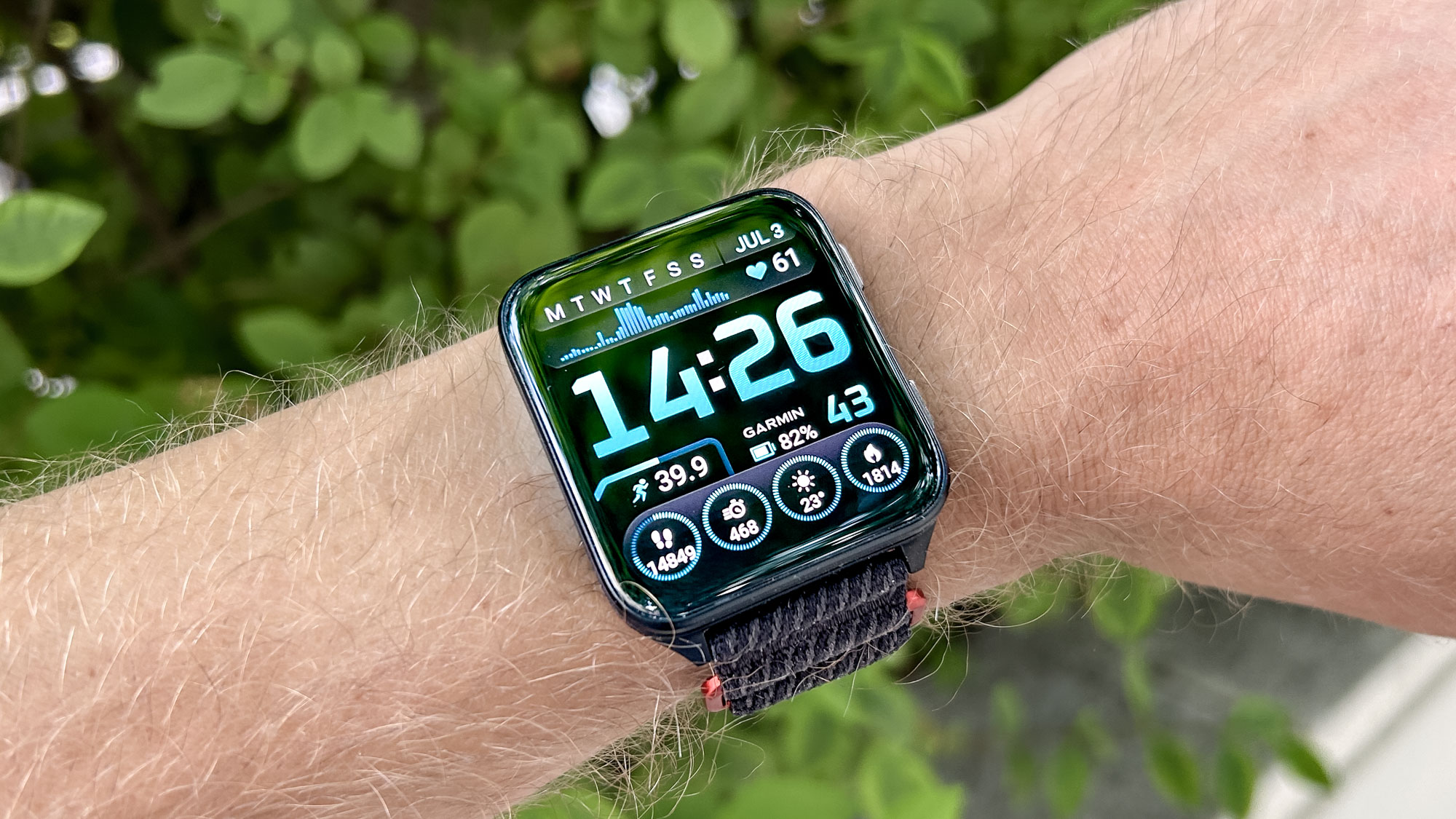
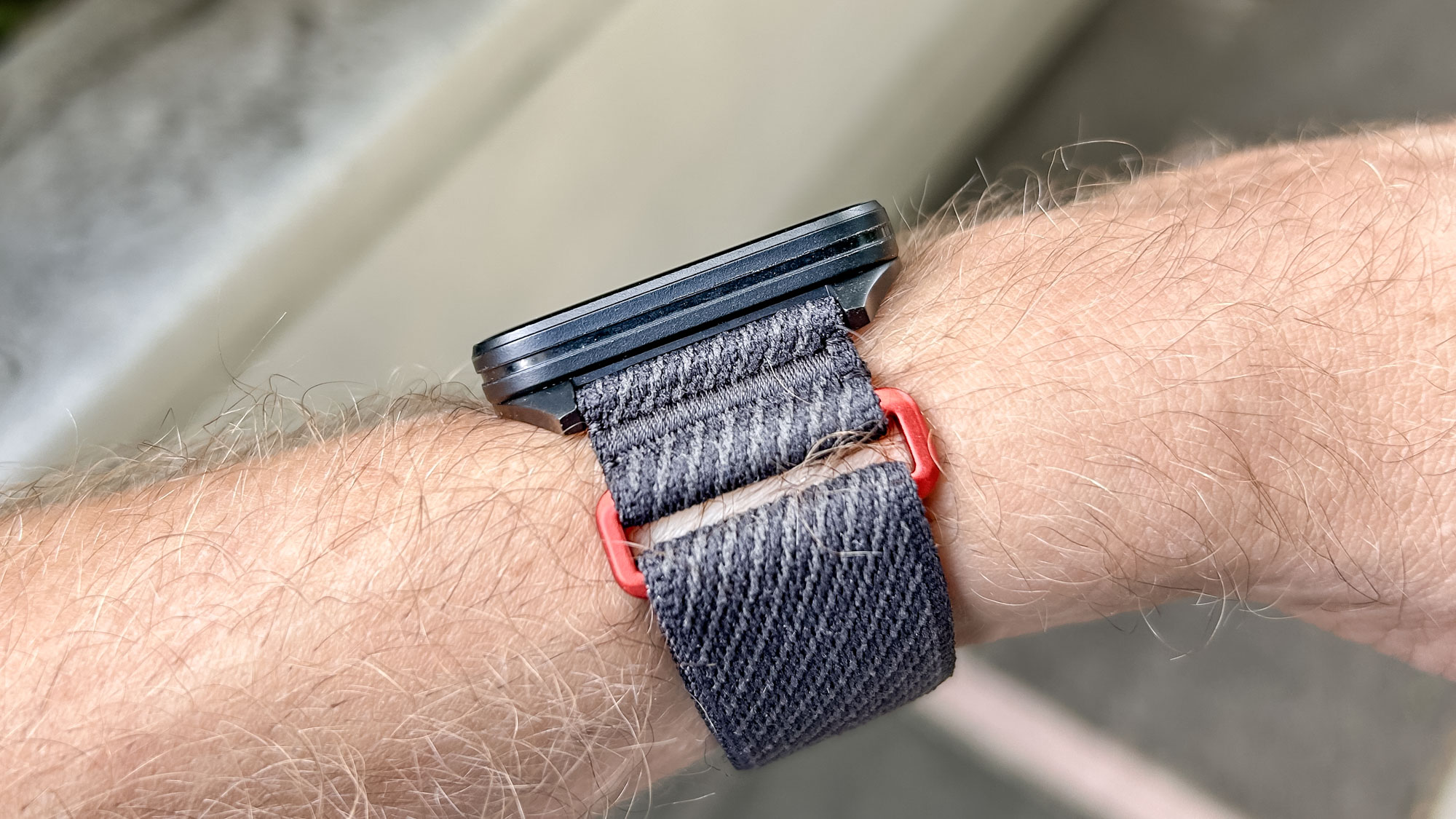
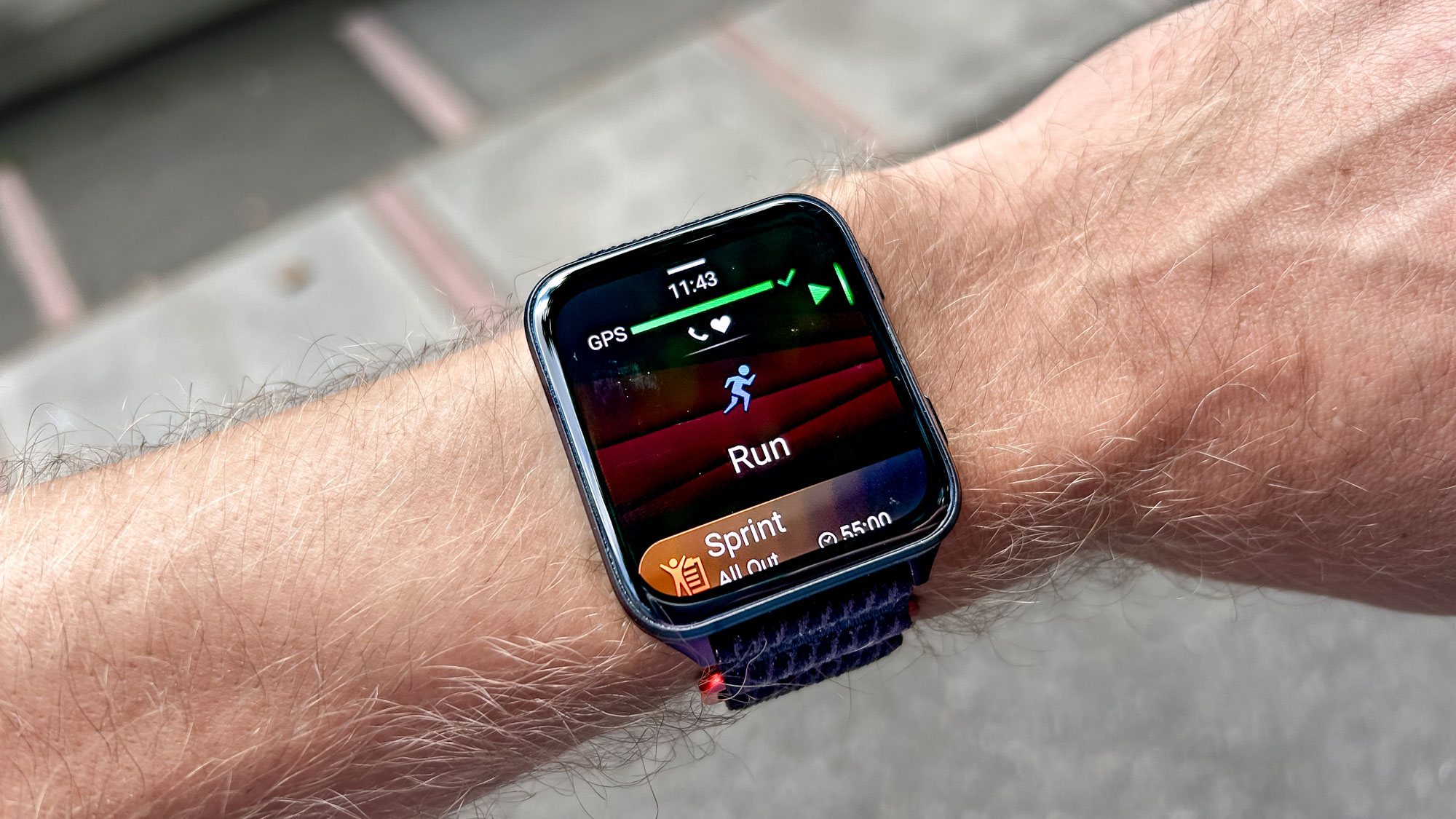
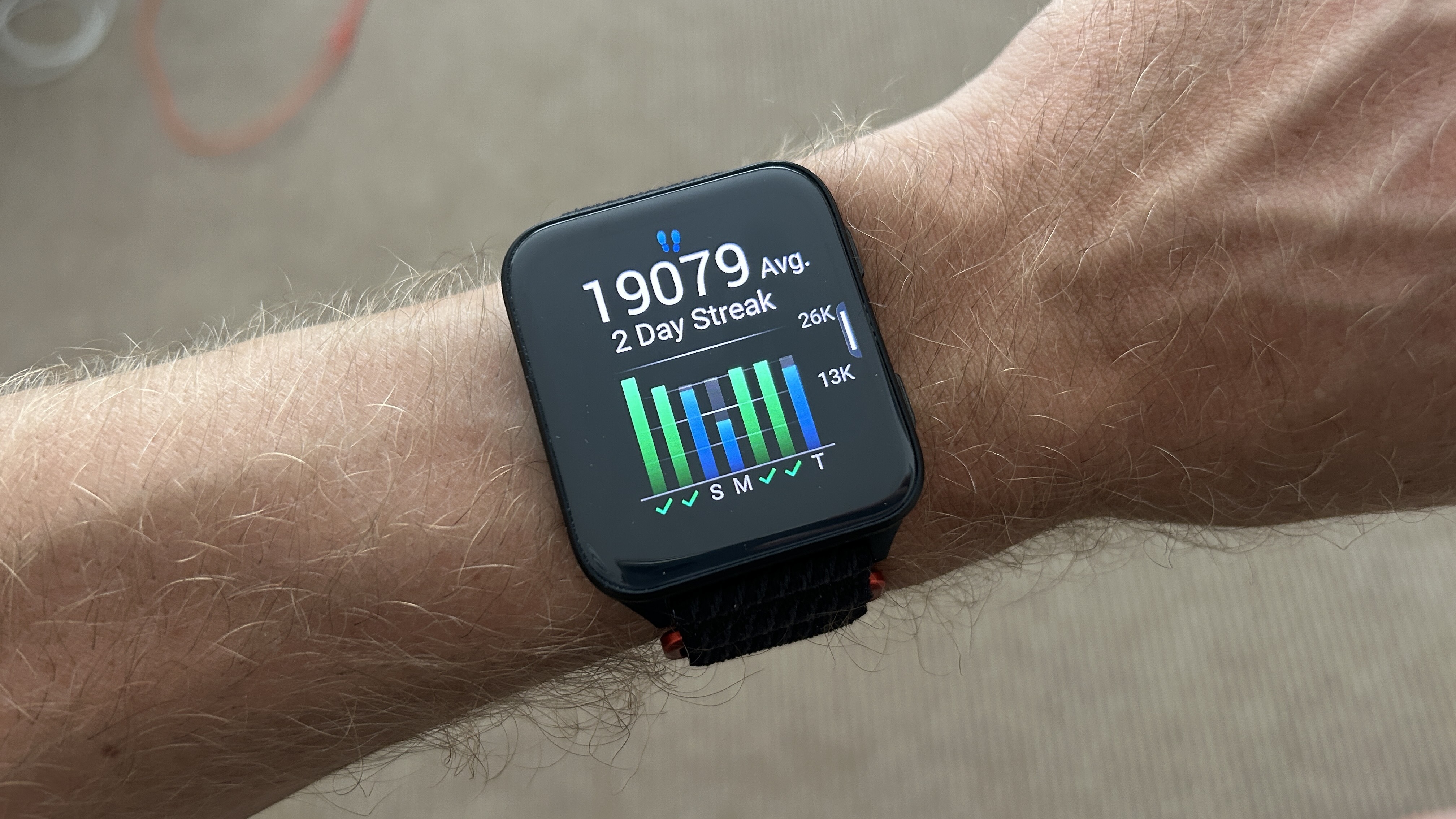
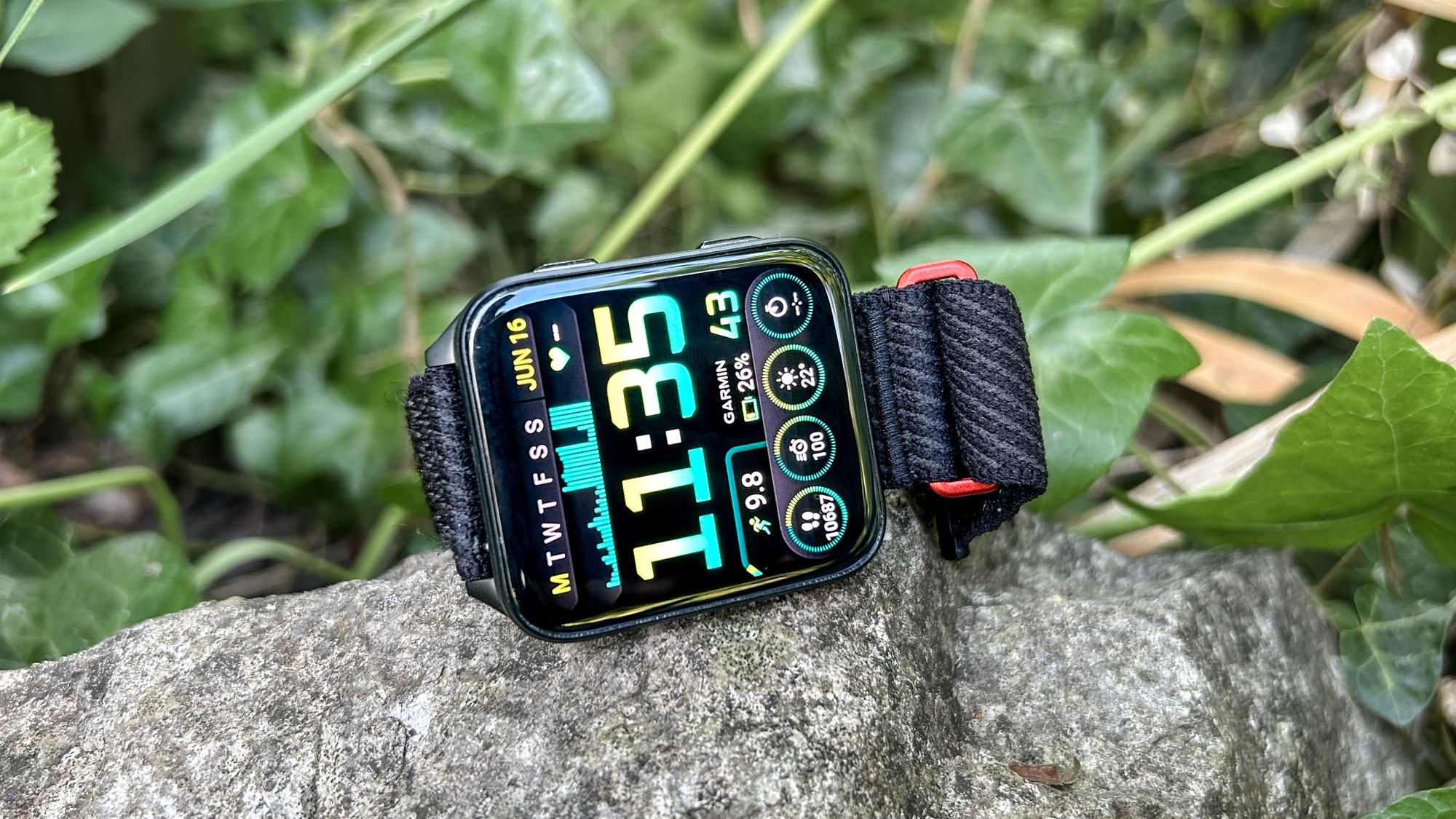
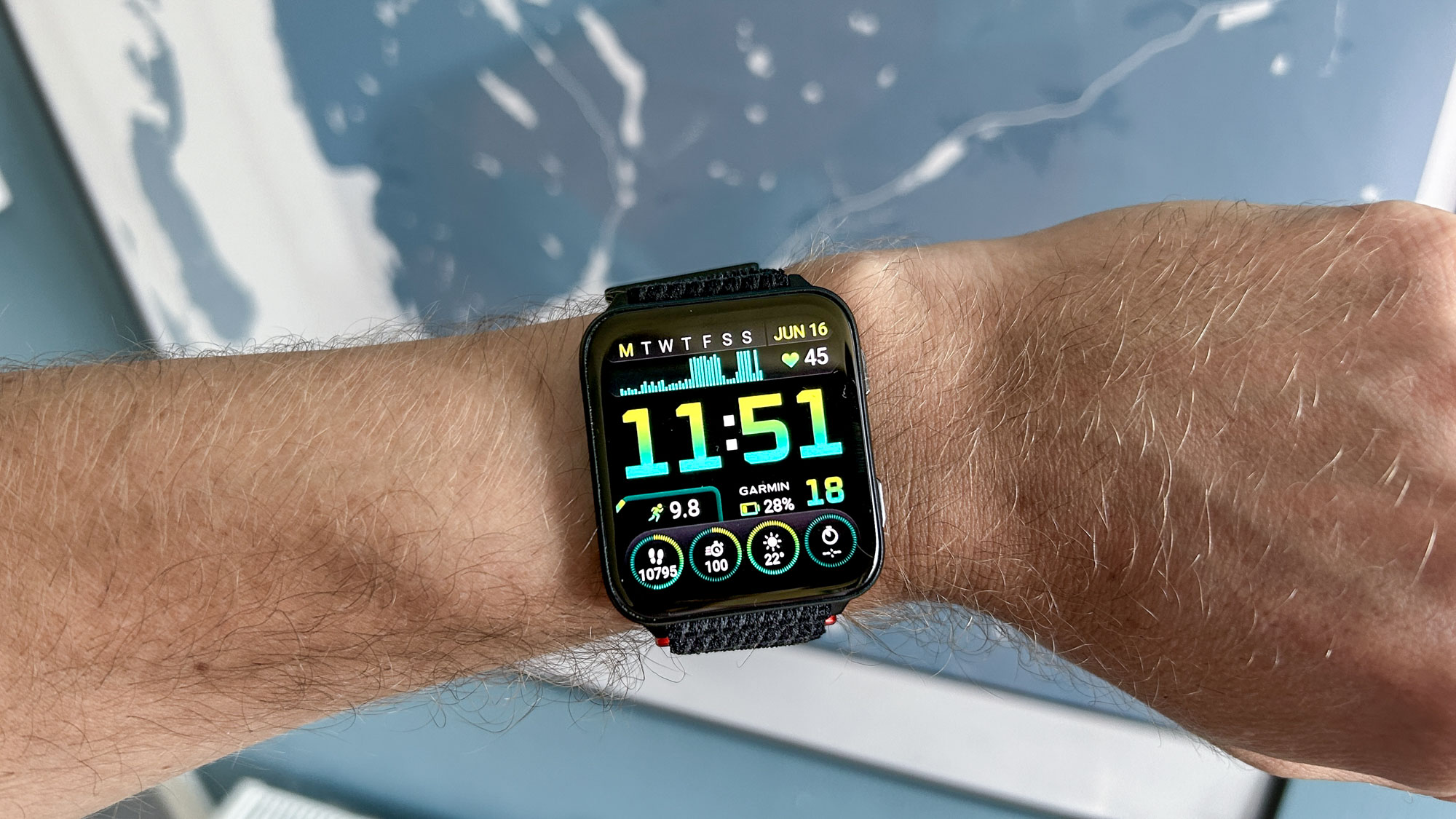
Specifications
Reasons to buy
Reasons to avoid
✅ You want Garmin’s biggest screen: The 2in AMOLED display on the Venu X1 is pretty special and the main reason to look at it over other Garmins.
✅ You like a lightweight watch: The Venu X1 weighs just 40g and is slimmer than any other sports watch I’ve tested, making it feel very light and comfortable to wear 24/7.
✅ You want something different: Most Garmins stick to a similar design scheme, and the Venu X1 stands out from the Forerunners and Fenix range thanks to its design.
❌ You need the most accurate GPS: Most of the time I didn’t notice the lack of mutli-band GPS, but it is an upgrade when running in city centers and it’s a shame it’s missing on the Venu X1.
❌ You need long battery life: The Venu X1 has the shortest battery life of any Garmin I’ve tested, which might be a dealbreaker for those used to long-lasting sports watches.
❌ You need cellular connectivity: The Venu X1 doesn’t have some key smart features that you can get on Apple and Android devices, including cellular connectivity, and the Connect IQ app store doesn’t have much in it beyond watch faces and data fields.
⌚ The Garmin Venu X1 has a fantastic design and most of Garmin’s best sports features, and its good looks make it a compelling alternative to the Forerunner and Fenix ranges.
What you need to know
The Venu X1 came out of nowhere to offer something different to the rest of Garmin’s range. It has most of the top sports features of watches like the Forerunner 970 and Fenix 8, in an eye-catching square design that’s very slim and has a huge AMOLED display that rivals the best smartwatches.
It’s also a genuinely sporty rival to the Forerunner 970 for those who love the look of the Venu X1, but it doesn’t offer as good battery life as most sports watches, and it’s missing multi-band GPS, a key sports feature that is available on all other top Garmins.
The Venu X1 has all of Garmin’s smart features, which include NFC payments, music storage and access to the limited range of apps in the ConnectIQ store. It doesn’t have cellular connectivity or as many smart features as devices like the Apple Watch Ultra 2 though, and is more of a smart sports watch than a true smartwatch.
Design: There are two standout elements to the Venu X1’s design. The first is the vast 2in AMOLED display, which is great for viewing maps and using the golf sports mode on the watch in particular. The second is how thin it is — at 7.9mm thick it’s much slimmer than watches like the Forerunner 970 and Apple Watch Ultra 2.
I love the design of the Venu X1 because of how light and comfortable it is on the wrist, and the fact it’s so thin means that the big screen doesn’t feel too much. It only has two buttons though, which means you rely on the touchscreen more than with other Garmins, which can be tricky when you have sweaty fingers during workouts.
Battery life: Big, bright AMOLED screens and slim cases don’t usually indicate long battery life, and that’s true of the Venu X1, which lasts just two days on a charge if you have the screen always-on. You can extend this battery life to a week or so with the screen set to raise-to-wake, but I found that even then workouts with GPS drain the battery rapidly.
Training features: What makes the Venu X1 such a compelling option is that its smartwatch-style looks are backed up by Garmin’s top sports features, including the latest ones introduced on the Forerunner 970 like running economy.
The Venu X1 also offers very accurate heart rate monitoring, but it does lack multi-band GPS, which can reduce its accuracy when running in tricky GPS areas like city centers in my experience. Aside from that, you get everything you get on the Forerunner 970, an array of sports features no true smartwatch can match.
Read our full review: Garmin Venu X1 review
Test | Notes | How it stacks up |
|---|---|---|
Battery life | Up to 8 days (watch mode), 16 hours (GPS) | ★★★☆☆ |
Features | Training Readiness, Training Status, Running Economy, Running Tolerance, Multisport modes, Chronic Training Load, Acute Load, Advanced mapping | ★★★★★ |
Design | 2in AMOLED screen, lightweight, 7.9mm thick, and 50m water resistance | ★★★★★ |
Display | 448 x 486 pixels AMOLED | ★★★★★ |
Also tested
At Tom's Guide, we test a lot of smartwatches, including nearly every new Garmin model that gets released. As a result, some models don't quite make the cut for this buying guide. Still, some of these close-but-no-cigar Garmins may be worthy of your consideration; find our favorite runners-up below.
Garmin Enduro 3
The Enduro 3 offers incredible battery life thanks to its MIP display and solar panels and is a great option for adventurers who don't want an AMOLED watch, but doesn't have the connectivity you get on the Fenix 8 Pro.
Read more about the Garmin Enduro 3
Garmin Lily 2
The Garmin Lily 2 is the non-GPS version of the Lily 2 Active featured above. The standard model is $50 cheaper but doesn't sport onboard GPS or physical buttons. The former means you'll need to carry a phone with you for location-tracking data. If you don't mind those two factors then the Lily 2 is a more sensible buy than the pricier Active.
Read more about the Garmin Lily 2
Garmin Venu 3
The Garmin Venu 3 is the brand's take on a hybrid fitness and lifestyle-focused smartwatch boasting solid training tools and a short but respectable list of handy smart features including support for popular voice assistants, like Google Assistant and Siri, onboard storage for music and the ability to make NFC payments. However, a lack of LTE and support for third-party apps limits its smartwatch appeal.
How to choose the best Garmin watch for you
Because Garmin watches span a wide range of prices and features, it’s important to identify which are most important to you within your budget.
Battery Life
Most of Garmin’s watches have excellent battery life, but some are better than others. Some Garmin watches, like the Fenix 8, Enduro 3 and Instinct 3 (Solar) have solar charging options, increasing the battery life of the watch. If you plan to spend extended periods of time outdoors, choose your watch accordingly.
Training features
Most of Garmin’s watches have excellent training features but pay attention to the metrics that matter to you. In addition to standard metrics, some models like the Garmin Forerunner 965 also track heat and altitude, which are key for planning the impact of outdoor workouts. Others, like the Garmin Approach S62, offer in-depth golf training, too.
GPS
Garmin is known for its GPS technology, so it’s no surprise that nearly all Garmin watches have excellent GPS features.
Smartwatch features
Some Garmin models have more smartwatch features than others. The Venu 3, Garmin Forerunner 165, 265 and Forerunner 965 all boast touch-sensitive AMOLED displays, which provide a premium experience, especially when wearing them 24/7.
Onboard music
Not all Garmin watches support onboard music with built-in storage. For athletes who want to bring music on their go in their workouts, you’ll want a tracker that lets you leave your phone behind. Some models, like Forerunner 165, come with optional music storage for an extra $50. Others, like the Venu 3 offer the feature standard.
Price
There’s a good range of Garmin watch prices for every budget. For under $150, the Forerunner 55 is a good value, as you get access to Garmin Coach and all of Garmin’s other training features. On the other hand, you can spend up to $1,149 on the Fenix 8 in 51mm. Most models, however, fall between $200 and $500. If you want to save a little extra on your purchase, have a look at our Garmin coupon codes page to see the latest discounts.
How we test Garmin watches
We test the best Garmin watch models by strapping them to our wrists and wearing them 24/7 for several weeks. During this time, we're assessing every aspect of the device, including design and comfort, battery life claims, tracking accuracy, and any new features or training tools.
When it comes to comfort, some watches are pretty bulky, which means they may fit awkwardly on smaller wrists or prove burdensome for all-day wear. Design-wise, we're also paying attention to how the watch holds up to the daily bumps and bruises of daily life, including encounters with water.
For athletes, a bright and easy-to-read screen is a must for checking stats while on the go, something we take into great account. Ease of use additionally gets consideration; are there physical buttons, a touchscreen, or a combo of both? We prefer the latter.
When it comes to assessing fitness tracking features, we're all about putting the best Garmin watch models to the test against other proven devices. Sometimes that involves walking thousands of steps with a popular tracker on either wrist, like when we pitted the Garmin Forerunner 165 vs. the Polar Grit X2 Pro or when the Garmin Forerunner 265 took on the Apple Watch Ultra 2.
During these head-to-head showdowns, we're not only comparing fitness stats from each watch but GPS tracking accuracy and battery efficiency as well. Post-workout, we dive into Garmin's training and recovery tools. Are the insights useful and actionable, or are they just stating the obvious?
The same approach is taken when assessing sleep-tracking data. Do the results correlate with our perceived sleep quality? Finally, we try out any of the device's extra features, like mobile payments, onboard music storage, downloadable maps, and voice support.
Once testing wraps up, all of this information, which includes a mix of qualitative impressions and quantitative comparisons gets condensed down into an official Tom's Guide Garmin watch review, at which point, the device is considered for inclusion in this buying guide.
FAQs
Do all Garmin watches have GPS?
No, not all Garmin Watch models have onboard GPS, but most do. All of the models in our buying guide boast GPS, which means that you won't need to carry a paired phone with you for location-tracking data.
Garmin models that don't have GPS include the standard Lily 2 and the Vivosmart 5, which is more of a fitness tracker than a smartwatch.
Which Garmin watch models have maps?
Only Garmin's higher-end watch models offer the ability to download and manage maps to your device for offline use. These include the Garmin Forerunner 965 (and 955), Enduro 3 (and Enduro 2), Fenix 8 (and Fenix 7) and the Garmin Epix series.
Which Garmin watch models can answer a phone call or text?
A small selection of Garmin watches have built-in microphones and speakers, allowing you to take calls from the wrist via a Bluetooth-paired smartphone or dictate a message. These include the Garmin Venu 2 and 3, as well as the Garmin Fenix 8.
Some Garmin models offer the ability to send a quick reply from the wrist by selecting from a list of pre-written messages. However, this feature only works with Android devices.
Which Garmin watch is best for navigation?
There are two types of navigation available in Garmin's range. Top-end models like the Fenix 8 and Forerunner 965 have offline maps and can create routes for you on the fly, or reroute you if you go off course.
Cheaper models like the Forerunner 165 and Garmin Instinct 3 offer breadcrumb navigation, with turn-by-turn instructions and a line and pointer to keep you on track, but no actual maps.
Garmin's maps are the best navigation tool available on any sports watch and it's worth investing in a watch with them if that's a priority for you. If you're on a budget, then older watches with maps like the Garmin Epix 2 and Garmin Forerunner 955 are often in sales.
If possible, we recommend getting an AMOLED Garmin if you're going to use the maps a lot, as they are clearer on the AMOLED display, though this does reduce battery life compared to an MIP Garmin.
Which Garmin watch is the most smartwatch like?
The Garmin Venu 3 is the brand's most smartwatch-like model. However, it doesn't offer nearly as many smart features or apps as alternatives from Apple, Google or Samsung. And there's no option for LTE connectivity. The smartwatch features it does have include support for virtual voice assistants and phones calls, onboard storage for music and NFC for mobile payments.
Is Garmin better than Apple?
Garmin and Apple watches have a lot of similar features, but excel in different areas. Garmin watches are better for battery life, sports tracking, training analysis and navigation, while Apple watches excel on design, fitness tracking and smart features in particular. Both are great options for sports tracking, but which is better will depend on your priorities.
How do I download Garmin Connect?
You'll need to download the Garmin Connect App to sync your watch to your phone. It's available on both Android and iOS. Once you've downloaded the app and signed up, you can begin the pairing process.
The Garmin Connect app lets you see all your data at a glance in an easy-to-read format. Depending on your tracker, it'll give you deeper insights, such as your body battery (based on your sleep data) and your fitness age. There are also challenges and in-depth sleep reports for you to keep an eye on.
Additionally, depending on your Garmin model, you'll be able to use the Garmin Connect app to use Garmin Coach to download running and cycling training plans and upload them directly to your watch. Garmin Coach lives under the 'training' tab in the app and features loads of options to suit all abilities and goals.
Check out our guide on how to use Garmin Connect here, as well as our guide to how to use the Body Battery feature on your Garmin watch.
Get instant access to breaking news, the hottest reviews, great deals and helpful tips.

Nick Harris-Fry is an experienced health and fitness journalist, writing professionally since 2012. He spent nine years working on the Coach magazine and website before moving to the fitness team at Tom’s Guide in 2024. Nick is a keen runner and also the founder of YouTube channel The Run Testers, which specialises in reviewing running shoes, watches, headphones and other gear.
Nick ran his first marathon in 2016 and became obsessed with the sport. He now has PBs of 2hr 25min for the marathon and 15min 30sec for 5K. Nick is also a qualified Run Leader in the UK.
Nick is an established expert in the fitness area and along with writing for many publications, including Live Science, Expert Reviews, Wareable, Coach and Get Sweat Go, he has been quoted on The Guardian and The Independent.
- Jane McGuireFitness editor
- Dan BracagliaSenior Writer, Fitness & Wearables
